 Leading Blog | Posts by Category |
 Leading Blog | Posts by Category |
04.15.24

How To Rearrange Your Brain for Success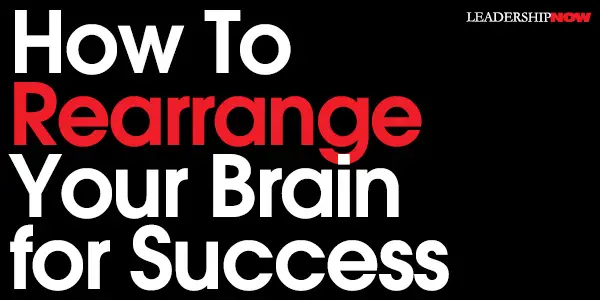
BRAD JACOBS, CEO and serial entrepreneur—United Rentals and XPO Logistics—has made and kept a few billion dollars and aims to show us how to do the same in How to Make a Few Billion Dollars. The most valuable part of the book for me was the first chapter on transforming how you use your mind. Here are ten ideas for rearranging your brain to achieve “big goals in turbulent environments where conventional thinking often fails.” Love He begins with love. Why? Love “has a lot to do with getting your brain in the right place to make good decisions. Fast-paced business environments swing between ups and downs, with many stressful interactions. Love is in an expansive emotional state that allows you to neutralize conflict and get everyone to a better place.” How do you get there? Through one-on-one gratitude conversations. Think about why other people deserve your gratitude and then sit down with them and let them know in a direct, personal manner. Expect Positive Outcomes Negative thoughts come to us quite naturally. The trick is not to let them control your thinking. Negative thoughts are often our knee-jerk reaction to a given situation. We need to acknowledge them and then reframe them in a positive light. Jacobs provides an instructive example from his family life: When we put our kids to bed at night, we’d ask them the same question many parents do: How was your day? Sometimes, we’d hear the good, sometimes the bad, and sometimes the ugly. Then we met Martin Seligman, and he suggested asking children a slightly different question: What was the happiest moment of your day? We tried it. The change was dramatic—no bad, no ugly, just the good. And maybe because our kids knew the question was coming, they kept their antennas up all day with the expectation that the happiest moment could happen at any time. What an easy create an optimistic frame of mind! What was the best part of your day? Give Yourself a Break Stop expecting unrealistic perfection from yourself and others. We sabotage ourselves all the time. Our thought processes are full of all sorts of cognitive distortions, from catastrophizing (thinking of small problems as enormous impediments) to perfectionism, where anything less than perfect execution causes intense frustration. Another cognitive distortion is dichotomous thinking (having rigid or “all-or-nothing” views). By learning to recognize these thought patterns and course-correcting accordingly, I’ve spared myself a lot of trouble. I learned, for example, to turn my internal chatter to my advantage by reframing negative thoughts as useful data rather than objective reality. If we understand that mistakes are inevitable, it will be a lot easier to “maintain your mental equilibrium as you pursue your big goals.” Expand the Possible Meditation, daydreaming, or thought experiments (the German term gedankenexperiments) can change how we relate to the world. During this time of mental calm, we can often find the best solutions, rejuvenate and become creative. Daydreaming exercises remind me that positive emotions matter, especially in chaotic business environments. When my energy is low, my favorite technique to rejuvenate and unleash creativity is to close my eyes and allow my attention to gently float in my brain. Embrace the Problem Jacobs’ mentor told him early on in his twenties as he unloaded on him with his problems, “Look, Brad, if you want to make money in the business world, You need to get used to problems, because that’s what business is. It’s actually about finding problems, embracing and even enjoying them because each problem is an opportunity to remove an obstacle and get closer to success.” Problems are an asset. The bigger your ambition, the bigger your problems. “If your initial reaction to a major setback is overwhelming frustration, that’s understandable, but it’s also counterproductive. Once you’re over that moment, pivot toward success: ‘Great! This is an opportunity for me to create a lot of value. If I can just figure out how to solve this problem, I’ll be much closer to my goal.’” Acknowledge You’re Not Perfect There are three impediments to effective leadership:
Accept your imperfections and learn from them. Cut your losses, adapt, and improve. “If you resist embracing an imperfect situation today, you might lose the opportunity to capitalize on it tomorrow.” Practical Radical Acceptance If you accept your own imperfections, you must also accept the world as it is, not as you wish it to be. Win or lose, focus on the best thing to do right now. “Radical acceptance quiets the noise created by yesterday’s decisions and today’s wishful thinking. It allows you to make a logical, forward-looking decision based on what’s likely to happen next—that and risk management are the big, relevant considerations.” Leave Judgment at the Door “The path to radical acceptance begins with non-judgmental concentration.” It allows you to focus on the issue at hand. “Non-judgmental concentration trains your brain to realize that the people and things in your life don’t exist relative to you; they simply exist. If you can take yourself out of the equation, you’ll have a much clearer view. Uncluttered by judgmentalism, you can work more efficiently; because you won’t be as distracted, and you can think more objectively, too. Think Huge To win huge, you have to think huge. “Your goals should be bigger than what you currently think you accomplish, because that can actually help you achieve those goals.” Visualize and be specific about what and when. Stay Humble Arrogance keeps you from growing—advancing. “Thinking you know it all is a trap, because you don’t—at least I don’t. If you stay humble, you’ll keep advancing.” That’s how you rearrange your brain for success. In subsequent chapters, Jacobs how to spot major trends, mergers and acquisitions (of which he has led about 500), building a team, competition, and more. I wrote this book for people who want to work their tails off, outsmart the competition, put their customers on a pedestal, and make a lot of money for their families. These goals require creativity and an enthusiasm for change—qualities at the heart of entrepreneurship. You can foster this in any size organization, whether you’re the owner of a family business or the CEO of a multibillion-dollar company to create its next billion dollars. 
Posted by Michael McKinney at 07:16 AM
08.25.23

The Art of Clear Thinking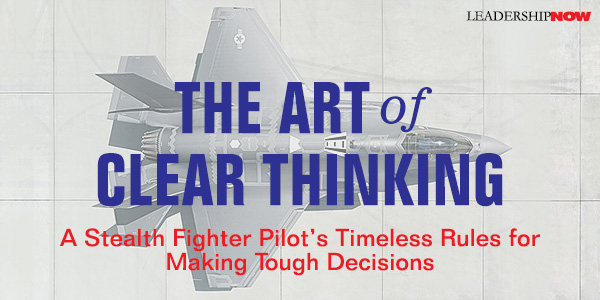
FIGHTER PILOTS must make thousands of decisions, often with incomplete information during each flight. U.S. Air Force fighter pilot and Chief of Training Systems Hasard Lee helped develop a program to boost pilots’ critical thinking skills and mental toughness to skew the odds in their favor when making these critical decisions. He passes the lessons learned on to us in The Art of Clear Thinking. Understanding how our decisions are made and how they can be improved going forward is essential with high-stakes decisions, but it is also important in our business and personal lives. The right approach to decision-making can save us a lot of regret down the road. He organizes his experience and training into a concept they call the ACE Helix. It has three parts: Access, Choose, and Execute. It is designed to bring out the best options while remaining flexible in ever-changing circumstances. 1. Assess the Problem Lee spends a lot of time explaining this step as the foundation for the success of the other two steps. “Developing a proper understanding of the problem is the first step to solving it. Our instinct is often to bypass this critical step and begin acting.” If we aren’t solving the right problem, we can make the right decision. It is important to keep the big picture in mind and not focus on just one piece of information. This is the ability to “make sense of a chaotic environment while simplifying and structuring information. This requires judgment, and judgment requires non-linear thinking. Often, our actions don’t result in a single outcome. Instead, they can lead to outsized outcomes that go beyond our imagination. They are non-linear outcomes. “For a multitude of reasons, people consistently fail to account for them, which often leads to a skewed assessment of the problem they’re facing and results in a poor decision.” These non-linear relationships are governed by power laws that can lead to exponentially greater or encompassing outcomes than we anticipated, which Lee explains in the book. “We become accustomed to how our actions are affecting a system, and then suddenly, the outcome is much different from what we were expecting. It helps if we have a broad understanding of the probable consequences of our decisions. We can adapt more quickly and accurately to changing circumstances. We can move our thinking beyond a narrow set of conditions. Lee talks about the approach they have during fighter training that all too often goes against the approach we have and certainly have experienced throughout our life. He says, “Our job wasn’t to weed them out but to coach them throughout each training event so that they could leave as the best possible pilots.” We tend to eliminate to try to cultivate the best and brightest. He adds, “We found that almost everything is coachable and correctable if identified early enough. Even supposedly intangible attributes, such as attitude, work ethic, and flying instinct, can be significantly improved if coached properly.” 2. Choose the Correct Course of Action To find the best solution, simplify. They use a technique called fast-forecasting. It is designed to build a mental model of the problem focusing on the few variables, due to strong power laws, that drive the system. This allows you to quickly approximate a ballpark solution. “We’re starting with the big-picture concept and slowly adding in detail until we have a good enough resolution to make a decision.” The key to fast-forecasting is to not get overwhelmed by the details—logic and reason are what drive the technique. Precision is often the enemy of conceptual thinking. What we’re trying to do is bring to bear the mental framework that we’ve accumulated over our lifetimes to estimate the expected value of a decision. If we instead make the problem overly complex, we lose the ability to quickly manipulate the relevant information through the lens of our concepts, principles, heuristics, and facts. Lee writes, “Creativity is one of the few resources that can provide an exponential advantage to those who are able to harness it.” Encourage creative decision-making with an effects-based approach. Start with the desired outcomes and work backward. “Breaking down the requirement into effects needed gives us at least an opportunity to explore alternative solutions.” Our desire to quickly find an answer or solution can lead us to jump to a solution that we are familiar with that might have worked in the past but is not really relevant to the current circumstance. 3. Execute Good execution requires the management of stress and, emotional control – and resilience in the face of failure. “While stress exposure can slightly increase performance for simple, well-rehearsed tasks, it severely reduces performance for tasks that require complex or flexible thinking.” Mental toughness is a skill that can be learned and improved. In fighter training, they incorporate a number of concepts into their training. Preparation is key. Mental toughness needs to be practiced until it is a subconscious reflex. They also include focus-based training. “The key to maximizing our mental resources is to focus only on what we have control over, which is the next decision to make.” Part of the training involves systematically building confidence. Confidence is not something you have, or you don’t. “Confidence is a skill that can be improved, primarily through our internal dialogue—how we talk to ourselves.” Perfectionism and focusing on our mistakes creates self-doubt, which is detrimental to high-stakes decision-making. Trainees are taught to reframe and replace negative self-talk with a successful counterexample from their past. In stressful and uncertain moments, it is important to keep your priorities your priorities. Focus on and prioritize what is important. “If there isn’t a clear vision, our minds will default toward urgent tasks.” At some point, you have to be decisive. You’ll never make the perfect decision. You can remove all uncertainty from your decision-making. When making decisions, “we’re just trying to remove the choices that are clearly not optimal.” Lee says that “when there are multiple seemingly equal choices,” he has found that “going with the riskiest viable option usually provides the greater return in value. Most people hate uncertainty, particularly when it’s combined with risk. As humans, we are biologically programmed to overestimate risk. If you’re able to overcome that mental hurdle, it becomes easy to differentiate yourself and greatly increase your odds of success.” The Art of Clear Thinking is full of great stories to illuminate the concepts and makes this business book read like a gripping novel. He shares a lot of information, so you will need to go back and reflect on how it can best be applied to your tough decisions. 
Posted by Michael McKinney at 04:39 PM
07.07.23

Learning to Manage the Map Paradox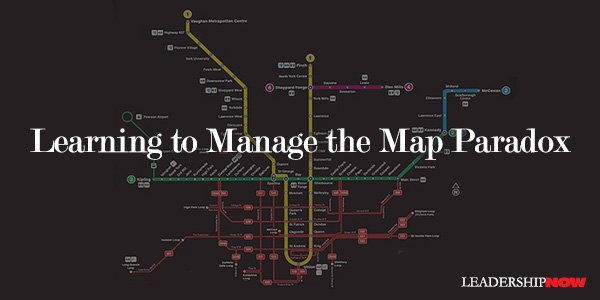
WE ALL HAVE mental maps that we use to explain the world as we experience it. They also provide us with a guide to our actions. But here’s the thing. These mental maps are based on yesterday. Donald Sull calls it the Map Paradox. In The Upside of Turbulence, he writes, “In a turbulent world, people must make long-term commitments based on a mental map they know to be flawed. The paradox arises in any situation where progress requires both long-term commitments from many people and adaptation to changing circumstances.” All mental maps are static representations of a shifting situation, simplifications of a complex world made without the benefit of knowledge that will only emerge in the future. They remain always and everywhere provisional, subject to revision or rejection in light of new information. The paradox of the map demands a delicate balance between commitment and revision, stability and flexibility. Striking the balance is difficult, but possible. Of course, mental maps come in all varieties. There are mental maps that are based on values that anchor us no matter what the circumstances present us with. We all possess personal mental maps that are based on the interpretation of our experiences in life so far. These kinds of maps are often subject to revision as we grow, understand more, and gain new perspectives. All mental models are working hypotheses. Whether your mental maps are explicit or implicit, they all perform three specific functions: “They emphasize important categories, clarify relationships among variables, and suggest appropriate action.” Mental maps create biases. As we take our maps into the future—especially an uncertain future (as most futures are)—they are subject to revision when scrutinized under the light of tomorrow’s reality. Our working hypotheses “provide imperfect representations of a complex and fluid world.” The best way to avoid the Map Paradox is to continuously place your mental model up against models that are different from yours. Look for clues as to what does not support your view of the world. Consider a revolution of thought rather than simply rationalizing away the incongruities you find. Entrepreneurs often find themselves in the Map Paradox because once they build a mental model around their idea, they look for supporting information and fall prey to what they do not know. “A systematic study of three hundred start-ups found that persisting with the initial business plan was the best single predictor of failure one year after founding—nine of ten entrepreneurs who stuck to their initial business plan without revision failed.” Mental models are a necessary part of who we are. They help us to move efficiently through life, but we need to learn to manage them so we aren’t derailed by them in the reality of changing circumstances. 
Posted by Michael McKinney at 10:39 AM
05.12.23

Real-Time Leadership: Creating the Space Between Stimulus and Response to Make Wise Choices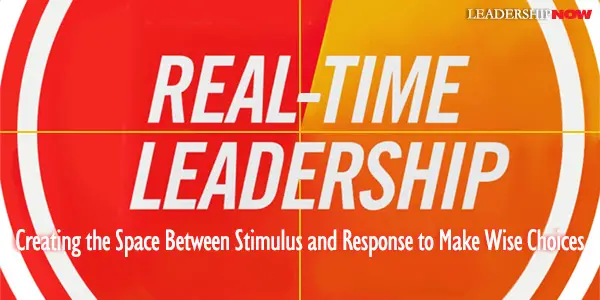
MAKING the most of every moment requires that we slow down and create some space between the challenges that are thrown at us and how we react. When faced with high-stakes challenges, we too often rely on our instincts and pattern recognition that we have developed through years of experience and plow ahead. When the challenge or opportunity is new, relying on our instincts can take us in the wrong direction. To master pivotal moments in real-time, David Noble and Carol Kauffman offer the M.O.V.E. framework in Real-Time Leadership: Find Your Winning Move When the Stakes Are High. Handling high-stakes, high-risk leadership challenges requires preparation and practice. The M.O.V.E. framework helps you to find, open, and use the space you create between the challenge and your response. The framework is described briefly this way: M: Be Mindfully Alert “Mindful Alertness in high-stakes situations means being exquisitely aware of what is needed from you as a leader at this exact moment, so you can lead in real time.” It means being “precise about and flexible with where you put your attention.” To be mindfully alert is about overcoming your instincts. If you automatically turn to your standard playbook you are not being mindfully alert. Being mindfully alert allows you to create space in real time. Every challenge you will face as a leader will involve all or some of what they call the Three Dimensions of Leadership: First is the External Dimension that refers to high-stakes that you want and need to achieve that come from your own aspirations or those that are handed to you. Next is the Internal Dimension is about your character, emotional regulation, values, and who you need to become as a leader to meet those external challenges, goals, and priorities. Finally, there is the Interpersonal Dimension is about how “to lead in the way others need, not how to lead in the way that you’d personally prefer. In any interaction, a leader must have multiple ways to respond to unlock the potential of others.” O: Generate Options Before we move into action, we increase our chance of success if we consider all of our options first. Those options revolve around four basic stances: Lean In (take an active stance), Lean Back (take an analytical stance), Lean With (collaborate with others), and Don’t Lean (be still and take in all that is around and within you to that creative wisdom can surface). The authors call it moving from willpower to waypower—generating at least four options to achieve each of your external priorities and rank them. The stance you employ needs to match the needs of the people you are with. V: Validate Your Vantage Point We need to understand our perception of the situation. Am I right? Or have I gotten it wrong? Am I seeing clearly or is my perception distorted by my own biases or by some other factor? Do I see things from other people’s perspective? Is the stance I am taking the right one? What if I used a different approach? We need to also consider if our vantage point is too high-def (fine-grained detail) or the other extreme, too grainy (just the basic details). Sometimes the situation calls for a wide view especially where creativity is called for. At other times we need to take a narrow focus. These considerations help to determine how best to spend our time. E: Engage and Effect Change Begin by communicating your intent. Boost your signals by doing only what you can do and leave the rest to others. Most leaders will find that their job is not to be the specialist, but the generalist. The authors also address the Real-time challenges of stepping into a new role. The key, they say, is changing your vantage point. Once you have gained clarity on your new vantage point, you can then begin to apply the rest of the MOVE framework. Adjust your behavior to the new relationship dynamics required by your new role. Let people get to know you as much as you can. Remember, too, “You must identify with the whole organization, not just the parts you’re comfortable or familiar with.” Depending on your situation (and time), you may not need to apply the MOVE framework in order. Think of the four elements as a checklist and when one area doesn’t check out, start there. For example, ask yourself, “Do I feel that I have several options I can call on to achieve my priorities, and not just depend on my default approach?” If not, start working there to broaden your options. Great leaders “create a space between stimulus and response and exploit that space—whether it’s seconds, hours, or longer—to make wise choices. The most extraordinary leaders live in that space.” They are centered. It takes practice and commitment to get there. When a group of monks were frustrated because they felt their powers of concentration and mindfulness had plateaued, even though they practiced nonstop, they approached the Dali Lama for advice. The Dali Lama paused for a moment before playfully replying, “I can say that over the past forty years of practice, I have noticed … some improvement.” 
Posted by Michael McKinney at 06:31 AM
02.26.21

Think Again: The Power of Knowing What You Don't Know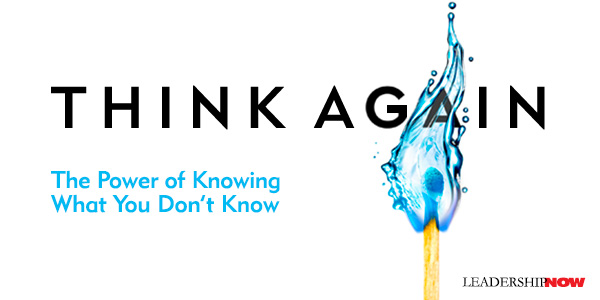
RETHINKING can cause uncertainty. Make us uncomfortable. Feel uneasy. It can threaten our identities. But rethinking can also help us find solutions to old problems, deepen our perspective, release us from inherited dogma and other people’s opinions, and understand how our closely held values relate and are applied to our changing environment. Adam Grant challenges us to Think Again—to question what we think we know. “Unfortunately, when it comes to our own knowledge and opinions, we often favor feeling right over being right.” Grant’s colleague Phil Tetlock discovered that when we think and talk (and scan social media), we tend to slip into the mindsets of three different professions: preachers, prosecutors, and politicians. “The risk is that we become so wrapped up in preaching that we’re right, prosecuting others who are wrong, and politicking for support that we don’t bother to rethink our own views.” (Grant offers a short Think Again quiz on his website.) The approach to ideas and opinions that we need to be gravitating to is the scientist mindset. It is a mindset of curiosity and a search for truth rather than becoming defensive, offensive, or appeasing.
Rethinking is not a question of how smart you are. “The brighter you are, the harder it can be to see your own limitations. Being good at thinking can make us worse at rethinking.” What does matter is how curious and actively open-minded you are. Actively in the sense that we are searching for reasons why we might be wrong. A key to rethinking is being able to detach yourself from your beliefs. This takes two forms: “detaching your present from your past and detaching your opinions from your identity.” Who you are should be a question of what you value, not what you believe. Values are your core principles in life—they might be excellence and generosity, freedom and fairness, or security and integrity. Basing your identity on these kinds of principles enables you to remain open-minded about the best ways to advance them. It is quite common for differences of opinion to turn into a relational conflict—personal and emotional—filled with animosity and vindictiveness. Task conflict is often desirable in order to get to the best answer. “The absence of conflict is not harmony, it’s apathy.” When a clash gets personal and emotional, we become self-righteous preachers of our own views, spiteful prosecutors of the other side, or single-minded politicians who dismiss opinions that don’t come from our side. While it’s nice to have people around us that agree with us, successful people need a challenge network—people we trust that can point out blind spots, doubt our knowledge and be humble about our expertise. In short, people who will question us and hold us accountable for rethinking our perspectives. Wilbur Wright once wrote, “Honest argument is merely a process of mutually picking the beams and motes out of each other’s eyes so both can see clearly.” Grant notes that “research suggests that we want people with dissimilar traits and backgrounds but similar principles. Diversity of personality and experience brings fresh ideas for rethinking and complementary skills for new ways of doing.” In a debate, it is best to begin with finding common ground. It’s a dance. “When we concede that someone else has made a good point, we signal that we’re not preachers, prosecutors, or politicians trying to advance an agenda. We’re scientists trying to get to the truth.” At the same time, keep your argument simple. Too many, and you will dilute the power of each and every one. “We don’t have to convince them that we’re right—we just need to open their minds to the possibility that they might be wrong.” When we know that we might not really know, rather than investigating, “we become mental contortionists, twisting and turning until we find an angle of vision that keeps our current views intact.” And we can become quite hostile. No surprise there. It’s hard to get others to change. It’s better to help them find their own reason to change. And the best way to do that is to listen—ask questions. What we have to avoid is the righting reflex—“the desire to fix problems and offer answers.” There are a good number of issues in the world where there is more going on than we know. The issues are complex and not binary—yes or no. Admitting the complexity of an issue is often a sign of credibility. And skeptics are not deniers. They are curious. If you find yourself saying _____ is always good or _____ is never bad, you may be a member of an idea [or personality] cult. Appreciating complexity reminds us that no behavior is always effective and that all cures have unintended consequences. Grant gives us many more reasons to rethink what we think than I have covered here. His concern is that by reading the book, we don’t close the book on the issue of rethinking. The book brings awareness to our human nature, but it doesn’t make us do anything about it. It’s easy to look at our loosely held beliefs and rethink them. The challenge is to rethink those deeply held ideas and beliefs that tend to divide us—especially those ideas that we have blindly accepted from others. We—collectively—have outsourced far too much of our thinking. It’s time to think again. 
Posted by Michael McKinney at 07:51 AM
12.15.20

Uncharted: How to Navigate the Future
PREDICTION has never been easy – or that accurate. Over and over again, forecasts and models fail us. And when they do, they won’t go away because the agenda behind them lives on. As a model or a forecast is designed to do, we become “recruited into an army of believers.” “The more we believe, the less we question,” says Margaret Heffernan. In Uncharted: How to Navigate the Future, she writes that “Overwhelmed with complexity, we seek simplification and too quickly reach for binary perspectives, just at the moment when we need broader ones.” How true. We crave certainty in a world that remains ambiguous. In an outstanding first chapter—False Profits—she reviews the work of three economic forecasters and the shortcomings and consequences of each. Forecasts and models are useful if they get you thinking, but only if we see them for what they are—propaganda.
Our past informs our present and future, but it can’t predict it. History, especially our personal history, defines a trajectory and provides us with probabilities. It tells us how we tend to react to what life throws at us, but we also have the capacity to learn and grow and change. New experiences shape us.
Believing that his history always repeats itself can lead to “blindness and blunder.”
Much of what she is talking about here defines the year 2020. So, if we can’t predict the future, what can we do? First, we can experiment more. In a time of crisis, we need to know more. We need to experiment. Experiments are an “antidote to helplessness or passivity. They set us on paths that reveal new knowledge and choices.” We can develop scenarios to “identify and test how and where the future and the present meet.” Different from experiments that “reveal immediate internal features of a complex system, scenarios explore where the internal organization meets the external environment, where uncertainties lurk beyond anyone’s control.” Scenario planning always surfaces conflict and there is always a moment when everything seems to fall apart. But getting the conflict out in the open, constructively, is crucial; it’s how and when people start to acknowledge and consider alternative perspectives. Third, we need to think like an artist. Artists think for themselves. They pay attention. Notice more. And then they let it sit—simmer, filter, distill, digest. Then they act. The only way to know if you are on to something is to start. I liked the phrase: “moving in and out of focus, trying to get a feel for something that doesn’t exist yet.” To have insights that are relevant to life requires having a life, one rich in experiences, and the time to internalize them. Fourth, think beyond. Start a Cathedral Project. Cathedral projects are unpredictable from the beginning. “They are destined to last longer than a human lifetime, to adapt to changing tastes and technologies, to endure long into the future as symbols of faith and human imagination.” They are also full of experiments making them “intrinsically, ambiguous, uncertain, and full of risk.” They attract brilliant minds because “the scale of their aspiration ensures that, instead of being passive victims of the future, they are actively involved in making it.” Imagination, creativity, compassion, generosity, variety, meaning, faith, and courage: what makes the world unpredictable are the same strengths that make each of us unique and human. Accepting uncertainty means embracing these as robust talents to be used, not flaws to be eliminated. 
Posted by Michael McKinney at 05:11 PM
11.27.20

The Hidden Habits of Genius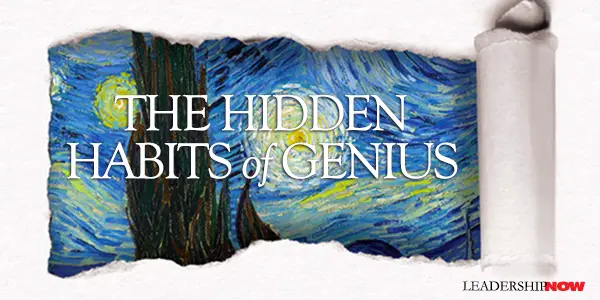
WHO and what is a genius? The label gets thrown around a lot. Are you a genius? Probably not. But then, most of us are not. However, you can learn to think like one. Craig Wright teaches a class at Yale on the nature of genius. He distills all of that work into his book with a hopeful title, The Hidden Habits of Genius: Beyond Talent, IQ, and Grit—Unlocking the Secrets of Greatness. Perhaps there is something we can learn from true geniuses that will help us perform better ourselves. I like the definition of a genius provided by German philosopher Arthur Schopenhauer: “A person of talent hits a target that no one else can hit; a person of genius hits a target that no one else can see.” Wright defines a genius as “a person of extraordinary mental powers whose original works or insights change society in some significant way for good or for ill across cultures and across time.” Geniuses work hard, but it’s not the hard work—the 10,000 hours of practice—that is the secret. “Practice may make the old perfect, but it does not produce innovation.” Talent may be the impetus, but hard work moves it along. To get to the top, it seems “you must max out both.” IQ tests can’t predict the next genius or a person’s potential. Some who have done well academically, like Marie Curie, Sigmund Freud, and Sergey Brin, went on to do remarkable things. But others we look up to today, like Einstein, Edison, Steve Jobs, and Picasso, did poorly in school. What about prodigies—young people who possess talents far beyond their years? Not really. “The difference is that geniuses create. They change the world through original thinking that alters the actions and values of society. Prodigies merely mimic. Childlike creativity plays a part. Picasso said, “Every child is an artist. The problem is to remain an artist as we grow up…. When I was a child, I could paint like Rafael, but it took me a lifetime to paint like a child.” “From Einstein’s mental play with images emerged his famous thought experiments. Einstein was able to imagine the world as a child while keeping apposite scientific information in mind.” Geniuses are lifelong learning addicts. “Students may receive information and learn methodologies in school, but the game changers of this world acquire the vast majority of what they know over time and on their own.” They learn what they need to know. What about passion? “If our passions drive us in ways that ultimately change society, that change is a mark of genius.” Not all passion leads to genius. Geniuses see things differently. They “cannot accept the world as described to them. Each sees a world asunder and cannot rest until things are put right.” Some geniuses are rebels, but not all rebels are geniuses—no matter how remarkable they may seem in the present. Some rebels, misfits, and troublemakers are just that. Not geniuses, but rebels, misfits, and troublemakers—people that just want their own way or push their own agenda. Wright correctly asks, “What is it that all of us believe today that some genius will disprove tomorrow?” We should be more careful pushing our biases and opinions. “Most rebels are not geniuses.” A person that changes the course of history need not be a genius, but rather someone who saw an opportunity and took it. Some people we presently regard as geniuses are clever and creative, but they are not geniuses. Aesop observed in his fable, The Fox and the Hedgehog, that “the fox knows many small things, while the hedgehog knows one big thing.” Wright says, be the fox. Develop a wide range of knowledge, perspectives, and skills. Cross-train. “The more broadly based the information in mind, the more likely that disparate ideas are combined.” Jeff Bezos observed, “The outsized discoveries—the ‘non-linear’ ones—are highly likely to require wandering.” “The lesson for all of us,” says Wright, “stay nimble.” Imagine the end and work backwards. Think opposite. Again, Bezos instructs: “You see a new technology, or there’s something out there, … and you work backwards from a solution to find the appropriate problem.” Wright says, “the more a person can exploit the contradictions of life, the greater his or her potential for genius.” To coax out your best ideas, relax. “If you need a fresh idea, go for a walk, or jog, or simply get into a relaxing conveyance so as to allow your mind to range more freely.” Then concentrate. Like a genius, “create a daily routine for yourself that comes with a four-wall safe zone for constructive concentration…. At the end of the day, you alone are responsible for synthesizing that information and producing something.” Could we use more geniuses? Well, yes. But what we really need are people who learn to think like a genius. Not the pandering and the misuse of statistics to push an agenda that has become so prevalent. We need people who will take a measured approach and contribute constructive ideas that will benefit the rest of us. 
Posted by Michael McKinney at 02:31 PM
11.23.20

Think For Yourself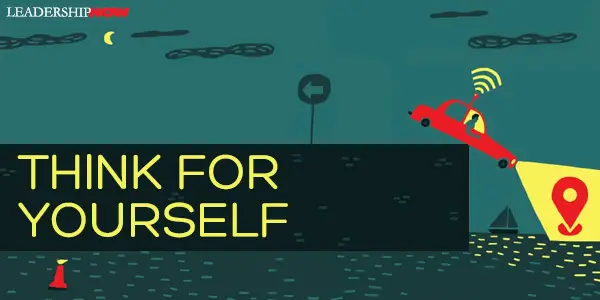
A GREAT IRONY of our time is that even as we are more informed, we are thinking less. We outsource our thinking. We rely on others to think for us. And we do almost unconsciously, by default, without thinking. As the change around us adds complexity and an overwhelming number of choices, we naturally defer to experts to focus our attention on what matters. In Think for Yourself, Harvard University lecturer Vikram Mansharamani cautions that “by outsourcing our focus to them, we willfully let them take control over our field of vision, blind to what they leave out.” He cautions, “At the very least, we should think about, and ideally ask about what other variables might be worth considering.” When we listen to or limit our options to the criteria of a similar set of experts, it will limit our options, filter our information, and the soundness of our decisions. When “our decision frames are set by others, and we forget to keep track of what options and factors we ignore, [we open] ourselves up to unnecessary risks and missed opportunities” and unsubstantiated fear and perspectives. When an expert focuses on their specialization, they often lose the broader perspective that has a significant bearing on the issue in question. “The key is to step back and ask: What are you losing when you narrow your option set?” Focus May Work Against Us While focus has its place, focusing is a process of filtering out and ignoring. When we do, we miss out on some things and see more of what we are focusing on. “Focus increases confidence while clouding judgment.” Fundamentally, the Peter Principle is about focus. It’s about how managers tend to focus too much on how a person is doing in their current job as the means through which to evaluate their potential for their next job. But when you stop to think about it, that doesn’t make a ton of sense. Evaluation criteria should be based on future roles. It may mean that some people who are performing poorly in their current position may blossom if promoted. We’ve heard it said that the cure is worse than the disease. “By focusing intensely in one domain, we often fail to see how our actions may create the very problem we are seeking to avoid. We need to step back, zoom out, and look at the whole system rather than just its parts. The sad reality is that many of our supposed solutions are compounding the problems.” The bottom line is that we are all dependent on others to some extent; it’s a fact of modern life. But this dependence need not translate into blind obedience. As we turn to those who can help, we must remember their limitations and appreciate other perspectives. Triangulate Perspectives We need to take the time to gather other perspectives—to triangulate unique points of view. A perspective is, by definition, incomplete. Each has its limitations. We owe it to ourselves to get several points of view to expand our context. On a personal level, empathizing and seeing your circumstances in a bigger context can be useful. It’s helped dampen my exuberance when I’m on top of the world, and also boosted my spirits during tough times. Having a broader context on your own perspective is critical in uncertain times. In navigating uncertainty, Mansharamani reminds us that “probing, sensing, and responding are key activities. It’s a dot-connecting exercise, not a dot-generating one.” Experts are among the least successful predictors in times of massive uncertainty. They often think they know more than they actually do and therefore exhibit more confidence than is warranted. Hubris tends to affect their objectivity, particularly when they become the go-to thinkers to help others who by definition are admittedly confused. The result: a significant number of very visible expert predictions have gone embarrassingly wrong…. It was often developments outside of their domain that derailed their predictions. Experts are more reliable in complicated environments and where there is a clear cause-and-effect relationship. Mansharamani says we need to “come up with a new way to engage experts.” To begin, we need to “abandon our devotion to depth and reintroduce a greater focus on breadth.” Economist Noreena Hertz said in a 2010 TED Talk: We’ve become addicted to experts. We’ve become addicted to their certainty, their assuredness, their definitiveness, and in the process, we’ve ceded our responsibility, substituting our intellect and our intelligence for their supposed words of wisdom. We’ve surrendered our power, trading off our discomfort with uncertainty for the illusion that they provide. Navigating uncertainty requires that we learn to triangulate unique points of view and connect the dots. “It takes an independent, external, and less-focused perspective to connect the dots in a conclusive way.” Rather than going out and getting a “second first opinion, we need to get “a true, unadulterated, independent second opinion.” We can help ourselves by exposing ourselves to different points of view and experiences and becoming perpetually curious rather than accepting a single perspective. “The idea of being broad enough to contextualize information is critical; it helps to generate awareness that there are those who know more than we do and allow us to place the inputs of experts and specialists in perspective.” The future belongs to those who can think for themselves. 
Posted by Michael McKinney at 01:50 PM
11.11.20

The Myth of Experience
WE LEARN from experience. We’d be silly not to. But the question becomes, what are we learning? Experience is a powerful teacher, and therein lies the problem. We may think we are gaining wisdom, when in fact we are just reinforcing the wrong lesson just as powerfully. In The Myth of Experience, Emre Soyer and Robin Hogarth write that “while experience still leads to learning, there is no guarantee that its lessons accurately represent the reality of a situation.” We naturally assume that what we see is all there is. Experience rarely gives us a complete picture of the situations we face. What we think is reality is just what we can see. And this is true in certain circumstances—in learning environments that are kind. In kind learning environments like cycling and tennis, “decision makers receive abundant, immediate, and accurate feedback on their actions and the rules of the game remain largely constant.” If everything we did was like tennis or cycling, then the lessons we gain from experience would be fairly reliable. But many/most experiences in life are not like that. Much of the time, our circumstances are not that reliable. Our activities fall into the category of wicked learning environments, “where experience is constantly subject to a variety of filters and distortions.” That means what we think we are experiencing does not correspond with reality. These circumstances “may not only fail to represent a given situation accurately but also constantly feed us a convincing illusion. The rules can change suddenly and dramatically, rendering our institutions obsolete.” So, what do we do? Rejecting what we think we know can be very difficult. Two Crucial Questions You Need to Ask Recognizing that what we are experiencing may not be connected to reality is the first step. Next, ask two questions about what you are experiencing: What’s missing? Is there something important missing from my experience that I need to uncover is I hope to fully understand what is happening? And What’s irrelevant? What irrelevant details are present in my experience that I need to ignore to avoid being distracted from what is happening? How We Learn from Experience Our experiences quickly become part of a story we tell ourselves. And these stories become the basis for the judgments and predictions we make. They help us to form cause-and-effect relationships. While these stories can be beneficial to us, they can also be too simple to adequately capture the reality of the situation. And we can see stories where none exist—no cause-and-effect. When we tell this story enough, it can be hard to accept anything else. If not handled with care, our experience can make us believe in the wrong causes, expect unrealistic consequences, evaluate performances inadequately, make bad investments, reward or punish the wrong people, and fail to prepare us for future risks. Worse, we may not even notice that we are acting upon faulty stories and fail to revise them in a timely and appropriate way. As a result, we may end up solving the wrong problems, using inadequate methods, and failing to achieve our objectives. And we need to be careful about learning from the experiences of others. We’ve all seen and read them: The 8 Things Billionaires Do Every Day. What the Most Productive Do Before Breakfast. 10 Common Traits of Effective Leaders. These lists can be helpful in that they get us to think about our habits and give us insight into what’s possible, but how accurate are they. I mean, did all of the people interviewed diligently do everything on the list? Are these things they do the result of their success or the cause of their success. Are they predictive? What about people who did these things and failed?
If we are to learn the right lessons from experience we need to ask ourselves, what’s missing and what’s irrelevant from our situation. And The Myth of Experience illuminates the way. 
Posted by Michael McKinney at 05:43 PM
08.21.20

Touching the Jaguar: How to Transform Your Fear into Action
FACING OUR FEARS is often what is standing between us and success. Touching the Jaguar is a cathartic memoir by John Perkins about confronting the things you fear to make the necessary changes in your life. In this memoir, he touches on the value of altering your perception to change your reality. It’s a valuable lesson expressed in a new way. While working in the Amazon, a shaman told him about touching the jaguar: The jaguar stands on a Perception Bridge “that could convey us from a reality based on preconceived ideas and values to a reality based on new ideas and values. If we are scared off by that jaguar, held back by things we’d been taught in the past or our fear of change, for example, we would not get past the jaguar and cross the bridge. If, on the other hand, we touched the jaguar, recognized the voices, teachings, values, or other barriers that stood in our way, confronted them and altered them, we are empowered to take the actions necessary to cross the bridge into a new reality.” We live with two realities. There is reality itself, and then there is what we perceive it to be. By crossing the perception bridge, we are taken to a new perspective. We can find compassion and empathy from other perspectives. We receive the energy to move forward and take positive action. We can ask what we might do to help others cross the Perception Bridge. By touching the jaguar, we are “recognizing that human reality is molded by our perceptions and that to change ourselves or our world, we must break through the barriers that imprison us in old ways of thinking and acting. If we run from or deny our fears, they will hound us. By confronting them, we take their power.” 
Posted by Michael McKinney at 12:01 AM
06.10.20

How to Think Like a Rocket Scientist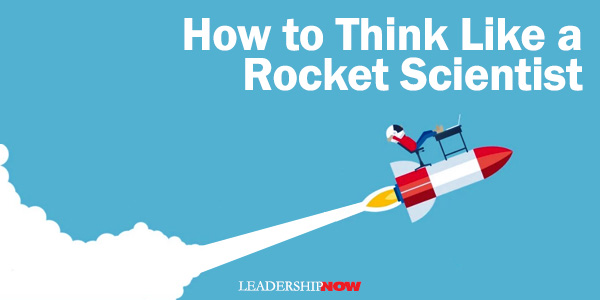
FORMER rocket scientist turned law professor, Ozan Varol, believes that while we can’t all be rocket scientists, we can all learn to think like one. Think Like a Rocket Scientist is about creativity and critical thinking—two skills in short supply today. We all encounter complex and unfamiliar problems in our daily lives. Those who can tackle these problems—without clear guidelines and with the clock ticking—enjoy an extraordinary advantage. Creativity comes naturally to us, but we are educated out of it in favor of certainty. Critical thinking, while valued theoretically, is not taught because we prefer the ease of conformity and the prepackaged answers we can accept from others. Think Like a Rocket Scientist is a content-rich and very practical book. Varol offers nine principles in three stages to help us to reacquire and build our creativity and critical thinking muscles. In the first stage, we learn how to ignite our thinking. Stage two is focused on propelling the ideas we created in stage one. In the final stage, we learn why the final ingredient for unlocking our full potential includes both success and failure.
1. Flying in the Face of Uncertainty Bertrand Russell wrote that “the stupid are cocksure while the intelligent are full of doubt.” We crave certainty to the point of making sure and true what isn’t certain at all. We do so at our own peril. “Where certainty ends, progress begins.” “The great obstacle to discovering,” historian Daniel J. Boorstin writes, “was not ignorance but the illusion of knowledge.” The pretense of knowledge closes our ears and shuts off incoming educational signals from outside sources. Certainty blinds us to our own paralysis. The more we speak our version of the truth, preferable with passion and exaggerated hand gestures, the more our egos inflate to the size of skyscrapers, concealing what’s underneath. Because of uncertainties, rocket scientists build in redundancies and margins of safety. “Think about it: Where are the redundancies in your own life?” To deal with uncertainties, we must begin walking before we see a clear path. “Start walking because it is the only way forward.” 2. Reasoning from First Principles There are all kinds of narratives floating around based on assumptions, and when we pick one, they become who we are. First-Principles thinking takes us back to the beginning and questioning the assumptions. “The French philosopher and scientist René Descartes described it as systematically doubting everything you can possibly doubt, until you’re left with unquestionable truths. When you apply first-principles thinking, you go from what James Carse calls a finite player, someone playing within boundaries, to an infinite player, someone playing with boundaries. Ask yourself, Why are they making that choice? It’s not because they’re stupid. It’s not because they’re wrong and you’re right. It’s because they see something that you’re missing. It’s because they believe something you don’t believe. 3. A Mind at Play A mind at play is a curious mind. Thought experiments ask “what if” questions. “Thought experiments construct a parallel universe in which things work differently. Through thought experiments, we transcend everyday thinking and evolve from passive observers to active interveners in our reality.” Varol says, compare apples and oranges. Get bored more often. Boredom allows our mind to tune out of the external and allows our mind to wander and daydream. If we don’t take the time to think—if we don’t pause, understand, and deliberate—we can’t find wisdom or form new ideas. As author William Deresiewicz explains, “My first thought is never my best thought. My first thought is always someone else’s; it’s always what I’ve already heard about the subject, always the conventional wisdom. Moonshot Thinking Moonshot thinking is taking a leap of faith. Incremental change modifies the status quo. Moonshot thinking allows for exponential change and upending the status quo. The story we choose to tell ourselves about our capabilities is just that a choice. And like every other choice, we can change it. Until we push beyond our cognitive limits and stretch the boundaries of what we consider practical, we can’t discover the invisible rules that are holding us back.
5. What If We Sent Two Rovers Instead of One? Questions matter. Make sure you’re solving the right problem. Peter Attia, a physician and renowned expert on human longevity, said: When people are looking for the “right answers,” they are almost always asking tactical questions. By focusing on the strategy, this allows you to be much more malleable with the tactics. Varol adds: Once you move from the what to the why—once you frame the problem broadly in terms of what you’re trying to do instead of your favored solution—you’ll discover other possibilities in the peripheries. 6. The Power of Flip-Flopping Confirmation bias is alive and well primarily because it feels good, and it takes the work out of really thinking. While scientists are trained to be objective, even rocket scientists have a hard time thinking like rocket scientists. “No one comes equipped with a critical-thinking chip that diminishes the human tendency to let personal beliefs distort the facts.” Opinions are hard to reassess. “When your beliefs and your identity are one and the same, changing your mind means changing your identity—which is why disagreements often turn into existential death matches.” If the mind anticipates a single, that’s what the eye will see. Before announcing a working hypothesis, ask yourself, what are my preconceptions? What do I believe to be true? Also ask, do I really want this particular hypothesis to be true? If so, be very careful. Be very careful. 7. Test as You Fly, Fly as You Test A test where the results are predetermined is not a test. “In a proper test, the goal isn’t to discover everything that can go right. Rather, the goal is to discover everything that can go wrong and to find the breaking point.” Rocket scientists try to break the spacecraft on earth before it breaks in space. Find the breaking points. When astronaut Chris Hadfield returned from a successful mission, if everything had gone as planned, he responded, “The truth is that nothing went as we’d planned, but everything was within the scope of what we prepared for.”
8. Nothing Succeeds Like Failure Rocket scientists don’t celebrate failure, nor do they demonize it. They take a more balanced approach. Nor do they fail-fast. The stakes are just too high. Their mantra is to learn fast. We often assume failure has an endpoint. But failure isn’t a bug to get out of our system until success arrives. Failure is the feature. If we don’t develop a habit of failing regularly, we court catastrophe. 9. Nothing Fails Like Success Success conceals failures. Sometimes success is pure luck. Without failures to learn from, we must learn from our successes. Success is the wolf in sheep’s clothing. It drives a wedge between appearance and reality. When we succeed, we believe everything went according to plan. We ignore the warning signs and the necessity for change. With each success, we grow more confident and up the ante. We pay a lot of lip service to critical thinking, yet it is a rare commodity. Think Like a Rocket Scientist is an essential read for anyone wanting to develop critical thinking skills or to mature their thinking. 
Posted by Michael McKinney at 07:57 PM
04.27.20

Cognitive Reappraisal for Wild Success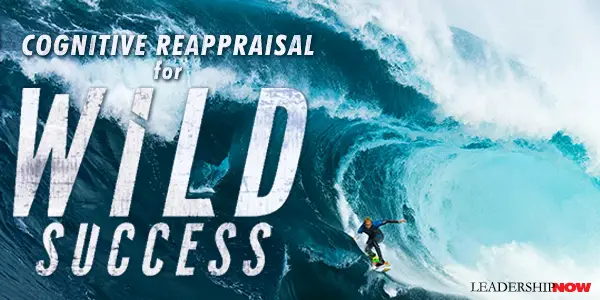
EXTREME adventurers have to perform at their best every time, or there might not be another time. They must be able to execute a plan under pressure. The same qualities that help them succeed will help any leader perform at a higher level and especially in a crisis situation. Wild Success by Amy Posey and Kevin Vallely illustrates seven leadership lessons we can learn from the harrowing experiences of extreme athletes. They are cognitive reappraisal, grit, learning from feedback, finding your spark, innovation, resilience, and building balance. I want to focus on a critical, but often difficult skill that we all need to develop: cognitive reappraisal. When you are looking at danger, uncertainty, and understandable fear, you need to be able to get perspective on what you’re facing. And when things go wrong, this discipline is even more critical. Posey and Valley introduce the experience of one of the best big wave surfers in the world, Australian Mark Mathews. Before Mark faces a dangerous wave like the slab wave he’s about to ride, “he performs a set pre-surf ritual to put his mind into focus. It’s something he does every time. ‘Fear is a big part of what I do,’ he says, ‘so dealing with it effectively is critical to my performance.’ Using simple breathing techniques to slow his mind down, Mark concentrates on feelings of excitement rather than anxiety, while reflecting on why he is doing what he is doing.” But on this day in 2016, Mark attempts to escape the wave, but the wave picked him up and slammed him feet first into the reef. Rushed to the hospital, the doctors find that the force of the blow has dislocated his knee, fractured his chin, ruptured his anterior and posterior cruciate ligaments, and ripped through his artery and nerve. They doubt they can save his leg. But with some luck they do, and he is treated for three months in the hospital. It looks like his career is over. But it isn’t. His ambitions have only grown. “What allows Mark to have the mental wherewithal to claw back from catastrophic injury and still have the fortitude to remain committed to the very thing that has hurt him so badly?” Cognitive reappraisal. Cognitive reappraisal is our ability to consciously manage our emotional experiences and responses to a setback or challenge and transform the negative emotions we feel into more positive ones. Cognitive reappraisal lets us not only acknowledge and reduce our emotional response to a negative situation, but it also changes our perspective on that situation by letting us take a step back and add a positive spin to whatever challenge we’re facing. Building this ability takes practice. Every setback is an opportunity to develop this mindset until it becomes a habit. For Mark, his “ability to positively reframe a situation both on and off the waves has come with lots of practice, and this practice developed a habit of cognitive reappraisal that served him well when he needed it most.” A habit of reframing a negative situation actually rewires your brain. A study by Columbia University professor Kevin Ochsner and his team found that when those who reframed a negative situation in a positive light, “their prefrontal cortex, the area of the brain integral to one’s cognitive behavior and emotional self-regulation, was activated by their reframing of the situation, while their amygdala, the area of the brain associated with fear and anxiety, saw a reduction in activity.” Negative events happen to us all. It’s normal to have an adverse emotional reaction—anger, hurt, self-doubt—at first. But if you can recognize the emotion in the moment—the shallow breathing, sweaty palms, an upset stomach—and make a choice to put cognitive reappraisal into action, you will take much of the stress out of the situation and allow for your creativity and to take hold and move forward in a more emotionally intelligent way. If we miss these symptoms [of stress] at the early stage, we quickly move into something called the emotional “point of no return,” where your emotions become fully activated, and reappraisal becomes exceptionally difficult. Practicing this anticipatory regulation during small and low-stakes stressors allows you to understand your own point of no return and [be better able to pull yourself] back from it. Cognitive reappraisal is a simple idea but very difficult to put into practice in the heat of the moment. But with some intentional practice, you can make it a habit that will serve you well in stressful and negative situations. 
Posted by Michael McKinney at 07:07 AM
09.04.19

The Optimist’s Telescope: Thinking Ahead in a Reckless Age
HOW DO YOU get people to think ahead? In a time characterized by wide-ranging change, we need to think through the consequences of what we have wrought. We need to think ahead. It is reckless not to. Since we can’t predict the future it makes it hard for us to think about the future. It should come as no surprise that our view of the the future is often misguided. In 1920, British economist Arthur Cecil Pigou described our often skewed view of the future as our “defective telescope.” In The Optimist’s Telescope, author Bina Venkataraman suggests that we need to cultivate a “radical strain of optimism” and a sense of collective agency that would motivate “more people to make choices today for the sake of the future, whether it’s how they vote, eat, use energy, or influence others.” An “optimist’s telescope” so to speak. Looking beyond the noise is key to thinking ahead. “Urgency and convenience are dictators of decisions large and small. We are frequently distracted from our future selves and the future of our society by what we need to accomplish now.” Our society is designed around quick wins because that’s what we want. “The conditions we have created in our culture, businesses, and communities work against foresight.” Rewards are given for the quick win. We need foresight. Foresight combines what we know with the humility to know that we don’t know it all and be ready for the possibilities. And that requires a little imagination. Venkataraman eloquently states, “We try too hard to know the exact future and do too little to be ready for its many possibilities.” Venkataraman offers countless examples of how individuals and organizations have defied instant gratification and instead taken the long view. When one investment firm saw a stock price fall they wisely avoided a knee-jerk reaction. “They avoided distractions of the moment by returning like a broken record to their original rationale for believing in the stock. You might call this a North Star tactic, calling on people in an organization to habitually look up from daily minutiae to reorient themselves to their ultimate destination.” At a Stanford Director’s College in 2016, Roger Dunbar, chair of the Silicon Valley Bank, told Venkataraman that “when he hears company executives or board members responding to short-term noise with outsize reactions, he likes to pretend he is lost. He’ll ask CEOs at board meetings, ‘What was our long-term strategy again?’ as if he has forgotten it. Sometimes, he says, company leaders suffer from being too smart—analyzing every piece of data that come their way—instead of asking simple but pivotal questions. It can help, in his view, to have a board member who is not afraid of sounding naïve or even a touch senile.” It helps too to look past typical metrics to see what is actually happening long-term. Dan Honig, a political scientist at the John Hopkins School of Advanced International Studies, believes that “metrics can be useful when an organization has a simple, concrete goal such as building a road. The trick is for the measure to be tightly linked to what the organization actually wants to accomplish. For the more complex undertakings of organizations, however, numeric targets are often far removed from actual goals and more likely to deceive. In those instances, Honig says, managers are better off using their judgment to evaluate progress. It’s a common mistake for organizations to attach simple metrics to nuanced goals such as educating children, reforming the justice system, or growing an innovative business.” It would be a bitter irony to remain entranced by myopic metrics, gearing ourselves up to hit immediate targets at a time when technology and our economy are evolving to privilege humans for being visionary, empathetic, nuanced, and strategic. In the future, the human edge is going to come from what we value and from our judgment, not from going head-to-head with machines to parse facts. On a personal level, we too can learn to measure ourselves by more meaningful metrics than what we have achieved in the moment. From her research, Venkataraman has extracted five key lessons to help us think ahead and stay the course: 1. Look Beyond Near-Term Targets “We can avoid being distracted by short-term noise and cultivate patience by measuring more than immediate results.” Instead of looking at snapshots, reflect on long-term goals. 2. Stoke the Imagination “We can boost our ability to envision the range of possibilities that lie ahead.” Allow time to imagine future risks and rewards and then visualizing how we can successfully navigate those futures. 3. Create Immediate Rewards for Future Goals “We can find ways to make what’s best for us over time pay off in the present” or “seek programs that offer immediate allure but are designed for our long-term interest.” In an example she shares about Toyota, they found a way to use the insights gained from long-term research on current production. “They found a way to create immediate rewards that made their sacrifices for the sake of future products seem worth it now to company leaders and investors.” 4. Direct Attention Away from Immediate Urges “We can reengineer cultural and environmental cues that condition us for urgency and instant gratification.” Avoid temptations. Where urgency rules, create systems that interrupt the momentum to create space to consider the decision. 5. Demand and Design Better Institutions “We can create practices, laws, and institutions that foster insight.” Look for solutions that encourage us to look ahead. Of course, institutions are made up of people, so we only need to look to ourselves first rather than trying to regulate foresight. Ultimately, Venkataraman believes we need to think like stewards or as she puts it, “keepers of shared heirlooms.” Heirlooms carry with them the “notion that future generations matter to the present generation, and that past generations will matter to the future.” Furthermore, “with an heirloom, each generation is both a steward and a user. When we pass on an heirloom, we don’t prescribe what each steward must do with it. Instead, we leave options open to the next generation.” It’s a good way to view our responsibility to think ahead. 
Posted by Michael McKinney at 05:30 AM
03.20.19

Get Savvy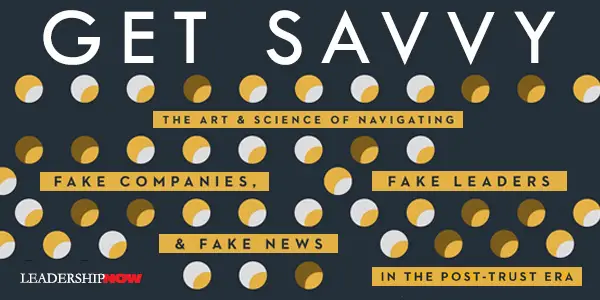
FAKE NEWS is not a new phenomenon. From the beginning of time, people have played loose with the truth in order to get what they want. Trust too, has waxed and waned over the millennia. It’s not new. People have always had to be on the lookout for fake news. And much has gotten through our filters over the centuries and has negatively impacted the assumptions we take for granted today. Perhaps what if different today is our ability to so quickly and persuasively disseminate it through technology. It makes the task of discerning fact from fiction so much harder. So much information is coming at us about things we know very little about and in our rush to form an opinion we easily become susceptible to misinformation and other people’s agendas. As Jonathan Swift wrote in 1710, “Falsehood flies and the truth comes limping after.” We believe what we want to believe. This is the subject of Savvy: Navigating Fake Companies, Fake Leaders, and Fake News in the Post-Truth Era by the husband and wife team Shiv B. Singh and Rohini Luthra. The stark reality is that we have entered ... a new post-trust era, in which telling truth from opinion, and separating fact from outright fabrications, requires us to be on guard, intensely aware of the ways in which we are being played, and how we are unwittingly contributing to the problem. Fakery has not only pervaded politics, it has made deeper inroads into business and our personal lives. 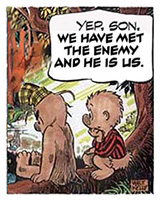 “Savvy is about understanding the role we (as consumers of information) play in succumbing to and propagating fakeness. Just as we have technology glitches so too do we have human glitches in the way we process information.” So the authors catalog some of the ways we readily deceive ourselves and play into fake news. These “glitches” are well presented and deal with the problem of fake news at its source. Repetitions Make the Truth If we hear a lie enough times, we begin to believe it. “We all know perfectly well that simply hearing something over and over again doesn’t mean it is truth, but we fall for this persuasive tactic anyway. Why?” We move toward things that are familiar to us because they are comfortable. “The more often we her something, the more familiar it becomes, and familiarity breeds trust.” We Want to Belong The desire to belong is strong. Not only does this foster groupthink, but it most often creates a toxic us versus them mentality “often leading to the demonization of the ‘other’ and contributing to discrimination and sometimes violence.” They encourage us to welcome dissenting opinions. Respect those with different viewpoints. We Want to Be Right “We want to be right, and we look for information that supports our existing beliefs.” This is known as confirmation bias. Because of this bias, when we try to convince others of the truth, they most often become more convinced of their own position. The more you try to convince someone else of your view the more entrenched they become of their own. The best approach is to find some common ground on which to build a basis for trust. Humility is in order. Overconfidence in our own opinion can cloud our judgment and lead us to marginalize others. We Bow to Authority We tend to trust people in authority. In my view, we should always respect those in authority because of our own self-respect. While respect is a choice, leaders must also know that they need to behave in a way that is deserving of respect. That said, we shouldn’t blindly follow leaders. “Assess a leader’s credibility, expertise, experience, and integrity.” We Blindly Trust Artificial Intelligence Perhaps that is an overstatement, but the authors are right in saying, “Rapidly advancing innovations are providing new capabilities that require us to give serious thought to the degree of trust we should place in the companies and governmental bodies that will be deploying them, and in the technologies themselves.” Again, it’s not the technologies, it the people who use them. Some will use them to greatly enhance the quality of our life and others will use them to control others. We need to discern the difference. And we should never blame the computer or use it as an excuse for the disrespect of human beings. Computers are programmed no matter how human they seem. 
Posted by Michael McKinney at 12:36 PM
03.04.19

11 Shifts Every Leader Needs to Make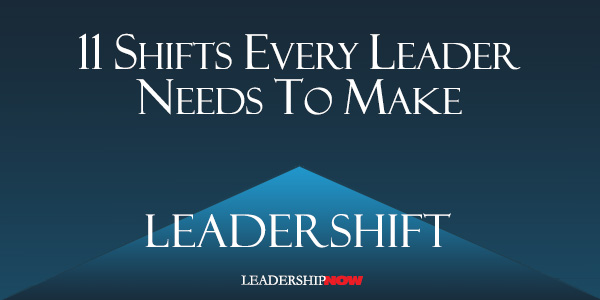
TO GET FROM where we are to where we want to be requires a shift in our thinking. When our thinking shifts in an area, our perspective changes, and new opportunities become visible. We serve people differently. In Leadershift, John Maxwell states, “every advance you make as a leader will require a Leadershift that changes the way you think, act, and lead.” Shifts in thinking require that you see a bigger picture, rethink your perspective, and understand your context. Your leadership potential depends on these shifts. It’s is unlikely that you would make all of these shifts at once. Some will happen gradually. Some will happen almost overnight. Some will come naturally to you and others will seem counterintuitive. We’re all different but we all need to make these shifts. Essentially they all boil down to making the shift from me to we. Maxwell suggests eleven leadershifts that have helped him grow as a leader. Here are a few ideas from each of the leadershifts he describes: Leadershift #1 Soloist to Conductor – The Focus Shift You can’t do it alone. Leadership is not a solo practice. Of course, working with others has its challenges. A big part of this shift is changing your focus from receiving to giving. Adding value every day without keeping score. “As leaders, we must stop wishing and start working. Instead of looking for the ‘secret sauce’ of success, we must start sowing seeds of success.” Leadershift #2 Goals to Growth – The Personal Development Shift Rather than focusing on goals, focus on growth. “Goals helped me do better, but growth helped me become better.” Begin on the inside. “Growth on the inside fuels growth on the outside.” You can’t do everything, so focus on four areas: attitude, developing strong relationships, your leadership, and equipping others to carry on without you. To become more growth-oriented, you need to embrace change, be teachable (humble), learn from failure, connect with other growth-minded people, believe in yourself, and understand that real wisdom is acquired and applied over time. Leadershift #3 Perks to Price – The Cost Shift Great leadership isn’t about control, the income or the corner office. It’s about sacrifice. Great leadership costs us something. American missionary Adoniram Judson is rumored to have said, “There is no success without sacrifice. If you succeed without sacrifice, it is because someone has suffered before you. If you sacrifice without success, it is because someone will succeed after you.” Great leaders go first. “What sets great leaders apart from all other leaders is this: they act before others, and they do more than others. Great leaders face their uncertainty and doubt, and they move through it to pave the way for others.” Leadershift #4 Pleasing People to Challenging People – The Relational Shift You can please some of the people some of the time, but you can’t please all of the people all of the time. But if you want the best out of people, you have to challenge them. “You have to put doing what’s right for your people and organization ahead of what feels right for you.” This means keeping your eye on the big picture. Sometimes you have to have tough conversations, but you must balance care with candor. Leadershift #5 Maintaining to Creating – The Abundance Shift Maintaining isn’t always easy, but it is the easiest mindset to slip into. It’s not about change for change sake, but it’s about “can we do better?” Create a creative environment where people gather ideas and value multiple perspectives. “Being inflexible and sticking to my plan put a lid on me and my organization.” Larry Stockstill said, “I live on the other side of ‘yes.’ That’s where I find abundance and opportunity. It’s where I become a better and bigger self. The opportunity of a lifetime must be seized within the lifetime of the opportunity. So I try to say ‘yes’ whenever I can.” Leadershift #6 Ladder Climbing to Ladder Building – The Reproduction Shift This shift is about equipping others. We being with ladder climbing (How high can I go?), then we shift to ladder holding (How high will others go with a little help?), then ladder extending (How high will others go with a lot of help?) to finally, ladder building (Can I help them build their own ladder?). “If you want learners to follow directions, you only need to provide the what. If you want them to lead others and give directions, they must also have the why.” Leadershift #7 Directing to Connecting – The Communication Shift You must learn to connect with people to be the best leader you can be. To move from directing people—talking, ready answers, your way—to connecting—listening, asking, empowering. Be a person people can trust. Lift others up. “When you interact with others as a leader, what is your mindset? Is your intention to correct them or connect with them?” Leadershift #8 Team Uniformity to Team Diversity – The Improvement Shift If everyone around you thinks like you, you need to expand your network. A diverse team will fill in gaps in knowledge, perspective, and experience. “Malcolm Forbes said diversity is the art of thinking independently together.” Leadershift #9 Positional Authority to Moral Authority – The Influence Shift Moral authority is not about position it’s about who you are. People follow moral authority before they follow positional authority. Maxwell lists four areas a leader needs to develop to have moral authority: competence, courage, consistency, and character. “Every leader who possesses moral authority has had to stand alone at some point in time. Such moments make leaders.” Leadershift #10 Trained Leaders to Transformational Leaders – The Impact Shift Maxwell believes that if you only make one shift in your leadership, this is the one because it “will bring the greatest change to your life and the lives of those around you.” Transformational leaders inspire others to become more. But that’s because they have worked to become more themselves. “If you want to see positive changes in your world, the first person you must change is you. As leaders, you and I have to be changed to bring change. We teach what we know, but we reproduce who we are.” Leadershift #11 Career to Calling – The Passion Shift This is the shift from just doing a job to do what you are gifted to do. Aristotle wrote, “Where our talents and the needs of the world cross, there lies our vocation.” Your calling is not about you. “A calling moves us from the center of everything in our world to becoming the channel through which good things come to others.” 
Posted by Michael McKinney at 10:30 AM
12.25.18

Hyperfocus: How to Take Control of Your Mind
THERE ARE LIMITS to our attention. There is only so much we can focus on at any given time. So it becomes critical what we allow in our attentional space if we want to get anywhere in life. (And heads up. Your attentional space shrinks as you age—but your mind wanders less.) When we try to cram too much into our attentional space, we experience attention overload. When we do that we forget things because we didn’t leave enough space for what we originally intended to do. What is going on in our attentional space is the subject of Chris Bailey’s Hyperfocus. Bailey shows us how we can use our limited attentional space intelligently and deliberately so that we can focus more deeply and think more clearly. Hyperfocus happens when we consciously expand our attention to fill our attentional space. It is when we are the most productive—and happy. So, how do we enter hyperfocus mode? Distractions are distracting because they are more attractive than what we are focusing on. We have to plan in advance to remove them. Distractions are costly. Put the phone down. Don’t check the emails. “It takes an average of twenty-five minutes to resume working on an activity after we’re interrupted, and before resuming that activity, we work on an average of 2.26 other tasks.” Not good. Our smartphones rob our attention probably more than anything else. Bailey offers this great advice: “Resist the urge to tap around on your smartphone when you’re waiting in line at the grocery store, walking to the coffee shop, or in the bathroom. Use these small breaks to reflect on what you’re doing, to recharge, and to consider alternative approaches to your work and life.” Reflection is one of the biggest gifts we can give ourselves. And then we have to deal with the natural wandering of our mind by continually and consciously refocusing. It also helps to plan to hyperfocus for a predetermined length of time. “Setting specific intentions can double or triple your odds of success.” Bailey has a whole chapter on taming distractions and offers techniques to help us with all of this.
Although your attentional space naturally shrinks as you age, study after study has shown that you can expand it through the practice of meditation. “Meditation involves continually returning your focus to a single object of attention—usually your breath—as soon as you notice your mind has wandered from it.” Breathing is the go-to because “the smaller the object of attention, the more your mind will wander, but the more you’ll expand the size of your attentional space as you focus on it.” Ironically, as important as it is to hyperfocus, we must also scatterfocus. That is direct our attention on nothing at all—but in a deliberate way. In scatterfocus mode, we are at our most creative and it also allows us to recharge. And because in this mode our mind spends most of its time thinking about the future which is good because we can set intentions and plan for the future. It also “enables us to better weigh the consequences of each decision and path.” “With hyperfocus you direct your attention outward; with scatterfocus you direct your attention inward.” In scatterfocus mode, you can capture ideas and actionable material. You can discover solutions to problems and connect ideas. It also serves to replenish our mental energy. Hyperfocus takes a lot of energy, and when we feel our attentional space contracting, we need to recharge our attention by deliberately entering scatterfocus mode. Scatterfocus mode is a great place to connect the dots providing you are collecting valuable dots in the first place. People become experts on particular subjects by accumulating and connecting enough dots related to them, in the form of experiences, knowledge, and best practices. With that in mind, it is wise to guard just what dots we are collecting on a regular basis. Some dots build us up, and some don’t. Defend your attentional space. It’s good to collect dots that add to our existing skills and knowledge, but it is just as important to collect dots that are unrelated to what we know. This often where new perspectives and breakthrough ideas will come from. “Every time you stop consuming trash, you make room for something useful to add value to your life.” Not surprisingly, a positive mood expands the size of our intentional space, and a negative mood shrinks it. Unhappy people take longer to refocus. Guard your thoughts. Hyperfocus can help you get an extraordinary amount done in a relatively short period of time. Scatterfocus lets you connect ideas—which helps you unearth hidden insights, become more creative, plan for the future, and rest. Together they will enable you to work and live with purpose. 
Posted by Michael McKinney at 12:25 PM
12.19.18

Questions Are the Answer
A PROBLEM OF OUR TIME—and perhaps every generation—is that we ask the wrong questions. The wrong questions divide us. Great questions break down assumptions and create possibilities. Simply put, better questions give us better answers. It’s all about the question. Great leaders are great at asking better questions. In the rapidly changing environment, we are in today, it is imperative. Our future depends on it. Until you ask different questions, you can’t move beyond the incremental progress most of us find ourselves in. Breakthroughs require different questions from the ones we’ve been asking. Decisiveness is a great quality but too often we charge ahead without really understanding the issue. We don’t get behind the issue. Better questions help us to get there. In Questions are the Answer, Hal Gregersen explains: The point is not to remain in constant questioning mode, always stepping back to rethink things instead of stepping up to make a decision and get on with life. But answering yesterday’s questions is not good enough at times when we are feeling stuck, or when innovation is imperative, or when change must happen more continuously. How do you get to the right question? Gregersen says that we can create the conditions in which questions thrive. To increase our odds of formulating better questions, we need to get out observe and network with the intention of exposing ourselves to new and varied viewpoints. And listen. When we stop talking we’ll be amazed at what we can learn. Our viewpoint could always be improved. Be intentional about it. We are rewarded and conditioned to have answers. We are not typically encouraged to ask. More often we passively collect information without learning to question the foundational concepts. Good questioners were encouraged to ask from early on in their childhood. “If we want to raise a generation of better questioners, we should try harder to influence what happens at home.” Intentionally fuel curiosity. Encouraging those “why” questions will fuel their curiosity and help to generate the “what if” questions that design better futures. As you advance as a leader “and have the opportunity to lead others and have much more impact, your focus has to shift to ‘making other people the smartest in the room, with good questions.’” Be comfortable with being wrong. Try being wrong more. “Questions don’t arise whenever we are wrong. It’s only on those rarer occasions when we think we are wrong. And for most of us, it’s only when we are practically hit in the face with how wrong we have been that questions start to get our attention.” Seek to question and improve your views. It makes sense to keep reminding yourself to admit and embrace being a little more wrong, goading yourself to stray into somewhat more uncomfortable environs, and compelling yourself to be more reflectively quiet. Immerse yourself in situations where you feel less right, less comfortable, or less compelled to speak, and your questions will multiply. Gregersen suggests we brainstorm for questions—not answers—to find new insights. That is, what better questions could we be asking about our problem? He calls them Question Bursts. There are two rules to this exercise—first, questions only. And second, no explanations or introductions. Just the questions please. And keep it short—four minutes is ideal. You’re trying to get people to look at the problem differently. You’re not trying to elicit answers but to get people to think differently. Question Burst exercises help to minimize and potentially overcome cognitive biases and eventually generate the breakthrough answers we need. “Asking the right questions is the only path to creating value—real value—at any level and in any role.” You have to actively support questioners because most organizations try to silence questioners. A leader who is secure enough to be questioned is a better leader. If as a leader you ask questions, you make it safe for others to do the same. Did you ask a good question today? 
Posted by Michael McKinney at 10:26 PM
12.05.18

The Key to Effective Leadership: Mindsets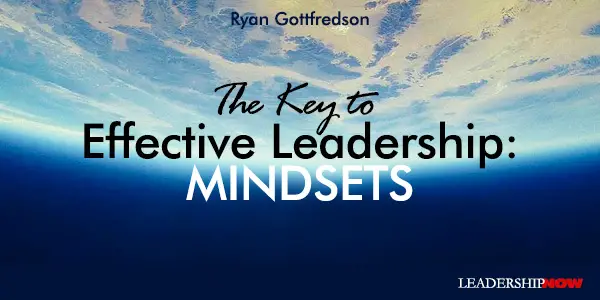
W To do so, consider four situations leaders can find themselves in:
Here is a table that shows two different leaders and how they each see and interpret these situations differently.
Who would you rather follow, Leader A or Leader B? Every group I speak to always says “Leader B.” But here is what is interesting, through a personal assessment I have done with over two thousand leaders and individuals, only 5% consistently operate like Leader B. What this hopefully demonstrates is that effective leadership is born not out of what leaders do or what behaviors they engage in, but first and foundationally in how they see and interpret the situations they find themselves in. So, what causes leaders to encounter the same situations, but interpret them so differently?
For example, consider a leader that has a subordinate that suggests that the leader could improve in some way. Depending upon the leader’s mindset, the leader could see that feedback as an indicator that the employee: (1) is questioning his/her leadership abilities and get defensive, or (2) cares about him/her and wants him/her to be as effective as possible. Thus, in this instance, the leader’s mindset drives how the leader thinks about the feedback, how likely the leader is going to learn from the feedback, and the manner in which the leader will behave in response to the feedback. Four Mindsets Necessary for Leadership Effectiveness If leaders’ mindsets are what drives their effectiveness, do you know what mindsets you need to develop to think, learn, and behave in the most effective way as a leader? Although mindsets are foundational to leaders’ effectiveness, most groups I speak to are unable to identify a specific mindset that is essential for leadership effectiveness. After learning about the power of mindsets and the foundational role they play in leadership effectiveness, I sought to identify the mindsets that drive effective leadership. As a leadership researcher, I scoured the academic literature, and I identified four sets of mindsets in largely four different areas of study (e.g., psychology, management, education, marketing) that have been studied for decades. While research associated with each set has repeatedly demonstrated that the mindsets influence individuals’ thinking, learning, and behavior, they have all be isolated from each other. Until now. I have pulled these different mindsets together into one framework to help leaders clearly identify the mindsets they need to develop to operate more effectively. Each set of mindsets represents a continuum from negative to positive as follows:  Every leader possesses a mindset that lies somewhere along each continuum, and the basic idea is that the more positive one’s mindset, the more effectively they are to think, learn, and behave in the situations that they encounter on a daily basis. Let me describe each set. Fixed/Growth
When leaders possess a fixed mindset, they seek to avoid failure, because, to them, failure means that they are a failure. Thus, those with a fixed mindset are primarily focused on looking good, and if something does not come easily or naturally to them, they have a tendency to give up. Leaders with a growth mindset, on the other hand, are primarily focused on learning and growing. They embrace challenges, see failure as an opportunity to learn and grow, and believe that success only comes through pushing through obstacles and difficulties. Closed/Open
Here is a great quote from Farnam Street: “Before you smugly slap an open-minded sticker on your forehead, consider this: closed-minded people would never consider that they could actually be closed-minded. In fact, their perceived open-mindedness is what’s so dangerous.” When leaders possess a closed mindset, they are primarily concerned about being seen as being right. As such, they seek to have their ideas supported, inclined to provide answers (as opposed to asking questions), avoid feedback and new perspectives, and see disagreement as a threat. All because they believe that what they know is best. When leaders possess an open mindset, they are primarily concerned about finding truth and thinking optimally. In order to do this, they ask questions, seek to understand, seek feedback and new perspectives, and see disagreement as an opportunity to learn. All because they believe that their perspective is limited and they can be wrong. Prevention/Promotion
Leaders with a prevention mindset are like a ship captain whose primary objective is to not sink. When this is the leaders’ objective, s/he focuses on ensuring no problems occur, limiting risk, and not “rocking the boat” (i.e., maintaining the status quo). Leaders with a promotion mindset are like a ship captain whose primary objective is to get to a specific destination. As such, the leader anticipates problems, sees risk as being necessary to reach the destination, and is willing to adjust operations to reach the destination. The difference between these two leaders is that those with a prevention mindset get blown about by the winds and the currents of the sea and end up in a destination not of their choosing, while those with a promotion mindset are willing to brave the winds and the currents of the sea to end up in a destination of their proactive design. Inward/Outward
When leaders have an inward mindset, they see themselves as being more important than others and are limited in their sensitivity to the feelings and emotions of those that they lead. And, when something goes wrong, they place the blame on others. When leaders have an outward mindset, they see others as being as important, if not more important, than themselves. And, when something goes wrong, they ask themselves: “Who am I being that their light is not shining.” Becoming a More Effective Leader Who would you rather follow, a leader whose mindsets are:
The effect of such leaders are just like they sound. Leaders with negative mindsets are constricting. Leaders with positive mindsets are expanding. What mindsets do you possess? Correspondingly, what type of leader are you because of your mindsets? Again, from my personal mindset assessment, I have found that only 5% of people consistently possess all four positive mindsets. If you are interested in learning how positive your mindsets are relative to thousands of others, I invite you to take my free personal mindset assessment. It will provide you with a personalized and comprehensive report to help you better understand each mindset set, what your mindsets are, and direction on how to improve your mindsets. In all: The key to being an effective leader is your mindsets.  
Posted by Michael McKinney at 12:19 PM
06.27.18

Unsafe Thinking: How to Get Out of Your Rut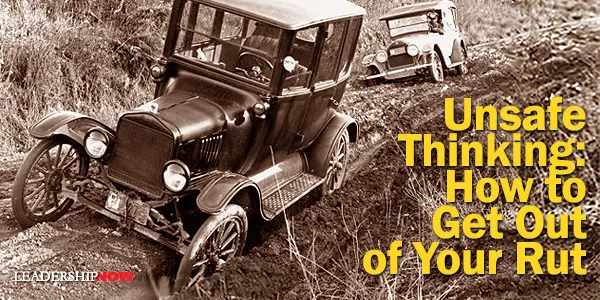
W “The ability to meet challenges with a willingness to depart from standard operating procedures; to confront anxiety, tolerate criticism, take intelligent risks, and refute conventional wisdom—especially one’s own views—in order to achieve breakthroughs” is what Jonah Sachs calls unsafe thinking. Feeling anxious is not a bad place to be in. Unsafe thinking means becoming comfortable with being uncomfortable. We’ve all heard the warnings. In changing environments, tried-and-true routines often lead to mediocrity. And we know this is true. Worse still, when we are in the midst of a problem or crisis, we easily revert to the same old thinking with the hopes that we’ll think it through better next time when we are under less pressure. But that never happens. So how do we get out of it? In Unsafe Thinking: How to Be Nimble and Bold When You Need It Most, Jonah Sachs walks us through six key components of unsafe thinking and practices that will help us to overcome our reluctance to use them. First up is courage. 1. Courage In 2015, shortly before Amazon bought Whole Foods, co-CEO John Mackey was faced with a plummeting stock price and was under fire. He told an audience that, “Staying open, knowing something new is trying to birth itself is hard when everyone’s screaming at you.” It’s hard to stay open to new ideas and expand your thinking when the stakes are so high. He added, “You want to run to safety, but there’s no safety in business these days.” Sachs says we need to accept anxiety as part of the journey and reimagine fear as fuel for creativity. “When you feel fear, remind yourself that it might indicate that you’re on the edge of a creative breakthrough.” 2. Motivation How do you motivate yourself and others to stay on the edge? The motivation must come from within. Intrinsic motivation is more powerful than extrinsic motivation. In fact, if we focus too much on extrinsic motivation, it can kill our creativity and performance. “Research shows that when we’re in the creative phase of seeking out problems to solve or brainstorming solutions, the phases that call for the open mode, it’s best not to distract ourselves from intrinsic enjoyment with extrinsic rewards.” Getting ourselves in the right frame of mind means knowing what success looks like, getting regular feedback to see that we are on track, and having the skills necessary to complete the task. 3. Learning Do we rely on or question our expertise? How can we build our expertise without getting trapped by it? Sigmund Freud wrote, “The conceptions I have summarized here I first put forward only tentatively, but in the course of time they have won such a hold over me that I can no longer think in any other way.” And so it goes. We must become explorers. “The more we project an air of expertise, the more often we’re wrong and the slower we are to learn. And though we may fear nobody will follow us if we admit to fallibility, research indicates that people prefer humble leaders.” The more urgent the problem, the more likely we are to seize upon an answer and stick with it without considering that we are on the wrong track. When faced with a deadline, John Cleese “would do all the selection and finalization of ideas at the latest possible hour, leaving as much time for exploration upfront as possible. It would give him a creative edge, and he would almost always come up with something more original. 4. Flexibility “Breakthroughs often come from pursuing ideas that seem counterintuitive to most people and therefore crackpot.” Our intuitions should not be ignored, but they aren’t truths. As Robin Hogarth says, “Emotions are data that need to be explained.” Sachs comments on Hogarth’s wicked learning environment that gives slow, ambiguous, or misleading feedback versus a kind learning environment that gives us plenty of timely, clear, and accurate feedback. “Spend a lot of time in a single environment, be it kind or wicked, and we’re likely to grow and become more confident in our intuition. But if our learning environments are wicked, our intuitions are likely to get further and further off base, even as they grow stronger.” 5. Morality When do you break the rules? Writer Wallace Stegner put it this way: “It is the beginning of wisdom when you recognize that the best you can do is choose which rules you want to live by. It’s persistent and aggravated imbecility to pretend you can live without any.” The idea is to disobey wisely or intelligent disobedience. Sachs says there are two things to keep in mind. “First, be open about dissatisfaction with creativity-killing rules. Colleagues and managers are more likely to see the quiet latent dissenter as disloyal and, surprisingly, as more verbally aggressive and argumentative. Next, it’s important to articulate the pro-social value of breaking a rule rather than the personal reason for doing so.” We reward sheep-like behavior, so we have to teach the unacceptability of blind obedience. What problem does this rule exist to solve? “While having a few rules that are meant to be broken can actually spur creativity, organizations should thoughtfully prune policies built up over time to address problems that may or may not still be relevant.” Again, this is not an argument against rules. Professor Scott Page noted that we easily get stuck when the group thinks the same way. “But if we have people with diverse tools, they’ll get stuck in different places. One person can do their best, and then someone else can come in and improve on it.” 6. Leadership The presence of other people can depress creativity. “Groups tend to enforce all the attitudes of safe thinking: they rush too quickly to consensus, rally around expert leaders, punish dissenters, quickly harden their shared sense of right and wrong, and unless directed otherwise, squash risky and unfamiliar ideas in the name of efficiency and practicality.” It’s up to the leadership to make sure people have a safe place to think in unsafe ways. Ask people what holds them back. 
Posted by Michael McKinney at 08:46 PM
02.13.18

Creating Great Choices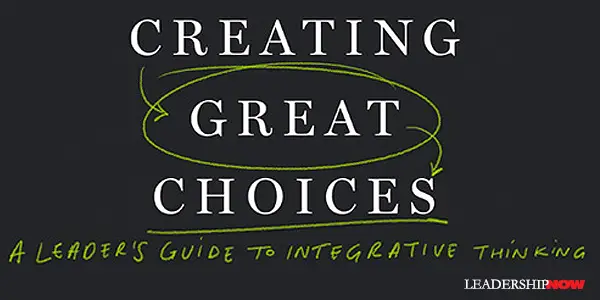
O If we understand that we all have different mental models—our view of how the world works—we use those various models to improve our own. Once we see things in a certain way, it becomes very difficult to see things in a new way. Integrative thinking is a method to do just that. Roger Martin introduced the practice of integrative thinking in his book, The Opposable Mind. “The opposable mind is one that can use the tension between a set of ideas to create new and superior answers to challenging problems. This follow-up book, written by Martin and adjunct professor Jennifer Riel, Creating Great Choices, provides the methodology to do just that. Martin finds that there are three elements missing from most decision-making processes: metacognition, empathy, and creativity. When employed, metacognition allows us to understand better our own thinking and existing mental models that influence our decisions and the choices available to us. Empathy allows us to understand the thinking of others, which in turn illuminates the gaps in our own thinking and areas where we might connect with others. Finally, creativity provides the imaginative spark to create new and better choices rather than just accepting the options held in tension before us.
Articulate the Models Step one is to Articulate the Models, that is “to frame the problem and tease out two opposing models for solving it.” What are the core elements of each model? The idea is to create a two-sided dilemma from a general problem like whether to use a centralized structure versus a decentralized structure or consumer needs versus shareholder expectations. Ultimately you will not choose between the two, but to use the two models or approaches to create a better choice. The outcome we will look for, won’t be a compromise between the two choices, but a choice that takes the best of both that will produce an outcome that is preferable to the existing ones. Examine the Models Step two is to Examine the Models. While holding them in tension, define the points of tension between the two models or approaches, illuminate the assumptions, and determine the cause-and-effect forces. As you look at the models, ask, what are the forces that drive the most important outcomes or the benefits we most value of each? How might we change how we think about the approach? What is similar? What is different? What benefit would you be loath to give up from each model? Now you want to shift from understanding the models to creating new models, “creatively building from both opposing models to design an answer that is ultimately superior to either one.” Examine the Possibilities So in step three, you Examine the Possibilities. Explore other resolutions. Here there are three directions you might go to find a better choice: the hidden gem, the double-down, or the decomposition. In the Hidden Gem, you take “one deeply valued benefit from each of the opposing models and throw away the rest. You imagine a new approach designed around the two gems.” And “you will need to replace all of the elements you’re throwing away with something new.” “I want one small element of A and B.” In the Double-Down, causality is key. If you identify one of the models as the one you would choose if it just weren’t missing one critical element, you Double-Down. “I want all of A and one key element of B.” In Decomposition, you do both—two contradictory things at once. You will need to “reach a different understanding of the problem you’re trying to solve.” In other words, you will need to break the problem apart and apply one solution to each. “I want all of both.” Assess the Prototypes Finally, in step four Assess the Prototypes to test different possible answers to find an answer that can actually be implemented. Proving an idea that is new is possible only in theory. A new model is possible only if we think differently. “At this stage, gaps in logic are necessarily the sign of a bad idea; rather, they are the hallmark of a new one. Gaps represent an opportunity to clarify and refine what a possibility could be. Possibilities become richer as they become more concrete because there is less abstraction within which to hide.” They recommend that when trying to communicate a new idea, try using storytelling, visualizing, or modeling—words, pictures, and/or objects. Look for ways to disprove the idea or under what conditions might it not work. In this way, you can finds ways to strengthen the idea. What Is Your Stance? Going into any decision-making process, you need to understand your stance—where you are coming from—who you are and what you are trying to do. What informs your thinking? Different stances drive different outcomes. As a leader, your job is to be clear about your own thinking, knowing that your own models or views of the world are at least a little bit wrong. Understand others view of the world to inform and improve your own. And patiently search for answers that resolve the tension between opposing ideas to find the opportunities to create better choices. Integrative thinking isn’t for every problem you face. “But when you find that your conventional thinking tools are not helping you to truly solve a problem, integrative thinking can be the tool that shifts the conversation, defuses interpersonal conflicts, and helps you move forward.” Martin and Riel have included in this integrative thinking user’s guide, templates to help you work through each of the four steps. Keep it handy. 
Posted by Michael McKinney at 09:49 PM
07.10.17

The Mathematical Corporation
Y A mathematical corporation is one that takes advantage of machine intelligence by collaborating with it to achieve leading-edge results. It will require a shift in your thinking. “As a leader,” say Josh Sullivan and Angela Zutavern in The Mathematical Corporation, “you need to evolve your focus to excelling through imagination, creativity, reasoning, and problem structuring.” Leading in the era of the mathematical corporation means learning to work with the machine to investigate mountains of data not by braking them down, but by keeping them together to mine insights never before imaginable. It means being able to distinguish what machines are good at doing from what people are good at doing. When people and machines are appropriately paired we can explore heretofore impossible strategies and execute incredible solutions. Machines will not replace people but we will need to develop and capitalize on some uniquely human skills. “People will continue to be better than machines at many of the loftiest cognitive tasks, like asking questions to clarify a problem, composing experiments to test hypotheses, and drawing on truths in one discipline to elicit insights in another.” Because of the machine’s ability to synthesize vast amounts of data, it would be wise to question your own judgments when machines offer a different conclusion from your own. Machines, for example, can recognize patterns better than we can. That said, “computers don’t know the cause of a pattern. They don’t have the human appetite to get to the bottom of the matter, and they don’t ask, ‘Just how does cause A lead to effect B?’ They learn, infer, and have high recall accuracy, but they don’t know the story of cause and effect. So, the task of taking a cause-and-effect understanding of a business system and crafting a strategy from it remains a people job.” Getting the Questions Right While Big Data adds complexity, it is only a problem if you don’t know how to mine it for value. The key skill for leaders is to be able to ask better questions than to offer solutions. Asking the right questions is critical. Poor questions lead to questionable insights. “That’s why as a leader, you need to remain at the tip of the process, seeing the world in a much broader and more differentiated way than others.” Not only asking the right questions but removing our own biases from them, will bring us breakthrough insights and more nuanced answers. Another issue we will have to work through is not projecting our limitations and constraints on the machine. Although we have a mental model that we filter the world though, we must be careful not to constrain the machine—our questions—in the same way. What About Intuition? In the mathematical corporation, the role intuition will shift from judging reality to judging models. “No matter your feeling on intuition, its role is destined to shift to a smaller, if still critical position. As machine intelligence converts implicit understanding to exploit facts, replaces implicit assumptions with data-givens, counters biases with hard evidence, we have to admit the superiority of the cold facts encoded in 1s and 0s.” Often it will require a leap of faith on our part. We will need to learn to ask bigger questions and questions that will lead us to better questions. The best machine collaborators will see this as a learning journey. “Conventional strategic planning practice calls for a relentless search for answers during a detailed analysis of context and a relentless analysis of the opportunity to find the right answer in one go. But when the answer is over the horizon, no amount of analysis of the landscape up front will reveal it. You need to go on a learning journey—sailing to the far shores to find the best answer.” It requires a commitment to a cycle of questioning and learning, questioning and learning. As digital technologies continue to develop and improve, leaders will need to become wise and discerning leaders of machines. Leaders will not only be expected to use this technology to their advantage to solve their own organizational issue but to help answers the questions that exist beyond their own walls.  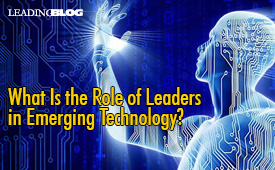 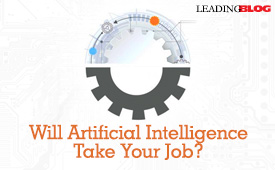
Posted by Michael McKinney at 05:24 PM
03.24.17

The Caterpillar's Edge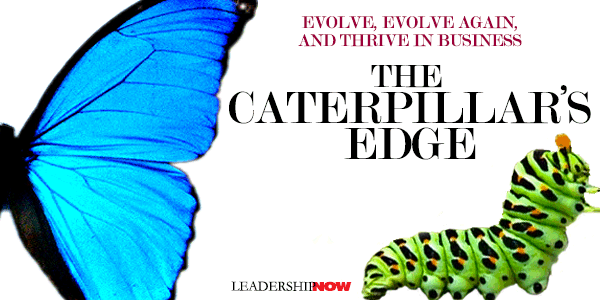
T Sid Mohasseb writes in The Caterpillars Edge that “to realize an improved future you must purposefully leave the past behind, and embrace the uncertainty ahead—constantly and without fear. You must evolve, then evolve again and thrive.” The problem as Mohasseb sees it is that many leaders are stuck in their approach to planning and execution. “They are guided by old habits formed in an era when competition was more static.” The data you are using can’t be captured in a fixed plan or you’ll have an excellent strategy for the year before. Your planning and execution needs to be more dynamic than that. We need a new and more agile approach. “The world will not wait while you contemplate, take time to gather enough data to be exhaustive in your analysis, and then build consensus around actions.” You can improve your “likelihood of winning by constantly reading and applying the incoming data points.” “You must learn and live and compete in an uncertain and always changing reality.” Prefer change to the comfort of stability. There are three crucial rules to be applied here: 1. Align with Uncertainty—Adjust to the dynamic world around you. Be prepared to shift your focus at all times. The market is shifting. By the time you transform, the advantage you wanted may be long gone. 2. Appreciate Reality—Understand what is practical and achievable by you and your company. You can evolve over and over. 3. Aspire for More—Seek more data, more analysis, and more “Aha” moments or move faster to reach the moments of insight, where the solutions to problems become clear. McKinsey reports that eight out of ten times strategists focus on known hypothesis—opportunities that have been examined in the past or are already evident. “Most people use analytics in the context of consumer-level transactions. But there is no lasting strategic advantage. When people claim that they are competitive because they are using analytics, that’s just the flavor of the day. Now unless you tell me that you have used data analytics in order to find a new product ground, a new design, and a new market, you are not strategic . . . as opposed to let’s sell more shoes to the guys who are buying shoes . . . what is being done for the most part today is a kind of a tit for tat, and that’s what I see most people calling gaining competitive advantage.” Optimizing today’s processes for greater efficiency does not necessarily offer an advantage for tomorrow. Use the force and create the future. Don’t use the data to justify your actions, use it to discover advantages. It’s not the analytics, but the execution. Analytics is just and tool and soon will be found and used by everyone everywhere. As that occurs, the “business basics of good strategy and execution will, once again, drive the lasting victories.” A winning strategy must be adaptable from the start. Be prepared to improvise. Selected Caterpillar Edge advice:

Posted by Michael McKinney at 12:34 PM
02.24.17

Asking the Right Questions Often Leads to the Best Answer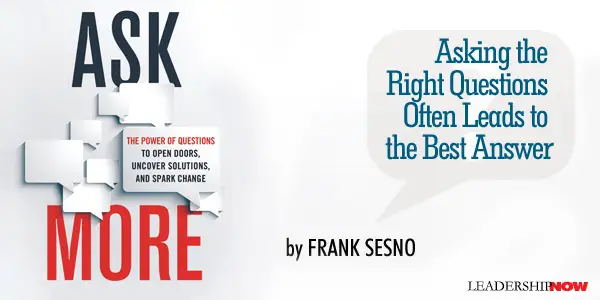
BEING A LEADER often means making far-reaching decisions that require major investments of time, resources, and energy. Complete certainty is seldom possible. Competing agendas often complicate the process. The future is never something you can take for granted. So you need to be as dispassionate as possible in how you examine opportunities and vulnerabilities. Knowing how to ask the right questions is essential to sorting through the options, clarifying objectives and making the best decision possible. Good leaders are adept at asking strategic questions. These are the types of questions that deepen understanding and look over the horizon. By asking more of these questions – of yourself and others -- you articulate goals, set benchmarks and assess risk. You become a better thinker and a smarter leader. Strategic questions zoom out and look at the big picture. They ask about long-term goals, interests, and priorities. They consider alternatives, consequences, and downsides. They sharpen the focus on the larger objective and clarify what it will take to get there. Strategic questions break into distinct categories. Big Question: Cost and Consequence: Trade-offs: Alternatives: Define Success: Listen: Try: CEOs are often the most successful people. Many of them possess a hidden skill – the ability to ask questions that help envision the future, assess risk and reward, and anticipate trends.  
Posted by Michael McKinney at 07:25 AM
01.22.16

Why Most People Never Learn from Their Mistakes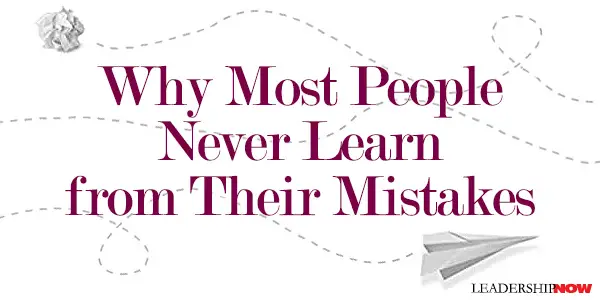
THE purpose of Black Box Thinking is to describe how success happens. Progress hinges on how we react to failure. In two of the most safety-critical industries – aviation and health care – the approach to failure is very different. And the results highlight the problem. For commercial aviation on Western-built jets, they have only one accident per 2.4 million flights. In health care, the equivalent of two jumbo jets are falling out of the sky every twenty-four hours making preventable medical error in hospitals the third biggest killer in the United States behind only heart disease and cancer. The problem lies in how they approach failure. “A failure to learn from mistakes has been one of the single greatest obstacles to human progress.” For all of the talk about not being afraid of failure, we are not learning what we should. Our organizational and personal cultures tend to evade and cover-up the issues. How do we react when something has gone wrong?  The author, Matthew Syed, describes black box thinking as “the willingness and tenacity to investigate the lessons that often exist when we fail, but which we rarely exploit. It is about creating systems and cultures that enable organizations to learn from errors, rather than being threatened by them.” Why? “Failure is rich in learning opportunities for a simple reason: in many of its guises, it represents a violation of expectation. It is showing us that the world is in some sense different from the way we imagined.” Nicely put. Learning from failure is easier said than done. The more we have at stake (especially our egos) the more likely we are to manipulate the evidence. Consider this: When we’re confronted with evidence that challenges our deeply held beliefs we are more likely to reframe the evidence than we are to alter our beliefs. We simply invent new reasons, new justifications, new explanations. Sometimes we ignore the evidence altogether. One of the difficulties we have when analyzing failures (and analyzing success for that matter) is that we rely on information based on hunches. Our intuitions are often wrong. We need to get down to the details so we can isolate the effect of any action so we are solving the right problem. David Brailsford, the general manager of the British cycling Team Sky put it this way: “People think it is exhausting to think about success at such a high level of detail. But it would be far more exhausting, for me anyway, to neglect doing the analysis. I would much rather have clear answers than to delude myself that I have the ‘right’ answers.” An organization (and even individuals) can go on for decades thinking that their success is linked to a particular factor when in reality it is the cause of their failures. And they never make the connection because their assumptions have never been tested or analyzed. We must change our relationship with failure. We are not born with a fear of failure. It’s how we learn. It’s only over time that we are taught a fear of failure and lose our growth mindset. We can only improve in environments where we have the right kind of meaningful feedback. Fear of failure is not the real enemy; it is recrimination and defeatism that often accompanies failure. We need to eradicate blame and encourage growth responsibility. Syed writes: “If we drop out when we encounter problems, progress is prevented, no matter how talented we are. If we interpret difficulties as indictments of who we are, rather than pathway to progress, we will run a mile from failure. Grit, then, is strongly related to the Growth Mindset; it is about the way we conceptualize success and failure.” Through the use of a wide variety of examples, Syed pushes you to think differently about failure and success. More importantly, he teaches us how to look beyond our easy answers and effectively get to the real issues and causations. 
Posted by Michael McKinney at 09:13 AM
02.19.15

6 Skills You Need to Win the Long Game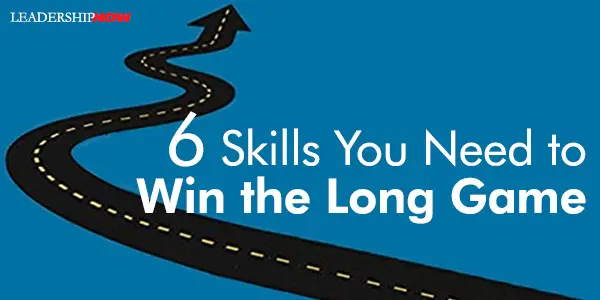
BRIAN DODD says he doesn’t like meetings but he loves strategy sessions because they are about movement and focus on accomplishment, not activity. They “make you glad you are a leader.” I presume he would agree with authors Steven Krupp and Paul Schoemaker. They say the number one business challenge for winning the long game is for leaders to become more strategic. In Winning the Long Game they write that “In times of crisis and change, when people are confused about what to do, ordinary leadership must rise to the level of strategic leadership.” The trick is to deliver short-term results while securing long-term viability. Especially in uncertain times, “companies must tilt more toward strategic leadership than toward operational excellence.” Strategic leaders need two perspectives: outside in and future back. Outside in means that a “strategic leader starts with the external marketplace when addressing problems, without getting wrapped up by internal organizational issues.” Future back means that when playing the long game strategic leaders use their long-term vision to guide their short-term decisions in a flexible way.
Anticipate: Strategic leaders are constantly vigilant, honing their ability to anticipate by scanning the environment for signals of change. They develop and maintain an external mindset. How quickly do you spot ambiguous threats and opportunities on the periphery of your business? (Chapter 1: Elon Musk) “Once a company becomes the master of its own universe, seeing new developments in adjacent markets becomes harder. Challenge: Strategic leaders question the status quo. Pope Francis is listening to new voices and deliberately bypassing old channels of communication. Open a window to let in fresh air and look in the mirror. Are you comfortable with conflicting views and differences in opinion? How often do you question your own and other people’s assumptions? (Chapter 2: Sir Richard Branson, Pope Francis) “Opening the window is the practice of promulgating outside perspectives to see complex issues in context. Looking in the mirror is the practice of deep self-reflection, whereby leaders confront outmoded beliefs, faulty assumptions, and stubbornness in themselves and others.” Interpret: Strategic leaders amplify signals and connect multiple data points in new and insightful ways to make sense of complex, ambiguous situations. Can you pick up on signals to distinguish anomalies from leading indicators of change? What are you not seeing or hearing? We begin by recognizing the facts and then “re-cognizing,” or rethinking, them to expose their hidden implications. (Chapter 3: Charles O. Holliday Jr.) “Leaders get blindsided not so much because they aren’t receiving signals but because they aren’t exploring alternative interpretations, or they get locked into one piece of the puzzle.” Decide: Strategic leaders seek multiple options to ensure flexible decision-making. They don’t get prematurely locked into simplistic yes/no choices. How often and how quickly must you make tough calls with incomplete information? (Chapter 4: Angela Merkel, Laurence Golborne) “Exploring options means having the wisdom, cool-headedness, and perspective to consider all of the alternatives available. Showing courage means demonstrating the fortitude to commit to the right solution and, if that solution proves ineffective, critically stepping back to reconsider.” Align: Strategic leaders engage stakeholders to understand change readiness, manage differences and create buy-in. They are adept at finding common ground. This requires active outreach. Good communication is key. Do you regularly engage your managers’ direct reports in decisions that affect their work? Where do you stand with the people you need to influence? (Chapter 5: Alex Ferguson) “There is an interconnectedness now in problems—and this changes the issues. You need to have more people involved with the decision making, leaving the leader less in control of the situation.” Learn: Strategic leaders continuously reflect on successes and failures to improve performance and decision-making. I like this chapter title: My Gift Was Not Knowing. It sums it up well. A quarter of a century after the publication of Peter Senge’s The Fifth Discipline, “the learning organization still does not have much of a foothold in the business world, despite skyrocketing uncertainty.” When was the last time you admitted you were wrong—in public? (Chapter 6: Reed Hastings, Sara Blakely) “Leaders must make their moves when the future is still ambiguous. If an organization is continually learning, then everyone is primed for change and ready to move in a different direction each day.” 
Posted by Michael McKinney at 11:27 PM
01.02.15

Are You Trapped in Survival Mode?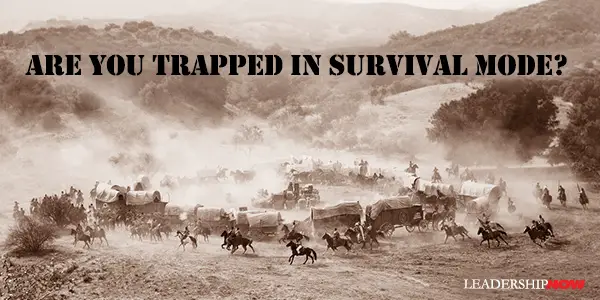
THOMAS PLUMMER is a coach to the fitness industry. In a Facebook post he advised fitness professionals: The mindset of survival that keeps you alive in tough times is also what will kill your business during good times. Keeping a struggling business alive during tough markets is a skill that drains the life out of you. Everyday you fight for pennies, do the work of many and learn the techniques necessary to keep going when others are failing. This same mindset is also what leads to failure for these owners during good times because they forget how to attack the market and grow the business. Most often the thing that got us to where we are is not the thing that will get us to the next place we need to go. Sometimes we get so focused on what we have become good at, that we miss the changes around us. It’s easy to get stuck repeating what we’ve always done. When we do we come from a place of weakness rather than strength. Inertia can keep us from considering the possibilities. Reintroduce possibilities into your thinking. Survival isn’t enough to give your life to. It’s a self-defeating approach to life. Choose to be remarkable.
Posted by Michael McKinney at 10:53 AM
09.04.14

Why Reframing is Important to Great Leadership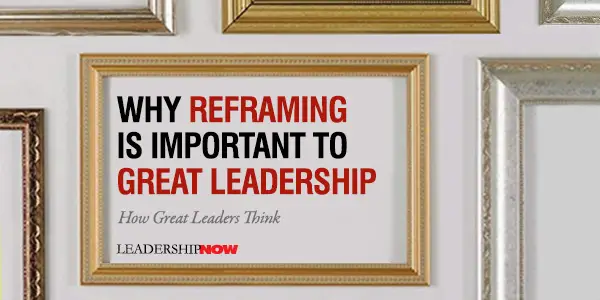
LEADERS need to be able to look at the situations they face from different perspectives. The need to be able to reframe a situation in order to understand what it really going on and deal with it effectively. A leader’s “ability to reframe sets them free” and helps them to “avoid getting trapped in cognitive ruts,” write Lee Bolman and Terrence Deal, authors of How Great Leaders Think. “Leaders can expand how they think by using different mental models to determine what’s going on and what to do in complex situations.”Bolman and Deal are the authors of Reframing Organizations. They have taken the model they introduced there and applied it specifically to leadership. The model has four frames, scripts, or perspectives. Each has its advantages and shortcomings and we tend to lean towards one more than the others. This idea, of course, is to develop the ability to use the appropriate frame or script to generate a unique approach to handling challenging circumstances instead of relying upon our tried and true default approaches. Our single approach will only be “right” a small percentage of the time. Too often leaders will approach everything they deal with the last approach and insist they are right as they head right over the cliff. They insist that the world is as they see it. To grow is to recognize your blind spots. The four frames are: Structural — Leader’s role as architect. An emphasis on finding the right design for the task at hand. Structural leaders help groups get clear about why they’re there, who is in charge, who is supposed to do what, and how team members can work with on another to achieve the group’s purpose. Human Resources — Leader’s role as coach. The central theme is improving the fit between the individual and the organization and begins with caring—or in a word, love. Leaders who commit themselves to key practices of effective people leadership—developing a philosophy for managing people, hiring the right people, keeping employee investing in their future, empowering them, and promoting diversity—have repeatedly built businesses that thrive on the strength of employee talent, energy, and creativity. Political — Leader’s role as peacemaker. Organizations and societies are networks as well as hierarchies, and the power of relationships is a crucial complement to the power of position. Misreading the political map and overlooking the power of potential players can lead to catastrophe. That’s why it’s critical to treat the map as a work in progress—a guide to be tested as you move along. Symbolic — Leader’s role as storyteller. The central theme is the way humans discover and create meaning in an ambiguous and chaotic world. Symbolic leadership begins with the leader’s deeply rooted faith and passion. Symbolic leaders infuse magic into organizations through their artistic focus on history, shared values, heroes, ritual, ceremony, and stories, and serve as icons who embody a group’s values and spirit. The authors write: “Consciously or not, we all read situations to figure out what scene we’re in and what role we’ve been assigned so that we can respond in character. But it’s important to ask ourselves whether the drama is the one we want and recognize that we have latitude as to which character to play and how to interpret the script.” The authors provide practical lessons from examining these frames through the leadership of Jeff Bezos, Howard Schultz, Tony Hsieh, Ursala Burns, Steve Jobs, and others. 
Posted by Michael McKinney at 07:51 PM
01.20.14

8 Reasons to Seek Out Ambiguity
C Ambiguity makes us uncomfortable so we want things ordered as soon as possible. But if we move too fast, we can miss out on the value that ambiguity brings. We need to embrace ambiguity until we have rung the last drop of value out of it. Ambiguity draws attention to what we don’t know.
Ambiguity and order are tensions to be managed. There is a time and a place for both. Generally speaking, order reproduces—ambiguity creates. Order helps us to leverage our resources. But if we rush too fast to establish order we set ourselves up to repeat the thinking that got us to the point of needing the change in the first place. If we don’t allow ambiguity to do its work, then we might find that the order we establish is incomplete—not well thought out—and doomed to failure. Functioning with ambiguity requires a great deal of emotional intelligence—the ability to control your emotions, perceive other’s emotions and to facilitate the expression and understanding of all emotions. Without ambiguity we become dinosaurs.
Posted by Michael McKinney at 01:36 AM
12.23.13

2 Ways Organizations Obstruct Insights
WE all want insights—the new thinking that “shift us to a new story, a new set of beliefs that are more accurate, more comprehensive, and more useful.” But we often don’t want the disruption they bring because insights have the power to change how we act, think and feel. In Seeing What Others Don’t, author Gary Klein says that organizations stifle insights because we value predictability and crave perfection.We fall into the predictability trap because we are “so captured by the lure of predictability” that we make it too high a priority. In short, we like the status quo. Managing people is easier when we know what we are doing and we are doing it in a certain way. Insights can change how we relate to each other and that creates the unexpected. “Insight is the opposite of predictable.” Organizations don’t like errors and try to eradicate them. Mistake-free performance helps keep things on track and running smoothly. “It’s much easier and less frustrating to manage by reducing errors than to try to boost insights. You know how to spot errors. You don’t know how to encourage insights other than hanging inspirational posters on the walls.” Even though insights can improve on perfection, perfection gets the job done. Why rock the boat? "In well-ordered situations, with clear goals and standards and stable conditions, the pursuit of perfection makes sense. But not when we face complex and chaotic conditions, with standards that keep evolving.” “The actions we take to reduce errors and uncertainty can get in the way of insights. Therefore, organizations are faced with a balancing act. Too often they become imbalanced and overemphasize … reducing errors and uncertainty.” To increase certainty and reduce errors we tend to:
All of these have benefits to organizations and individuals, but the problem arises when they are pursued with so much zeal that they interfere with insights. They can squelch thinking and reflection and lead to robotic behavior. Insights are dis-organizing, but we need them to stay relevant and grow. 
Posted by Michael McKinney at 03:43 PM
10.16.13

5 Steps to Thinking in New Boxes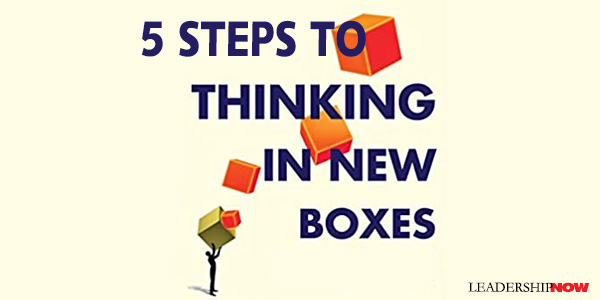
THINKING outside-the-box is a useful metaphor for thinking creatively or trying to get out of a rut. But practically speaking, it’s not going to happen. Your brain just doesn’t work that way. Your brain needs boxes. You can’t think without them. We create and use mental boxes to organize and use what we know. The reality is, getting out of one box means getting into another. Thinking outside-the-box really means finding a new box. A new box with different assumptions, prejudices, beliefs, and parameters. A different box will give you different answers because it forces you to ask different questions. In Thinking in New Boxes, authors Luc de Brabandere and Alan Iny say that the improved solution will be found in a new box. Here’s the key thought: “Since your brain needs models or boxes to think, the key to being creative in practical ways, to managing change during these times of such uncertainty, is to first try to understand your existing boxes to a greater degree, and then attack any situation or issue by developing a range of new boxes. You can then carefully choose which box(es) to use, even as you embrace the ambiguity inherent in doing so.” Based on how the human mind actually thinks and reasons, the authors have developed a five-step approach to thinking in new boxes: Step 1: Doubt Everything
Step 2: Probe the Possible
Step 3: Diverge
Step 4: Converge
Step 5: Reevaluate Relentlessly
Thinking in new boxes is first about being aware of the box you’re in and why you’re in it. The reason many find it difficult to change – to move to a new box – is because they don’t know why they think and do what they do. Once you do, it’s easier to see where you need to go and what you need to do. 
Posted by Michael McKinney at 11:46 PM
10.09.13

The Good Struggle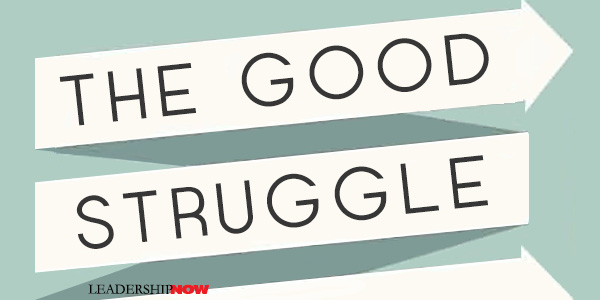 NOT surprisingly, Joseph Badaracco has written an essential read for leaders of all kinds. The Good Struggle addresses the question of how to lead successfully and responsibly in our uncertain, high pressure, turbulent world.
NOT surprisingly, Joseph Badaracco has written an essential read for leaders of all kinds. The Good Struggle addresses the question of how to lead successfully and responsibly in our uncertain, high pressure, turbulent world.
Badaracco says that the inescapable pressures of leadership are intensified today because of the market-driven world in which we live. “Almost everything—how we manage our organizations and our lives, how we make decisions at work and at home, and even how we think about ourselves—is deeply shaped by markets and market-based thinking.” This creates greater uncertainty, obscures right choices, and puts pressure on us to abandon principles that we used to rely on. Responsible leaders find themselves engaged in the good struggle: “a long effort, demanding perseverance and courage, to make good on serious but profoundly fallible commitments in an uncertain and often unforgiving world.” He adds, “Struggle has always been central to accomplishing anything worthwhile, and this is especially true today.” He offers five enduring—inescapable—questions. Responsible leadership consists of thoughtful and lived answers to them. Am I Really Grappling with the Fundamentals? “The first responsibility of leaders is intellectual. It is the struggle to develop—to the extent possible—a deep, careful, analytical, data-driven understanding of the driving forces in the markets and society around them and to keep this understanding loose, flexible, and revisable.” Grasping the fundamentals can “reduce the chance of being blindsided, by encouraging the mental habit of looking for emerging patterns and odd developments with larger implications. It also promotes modesty, a healthy, low-level paranoia, and vigilance rather than hubris.” He notes that everything now is modular—constantly being recombined. “Recombination also makes it much harder for leaders to inculcate values when people in their organizations know they and their leaders are basically modules in a plug-and-play world and could be moving on soon. The natural instinct is to take care of yourself, here and now.” What Am I Really Accountable For? “Without clarity about accountability, leaders and their organization can drift or zigzag aimlessly.” Of course, many leaders do not want to be accountable to anyone or anything. “Accountability originates in an obligation to make good on the spirit of some jointly designed, provisional, and evolving objectives.” Here’s the question for any leader: “What pressures, scrutiny, and risks do we want to create or invite in order to build a strong, resilient, responsible organization?” How Do I Make Critical Decisions? We need a broader view of critical decisions. Instead of viewing them as deep, abiding pledges that we must make good on, we need to see them more as evolving commitments. That is, “a pledge, by a leader and an organization, to move in a particular direction, but to do so in a flexible, open-ended way.” Decision making has to be as fluid as the markets around them. “Execution as learning.” “Instead of periodic big decisions, responsible leaders make or orchestrate an unending series of smaller ones—all aimed at some larger, broad, flexible objective.” Do We Have the Right Core Values? Values are important because “they may be the only force that can counter the power of markets and market-based thinking….Today’s ever-present markets have their own implicit values, and they can easily overwhelm whatever values leaders want to instill in their organizations.” To lead responsibly, leaders must commit to “clarity, meaningful projects, and bright ethical lines. In different ways, each of these helps leaders and organizations respond to the risks and opportunities created by pervasive market forces.” Why Have I Chosen This Life? People seek positions of leadership not despite the struggles involved, but because of them. “Responsible leadership is a challenge that—despite its inevitable risks, frustrations, and failures—demands and merits the best efforts of talented men and women, tests their competence and their characters fully, gives purpose and intensity to their lives and helps them lead the kind of lives they really value.” The purpose of our struggle matters. Badaracco writes, “If the purpose of life is ease and comfort, no sensible person would take on the demands of leadership.” Perhaps in developing leaders at all levels we need to change that very prevalent mindset. Without it we can’t discover what we are and the person we are meant to be. Badaracco doesn’t offer hard answers because they are evolving answers and should be individual answers created from introspection and reflection. But the insights and provocative concepts are enough to get you thinking in new ways. 
Posted by Michael McKinney at 11:24 AM
05.03.13

How to Make Better Decisions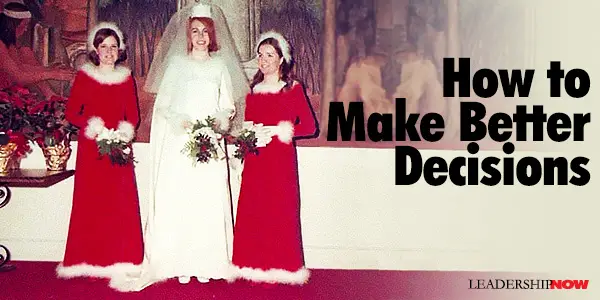
"Why do we have such a hard time making good choices?" ask Chip and Dan Heath in Decisive. "A remarkable aspect of your mental life," says Daniel Kahneman, "is that you are rarely stumped." We have opinions about nearly everything and are quick to jump to conclusions based only on the information that is right in front of us. We often just go with our gut. And that hasn't always served us well. • An estimated 61,535 tattoos were reversed in the United States in 2009. • Forty-one percent of first marriages end in divorce. • Forty-four percent of lawyers would not recommend a career in law to young people. • Eighty-three percent of corporate mergers and acquisitions fail to create any value for shareholders. The Heath brothers have identified “four villains” when it comes to making decisions:
What can we do? We can counteract our tendencies with these four strategies the authors call the WRAP Process from the first letter of each step:
Making better decisions is a choice. This process will help us to make better choices.

Posted by Michael McKinney at 12:09 AM
03.29.13

Six Ways to See the World through New Lenses—and Lead More Effectively How we see the world—our leadership perspective—shapes our thoughts, decisions, and actions. That perspective is based on the sum total of our knowledge, experiences, and choices up till now. It represents the way we view ourselves and situations, how we judge the relative importance of things, and how we establish a meaningful relationship with others and everything around us. Lots of leaders are smart, but few are wise. Smart leaders view the world through lenses that skew or limit their perspective, affecting their decisions and actions. Some focus on short-term goals and on deepening their depth of knowledge in their domain of interest. Others have a long-term vision that enables them to differentiate various patterns and see how these will help them succeed. Both perspectives are limiting. When they remove those lenses, smart leaders gain a broader perspective, which gives them the opportunity to become wise. By changing their "smart" perspective and cultivating practical wisdom instead, they can lay the foundation for a wise leadership style that's more effective. With the wise leader perspective, one is able to continually reframe and reinterpret events through integration and find new meanings within a rapidly changing context. Guided by a noble purpose, wise leaders cultivate a flexible and resilient mindset that helps them act and lead with wisdom--and become more influential leaders. To move from a smart leader perspective to a wise leader perspective, start by seeing the world through new lenses. Here are six ways to do it:
Prasad Kaipa and Navi Radjou are coauthors of From Smart to Wise: Acting and Leading with Wisdom. Kaipa is a CEO advisor and coach and a senior fellow at the Indian School of Business. Radjou is an independent strategy consultant and author of the NYT bestseller Jugaad Innovation. Both based in Silicon Valley, they write popular blogs for HBR.com, speak and consult internationally, have been featured prominently in the national business media, and are esteemed thought leaders in the field of leadership development and innovation. Learn more at www.fromsmarttowise.com. 
Posted by Michael McKinney at 08:02 AM
01.21.13

5 Things Smart Risk Takers Do Well Doug Sundheim’s book, Taking Smart Risks, isn’t really about making your next risky decision smarter or safer; it’s about pushing all of your choices to be riskier, but smarter on a daily basis.
Doug Sundheim’s book, Taking Smart Risks, isn’t really about making your next risky decision smarter or safer; it’s about pushing all of your choices to be riskier, but smarter on a daily basis.
We tend to view our choices as risky or safe. Safe is good while risky is well, risky. You’re taking a chance with a risky choice; it could lead to ruin. Sundheim says that view doesn’t capture the essence of what taking a risk is all about. Taking a risk is “exposing oneself to the possibility of loss or injury in the hopes of achieving a gain or reward.” It’s really the reason we would consider taking a risk rather than just playing it safe. It’s not an either/or proposition—safe or risky. But because we perceive it that way, we tend to do all we can to avoid risk and stay in our comfort zone. 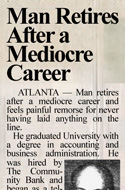 • You don’t win.
Are you caught in the comfort zone? Here’s a thought we can all relate to: Being caught in the comfort zone doesn’t mean that you’re sitting around doing nothing. It’s more nuanced than that. You could be making progress, but not quickly enough. You could be taking chances, but not boldly enough. You could be going out on a limb, but not far enough, and the extra push is what will make a difference. What Sundheim is advocating is a change in our mindset regarding risk. Rather than perceiving risk as negative (“Things may not be perfect now, but they’re not all that bad. If I make a move, things could end up worse. I’d better not risk it.”), we should view it as a balanced focus on both the downside of taking risks and not taking risks (“I’ll regret it if I don’t pursue this thing. I’ve got to find some smart ways to take risks to move it forward.”). A limiting mindset versus a liberating mindset.
Smart risk takers consistently do five things well to disrisk whatever they’re up to:
Communication is a critical element of each of these stages. “At every stage of any risk, improving the way in which you discuss thoughts, plans, and actions is the single most effective way to derisk the risk, that is, to make it smart.”

Posted by Michael McKinney at 10:34 PM
01.14.13

Why We Find it Hard to Change Our Behavior
WE KNOW every behavior begins with a thought. So if we want to have lasting change, the beginning point has to be our thinking. Behavioral change is only surface change if we don’t first change the thinking behind those behaviors. And it won’t stick. It will keep coming out in so many ways we won’t be able to keep up with it because we haven’t changed the thinking behind it. When we look at our behavior we have to understand that there is a thought going on in our heads that is tripping us up. And we have to change that first. Or we’re working on the wrong thing. The question becomes, “What thoughts do I need to change to make my behavior change?” New behavior will automatically follow a change in thinking. One right thought can correct a lot of bad behavior. What am I thinking that isn’t allowing me to see things as I should? As human beings, we latch on to certain ideas and assumptions and they blind us from seeing other options and responses to what life throws at us. We get ideas in our head that can literally block us from seeing other perspectives. Change doesn’t happen in a moment. We’ve had these patterns of thinking and behavior for a lot of years. We have to unlearn some behaviors and then learn and put into practice the new thinking and resulting behaviors. And it just takes time. It’s right thinking over time that brings about lasting change. It’s a process. It’s a long history of repeated behaviors in the same direction that builds character. We have to wake up every day and know that we have a tendency—not just because of our life experiences, but also because of the way that we have chosen to respond to them—to repeat a certain set of behaviors over and over again. We’ve got to remember that and change the thinking that supports these behaviors. We’ve got a lot of set patterns in our heads that we want to return to, that we have become comfortable with, that we can justify, that we can blame on something someone else did. That’s why we have to make a point of reflecting on our behaviors and on the impact we have on the people around us. And learn from it. And then go to work on the thinking behind the behaviors we want to change. It’s not what you do that needs to change, it’s what you think that needs to change. First change your thinking. The behavior will follow. It all starts with a thought.
Posted by Michael McKinney at 06:13 PM
12.21.12

The Success Equation: Separating Luck and Skill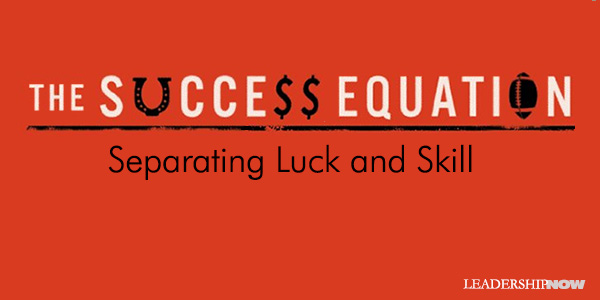
IN the mid-1970s, a man hunted for a lottery ticket with the last two digits ending in 48 for a chance to win the Spanish National Lottery. He found a ticket, bought it, and won the lottery. When asked why he was so intent on finding that number, he replied, “I dreamed of the number 7 for seven straight nights. And 7 times 7 is 48.” You can be wrong and still win—in the short term. Some things are a matter of luck. Some things are a matter of skill. The problem is we have a hard time untangling the two. In The Success Equation, Michael Mauboussin aims to helps us to understand the relative contributions of luck and skill and then how we can use that understanding to make better decisions.Untangling luck and skill is made more difficult because “our minds have an amazing ability to create a narrative that explains the world around us, an ability that works particularly well when we already know the answer.” When we see the effect we want to find (or create) the cause. Baloney-Generator In the left hemisphere of our brain is what Steven Pinker calls the “baloney-generator.” “One of the left hemisphere’s main jobs,” writes Mauboussin, “is to make sense of the world by finding a cause for every effect, even if the cause is nonsensical.” Consequently, we attribute too much to skill, especially in hindsight. “Once something has occurred and we can put together a story to explain it, it starts to seem like the outcome was predestined.”
To understand the relative impact of luck and skill, it is helpful to place activities on a “luck-skill continuum.” Mauboussin shows you how. He also shows why in competitive situations, when you’re the favorite, “you want to simplify the game so that you can overwhelm your opponent. If you are the underdog, you want to inject luck by making the game more complex”—creating new points of competition. In business, “challengers almost never succeed by taking on the established companies in their core markets. The larger companies are simply too strong and too motivated. But they are often too smug to admit that a small, upstart firm could pose a threat. And therein lies the advantage for the little guy.” Building Skill and Improving Your Luck Whether or not you can improve your skill depends a great deal on where your activity lies on the luck-skill continuum, says Mauboussin. “In cases where there is a clear relationship between cause and effect, and in activities that are stable and linear, deliberate practice is the only path to improvement. … For activities near the luck side of the continuum, a good process is the surest path to success in the long run. Feedback is critical in any case. “Improving your skill means constantly looking for ways to change your behavior, either because what you’re doing is wrong or because there’s a slightly better way of doing it. … No matter what your profession or level of expertise, the chances are very good that accurate feedback can improve your performance.” One final thought: Mauboussin presents what he calls the Paradox of Skill. “As skill improves, performance becomes more consistent, and therefore luck becomes more important.” If everyone is getting better, then luck plays a more important role in determining who wins. 
Posted by Michael McKinney at 11:05 AM
11.05.12

Next Time You’re in a Slump, Try Stillpower WHEN our performance is in a slump or we get stuck, we tend to become anxious and reach for any quick fix or technique that promises to get us out of it. We apply more effort, focus, and willpower. And when all of that doesn’t work, we get even more anxious and our performance heads even further south.
WHEN our performance is in a slump or we get stuck, we tend to become anxious and reach for any quick fix or technique that promises to get us out of it. We apply more effort, focus, and willpower. And when all of that doesn’t work, we get even more anxious and our performance heads even further south.
Instead, when we get stuck we need to rely on Stillpower, not willpower says Garret Kramer. Stillpower is the ability to return to a clear mindset after we get into a muddled mental state—a low state of mind. It’s knowing that “all sentiments are temporary since they originate from your own thoughts and moods. Stillpower comes from knowing that self-worth has nothing to do with winning, losing, parental approval, money, fame, or anything external to you.” When we get into a low state of mind we need to do nothing. It’s when we operate from a low state of mind that we usually make mistakes, poor judgments, miss opportunities and dig ourselves deeper into whatever hole we are digging. “Once you understand,” says Kramer, “that as human beings we form our perceptions from the inside out, that the quality of our thinking and level of awareness move up and down independent of our circumstances, you will see that it makes little sense to work yourself through a temporarily low state of mind.” But that’s often exactly what we do. When we run into trouble that’s a sign to step back—not a call to action. Negativity is a sign to slow down. We can't perform at an elevated level when we are in a low state of mind. A seemingly unresolved issue of today has nothing to do with erroneous thinking of today. And until an individual comes to this realization, he or she will always fall prey to the conditions of life itself. Awareness is key. When you are aware of your thoughts and feelings in the moment and when necessary, allow your thinking to clear, then you will have the clarity to act; “insights will flow and answers will become obvious.” He adds, “Insight is infinitely more powerful than willpower. Actually, insight, or having a new idea and/or a change of heart, erases the need for strength or force of will of any kind.” COACHING Kramer notes that when you are coaching or counseling, you need to be operating from a higher level of thinking than the person you are talking to. “What comes out of your mouth is much less significant than the level of mental functioning from which the words are spoken.” We need to interact with people from a state of mind “brimming with love, compassion, and selflessness….External how-to resources are not all that necessary; love will provide all the direction you seek.” Leadership is an all-in proposition. Done right, it’s a lot of hard work. To cut ourselves some slack, we too often rely on external gimmicks and techniques rather than the messy work of a real relationship. IDEAS TO CONSIDER • “We perform better when we get caught up in the experience, rather than when we make the experience about us….When we focus on a personal prize, our options narrow; when we relish the process, our options expand.” • “When we act from clarity, it is impossible to get weighed down by judgmental outcomes.” • “When we succumb to our errant thoughts or closed-off moods, judge another person, and then act from this egotistical perspective of insecurity, it is practically impossible to find long-term success.” • “Every failure, every mistake, every loss—occurs to clarify our path, not to obscure it.” • “You will never wrestle with a choice when your level of consciousness is high.” Leaders will find a lot to consider here. Stillpower is one of those books that makes you reconsider your approach on many things. While Kramer might seem to be throwing the baby out with the bathwater at times, he doesn’t overturn conventional wisdom as much as he calls us on it when we misapply it. It is the perfect prescription for those that have a need to control their world and the people around them. It is important to note too, that looking within for answers is fine if you have consciously put something there to draw-on in the first place. Good flashes of insight are only produced when there is something good to draw upon. Choose your sources wisely. 
Posted by Michael McKinney at 03:57 PM
06.19.12

Are You a Culturematic Maker?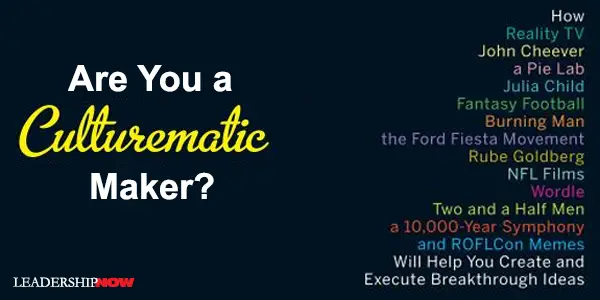
A Culturematic, says author and anthropologist, Grant McCracken, is a little machine for making culture. It is an exercise in edge finding. But at the same time, a Culturematic must speak to us. It must make us go, “Hmm, that’s interesting.” A Culturematic is also an attitude of mind that goes beyond the box of ordinary thinking “not because it is mischievous to do so, but because there might be a world out there and it might be interesting to find out what this world is.” McCracken says that because we live in a world of constant change and because we must adapt to it with an experimental stream of new ideas, we need Culturematics. It is when the problem is too complex or difficult and the solution is not forthcoming that Culturematics shine. Culturematics aren’t sure where they are going. When we aren’t sure what we’re looking at but think, “I’ll know it when I see it,” then we need ideas we can’t possibly guess we will need. “The trick,” says McCracken, “is to invent our own serendipity, to establish a cloud of possibilities in which we can spot the telling pattern.” Start a Culturematic by asking “what if?” Then, try it. The result should discover and distribute meaning. It helps us to see ourselves or something in the world, differently. It should also unleash value—even repurposing value; discovering “value in the artifact the maker does not know is there.” “Culturematics manage a tension between the order of the starting point and the unpredictability and disorder of the ending point.” This is not to say that we point a Culturematic in any direction and pull the trigger. A Culturematic is working with the culture that is already in place, so we point it in the direction where we think we might be able to create meaning and value. Culturematics... • start playing in our heads immediately. They capture our attention.
Fantasy Football, Twitter, and Reality TV are just a few of the examples of Culturematics discussed in the book. More can be found at the Culturematic Pinterest site. Culturematic is not based on entirely new ideas. However, it will not only make you look at the world (and what you are doing) differently, but you will develop a new appreciation for what you see, feel, and think. McCracken explains how to Culturematic yourself or your organization. Worth the read if you’re trying to create meaning and value in the world. 
Posted by Michael McKinney at 05:21 PM
04.20.12

Restoring Your Ability to Choose
WE all like to think we are in charge of our choices. But the fact is that most of the time we are reacting, not choosing. Most of what we label choice is habit. We’re really on automatic. It can even lead us to think that we have no choice. Only when we pause—slow-down to think and reflect—are we exercising our ability to choose. Nance Guilmartin writes in The Power of Pause that a pause is “any space between an action and your reaction.” And it’s vitally important:Today you need the ability to discern what lies beneath people’s words, their reactions, or their silence. If you don’t build the neuropathways in your brain to pause, to momentarily disengage your automatic reactions, you can trigger a chain reaction that derails your best intentions and strategies. Guilmartin lists seven cues that a pause is in your best interest. It’s time to pause if you are thinking, feeling, or saying:
The Power of Pause Method is based on a three-step Effectiveness Equation and twelve Power of Pause practices. The equation: Professional Effectiveness and Personal Fulfillment Not surprisingly, the equation references an all-important addend, humility. Humility should fuel your curiosity and drive the need to pause. Guilmartin explains that “in situations where you think you know enough, pausing to wonder what you don’t know is a vital, even game-changing leadership skill.” The twelve practices are:

Posted by Michael McKinney at 04:36 PM
04.18.12

Master the PRIMES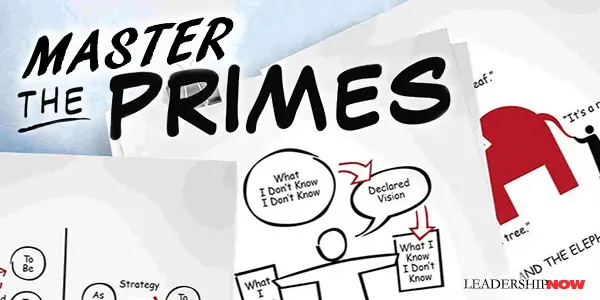
“Master the Primes and you can master leading groups,” says Chris McGoff. The Primes are 46 universal patterns of group behavior that show up every time people join up in groups to solve problems, drive change, and transform systems. Faced with the need for transformative change, a leader’s ability to form and sustain effective groups is critical. The Primes will help you to understand the reasons behind what is blocking the progress of your group. Each of the Primes that McGoff identifies challenges you to take a look at fundamental components of group dynamics by asking key questions. For example, the Change versus Transformation Prime asks, “Are you fixing or creating?” The distinction between fixing or creating is important and requires a different approach. What kind of problem are you trying to solve? Fixing is about making a better, faster, cheaper past. Fixing involves corporate improvement programs like Activity Based Costing, Six Sigma, and others.”These tools are effective when a better past is the desired outcome, but they’re dead weight in the business of transformation.” Creating is about transformation—imagination, declaration, invention, and innovation. The Trust the Universe Prime asks, “Is your vision limited to what you have already seen?” This Prime is a mindset that understands that we don’t know what we don’t know and whatever we need to realize is out there in the future somewhere. But…“Trust in the Universe is a myth. It’s a required myth, an essential myth for any true leader, but a myth just the same. Embracing this Prime is the only real way to create transformative possibilities.” Importantly, McGoff adds, “Leaders understand that although Trust in the Universe promises no guarantees, it gives us the ability to imagine without limit and watch what shows up.”
The Facts, Stories, and Beliefs Prime is the need to distinguish facts from stories from beliefs. There is one of each in the following sentences: “Our revenue was $50 million last year (FACT), and that is simply not enough (STORY). Marketing is inept (BELIEF).” One of the last Primes discussed is an increasingly difficult one: A Clearing. How skilled are you at creating nothing? A clearing in your schedule, your office or meeting place, or your mind: a space where possibilities can exist. The Primes leaves you with plenty to think about. Each concept is illustrated with “back-of-the-napkin” style illustrations and explained with tangible examples. The Primes will show you where you can grow as a leader. 
Posted by Michael McKinney at 11:03 PM
01.03.12

Power Corrupts Sooner than You Think
IN A LETTER to Bishop Mandell Creighton in 1887, Lord Acton observed that “Power tends to corrupt, and absolute power corrupts absolutely. Great men are almost always bad men.” British Prime Minister William Pitt also observed, “Unlimited power is apt to corrupt the minds of those who possess it.” Power is a tricky thing and we rely on it more than we should. In a study by Adam Galinsky and others, they found that when people where power primed—temporarily made to feel powerful—they demonstrated a reduced tendency to comprehend how others see, think, and feel as compared with those that were primed with low power. They relied too heavily on their own vantage points and demonstrated less accuracy when assessing the emotions and thoughts of others. The possession of power or even the feeling of power tends to very quickly change how we think. We easily slip into thinking we are something we are not, to become absorbed with ourselves, to think, “It’s all about me.” Our ego can quickly blind us to reality—self-deception sets in very quickly. We lose self-awareness and therefore our sense of the impact we are having on others. We would do well to remember the Stripes Rule. Denny Strigl, former CEO and president of Verizon Wireless, recalls in Managers, Can You Hear Me Now?: When I became president of Ameritech’s cellular subsidiary, Ameritech Mobile, the chairman of Ameritech told me something that has stayed with me ever since. He said I would be managing an entire company, and as the company’s most senior manager, I should always remember that the “stripes” I have been given are on the coat I wear, not on the person who wears the coat. He cautioned me not to let the job go to my head because when I take the coat off, I will just be a person like any other. Power, it seems, can easily become a handicap and not a blessing to leading well. But it often comes with the territory. A wise leader might keep Lord Acton’s words front and center.
Posted by Michael McKinney at 09:25 AM
12.23.11

What Can Be Done About Biases?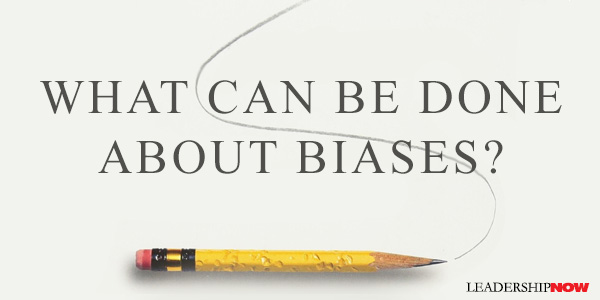
HOW can we improve judgments and decisions, both our own and those for the institutions we serve and that serve us? The short answer is that little can be achieved without a considerable investment of effort. Two systems drive the way we think and make choices: System One is fast, intuitive, and emotional; System Two is slower, more deliberative, and more logical. The way to block errors that originate in System 1 is simple in principle: recognize the signs that you are in a cognitive minefield, slow down, and ask for reinforcement from System 2. 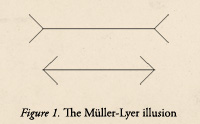 The voice of reason may be much fainter than the loud and clear voice of an erroneous intuition, and questioning your intuitions is unpleasant when you face the stress of a big decision. More doubt is the last thing you want when you are in trouble. The upshot is that it is much easier to identify a minefield when you observe others wandering into it than when you are about to do so. Observers are less cognitively busy and more open to information than actors. Organizations are better than individuals when it comes to avoiding errors, because they naturally think more slowly and have the power to impose orderly procedures. Organizations can institute and enforce the application of useful checklists, as well as more elaborate exercises, such as a reference-class forecasting and the premortem. At least in part by providing a distinctive vocabulary, organizations can also encourage a culture in which people watch out for one another as they approach minefields. Ultimately, a richer language is essential to the skill of constructive criticism. There is a direct link from more precise gossip at the watercooler to better decisions. Decision makers are sometimes better able to imagine the voices of present gossipers and future critics than to hear the hesitant voice of their own doubts. They will make better choices when they trust their critics to be sophisticated and fair, and when they expect their decisions to be judged by how it was made, not only by how it turned out.

Posted by Michael McKinney at 08:21 AM
12.13.11

7 Keys to Managing Willful Blindness
WE can’t escape willful blindness. “It’s a human phenomenon,” admits Margaret Heffernan, “to which we all succumb in matters little and large.” She explains in Willful Blindness, that it doesn’t always bring us to a disastrous end, it also oils the wheels of social intercourse and it is not inevitable but it is persistent. Sometimes we do have the courage to see. “When we confront facts and fears, we achieve real power and unleash our capacity for change.” Our brain likes the familiar. It doesn’t operate in neutral. There’s always a bias. “Our blindness grows out of the small, daily decisions that we make, which embed us more snugly inside our affirming thoughts and values. And what’s most frightening about this process is that as we see less and less, we feel more comfort and greater certainty.” An aspect of willful blindness, self-deception, is the topic of Robert Trivers’ The Folly of Fools. He asks, “Why do we possess marvelous sense organs to detect information only to distort it after arrival?” Although we gather an “exquisitely detailed perception of the outside world, as soon as that information hits our brains, it often becomes biased and distorted, usually without conscious effort.” It’s a fascinating work, but even Trivers can’t help himself from selective recall and arguments molded to fit his own biases here and there. We are all right in our own eyes. It’s difficult to share examples of blindness without exposing our own blindness. Heffernan notes, “when we work hard to defend our core beliefs, we risk becoming blind to the evidence that could tell us we’re wrong.” What can we do to escape our own self-deceptions and willful blindness? Maybe the best we can do is to balance our biases. Heffernan suggests several ways we can manage our blindness: Reexamine Your Life. When we are younger we do it more frequently. But at some point, we stop doing it. “Is it that it gets too draining to keep questioning your life?” Travel between Perspectives. Hannah Arendt calls it “thinking without a banister.” Traveling between points of view can be risky, says Heffernan. “But in the intersection between disciplines, real insight can be gleaned.” Recognize the Homogeneity of Our Lives. Put more effort into reaching out to those that don’t fit in. “Diversity, in this context, isn’t a form of political correctness but an insurance against the internally generated blindness that leaves [our Congress, corporate boards, think tanks and churches] exposed and out of touch.” Know the Limits of Our Cognitive Capacity. Go home. Working long hours taxes our cognitive capacity. Exercise. “The only exercise that seems to nurture, or at least protect, our brains is aerobic exercise.” Seek Disconfirmation. Hire dissent. This is most critical and often the most strongly opposed. “The ability to endure or even welcome debate and conflict requires practice and protection….You need to create a state in which [employees] have the courage to do something. You want to build organizations where everyone sees provocation as one of their essential roles.” Too many leaders are saying, “Why are they questioning me?” or “That’s none of their business.” Get a thinking partner for that third opinion. (See Bill George’s True North Groups.) Professional “third opinion” Saj-Nicole Joni, told Heffernan: Having a small network of people, who will bring you the unvarnished truth and with whom you can have unfettered exploration, are a partial antidote to willful blindness.Heffernan adds: “Outsiders—whether you call them Cassandras, devil’s advocates, dissidents, mentors, troublemakers, fools, or coaches—are essential to any leader’s ability to see.” Challenge Complexity. Provoke skepticism around complexity. “Many organizations view their impenetrability as a feat of fantastic intellectual virtuosity. In reality, it’s a huge cause of blindness and explains why, when such companies get into trouble, they can’t find their way out of it.” Endure the Noise. Silence—fear of debate, fear of debate—becomes self-perpetuating. “Without conflict, everyone remains afraid and blind…We need to celebrate those that make the noise, heroes more inspiring than talent contest winners and drunken movie stars.” Heffernan concludes that seeing starts with simple questions: “What could I know, should I know, that I don’t know? What am I missing here?”

Posted by Michael McKinney at 12:45 PM
09.05.11

Ones Should be CEOs, Twos Should Not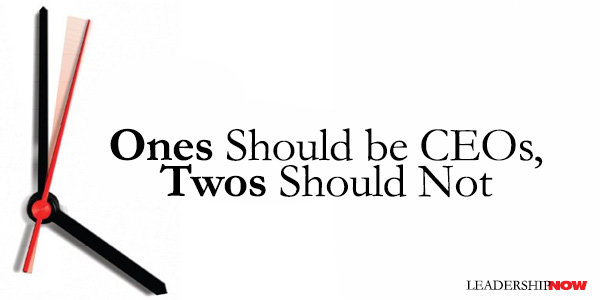
TECHNOLOGY is reaching a breaking point. The amount of data is even overwhelming computing capabilities. A new model of information technology is needed. A new model is being found by applying the predictive nature of the brain to the way computers "think." Wayne Gretzky has famously said, “I skate to where the puck is going to be, not where it has been.” Sports commentators would say that he seemed to be two seconds ahead of everyone else. In The Two-Second Advantage, authors Vivek Ranadivé and Kevin Many write, “Like Gretzky on ice, the most successful people in various fields make continual, accurate predictions just a little ahead of and little better than everybody else.” They don’t need to be able to see ten years out; just enough ahead will do the trick.Part of what is going on in the brain is a function called “chunking.” Predicting and chunking go together by looking for patterns and predicting outcomes. We chunk all types of information. It makes us efficient. If we didn’t chunk, we would think about everything as if it was for the first time. Teaching computers to do this will make them more useful—“two-second-advantage” predictive technology. What caught my attention in their discussion of predictive thinking—from a leadership standpoint—was the idea of two types of leaders found at the top of organizations: Ones and Twos.
Ones tend to be founders. They are bullheaded and courageous. They tell people what to think, not what they think people want to hear. They see openings and get flashes of creativity—like Gretzky in a hockey game. They can take in everything that is happening at a company and see it from a higher level, the details blurring into instinct. Bill Gates is a prototypical one; Steve Ballmer is a two. Steve Jobs is a classic one. The authors say that ones should be CEOs, and twos should not. Of course, a good CEO really needs to be both—and can be with practice—but only rarely do. Of Interest:

Posted by Michael McKinney at 04:57 PM
03.10.11

A Case for Reconsidering the Way We’ve Always Done It
S SOCIETY that doesn’t train their children to think critically, to be aware of those around them, and to serve, must create more rules and regulations than can be accounted for. There will never be enough rules—there are too many variables—especially when people begin to direct their creativity in dysfunctional ways. The challenge is to develop sound minds. As Kant determined, a person with a sound mind is one that can think for oneself, is able to place oneself in the place and viewpoint of others, and can think consistently and coherently. But it‘s easier, in the short term, to create rules. And we pay a price. To be sure, I am not advocating anarchy—we absolutely must have rules—and some rules unquestionably make possible the learning process, but when the rules we have in place reflect our lack of engagement, they become disrespectful and de-motivating. It’s easier to lay down the law or set up a checklist than it is to explain the why; to communicate where we’re headed with this idea. From time to time, it is good to think about the rules we have created (or have had handed down to us), that are impeding progress, relevance, imagination, and growth both for ourselves and others. Here are a few thoughts to guide that process: I am a big advocate of tradition, but when “that’s the way we’ve always done it” or “that’s how I learned to do it” gets in the way of relevance or growth, we need to take a step back and reconsider our stand. What we have done may have served us well in a particular place and time, but may only be an irritation here and now. Rules can reveal a lack of trust. “I don’t trust you to be as smart—considerate or creative—as I am.” And they never will be if not given the chance. As leaders, we need to be aware of where we are blanketing people with rules and procedures that do nothing more than to serve us and not the people it is our intention to serve. We need to consider that perhaps we have implemented rules to create a comfort zone for ourselves. A world where people act and think like we do. A world of clones. A world on autopilot that requires less of us. Often our need for rules and procedures is just masking our fear of the unknown. Our attempt to manage a world that is changing faster than we are learning. No leader can do it on their own and rules are no substitute for not trusting, growing and building relationships with people. Where are we hiding behind rules? Rules, for the most part, do not leverage other people’s strengths and thinking, they mostly mirror our own. Given the chance, people will surprise us with new, different, and better ways to push our agenda forward.
Posted by Michael McKinney at 11:43 AM
02.07.11

Consider: Harnessing the Power of Reflective Thinking in Your Organization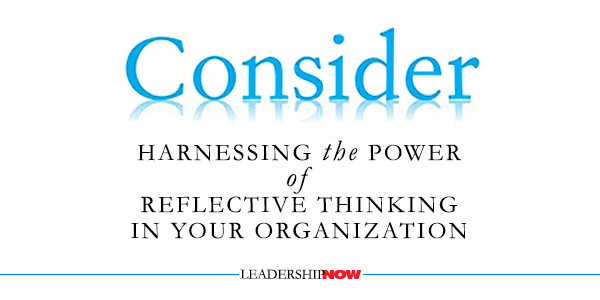
PETER SENGE, founder of the Society of Organizational Learning and senior lecturer at the MIT Sloan School of Management, once observed, “Most managers do not reflect carefully on their actions.” Most managers are too busy “running” to reflect. While reflection seems to have no place in a competitive business environment, it is where meaning is created, behaviors are regulated, values are refined, assumptions are challenged, intuition is accessed, and where we learn about who we are. Some of the greatest barriers to getting the results we want lie within us. Growth happens when we stop repeating our habitual patterns and behaviors and begin to see things in a new way and in the process, discover the power to create the results we want. That makes Consider: Harnessing the Power of Reflective Thinking in Your Organization, one of the most important books you’ll read this year. Author Daniel Patrick Forrester states, “Stepping away from the problem—and structuring time to think and reflect—just may prove the most powerful differentiator that allows your organization to remain relevant and survive…. The best decisions, insights, ideas, and outcomes result when we take sufficient time to think and reflect….Only by carving out think time and reflection can we actually understand, in an entirely different context, the actions we take.”He defines think time as “the purposeful elevation of chunks of our work time, forged within densely packed schedules. It forces the consideration of core significant and pending decisions, outside of cursory overviews and immediate response…. Reflection is the deliberate act of stepping back from daily habits and routines (without looming and immediate deadline pressures), either alone or within small and sequestered groups. It’s where meaning is derived through reconsideration of fundamental assumptions, the efficacy of past decisions and the consequences including the downside of future actions. It’s where space is given for the ‘totally unexpected’ to emerge.” Even if we can agree on the value of think time, we still regard it as a luxury. There’s just no time. But what emerges from Forrester’s research is the fact that we can’t afford not to. It is at the core of what allows a business to thrive. It’s what we don’t know that has a disproportionate impact on us personally and organizationally. We don’t really see the reality we face. Reflection in effect expands our perspectives and thus reveals to us more options and that gets to the heart of what leadership is all about. The point is to make the unseen seen so we can act on it. Forrester interviewed Sarah Sewall who worked with General Petraeus and others to rewrite the military’s counterinsurgency doctrine. Sewall noted, “We are now in a world of increasing specialization, where people get narrower and narrower in their viewpoints in order to become more expert and ‘useful.’ My view is that people become more myopic in how they can think about problems and solutions. We wind up shuttered in our ability to think about possibilities.” This tendency is best counteracted by think time and reflection; being able to back away and incorporate more and varied thinking. Forrester asks, “What is the last document or strategy you can point to as a ‘product of reflection’ built with all parts of the organization and senior-level involvement? If you can’t cite one, it may indicate a culture that values immediacy and the short term over reflection and scalable problem-solving.” Recognizing the need for reflection and actually doing it are two different things. Reflection is a discipline. General Petraeus told Forrester that “he forces bursts of reflection into his day, where he pauses to read, think, and then moves to the next iteration—recognizing that thoughtful insights are not born through real-time analysis.” Forrester suggests that we set time aside for a meeting with oneself. “It isn’t hard to book a meeting with yourself, when you are off-limits to everything but your thoughts.” He notes too, “The power of reflection lies not in how much time we allocate to it. The power of reflection lies in how we choose to use that time and what structure we bring to the fleeting disjointed moments we are afforded.” While some situations required his immediate action, Forrester describes how Lincoln “developed ways to force time to think (if even only for a few minutes) before acting. Even Lincoln had to resist the “instantaneous nature of the telegraph.” Some organizations he has studied have adopted a no internal e-mail Friday policy and other ways to temporarily disconnect from technology. Although these ideas may not work for you, the point is made so that you might consider the impact these technologies are having on the productivity and well-being of your staff. There is always one more e-mail and it will control you if you let it. “When overworked people declare that they ‘just don’t have time to think,’ leaders have a choice: They settle for the status quo and declare that it’s the best way the world works today, or they can insist that reflection is a strategic business enabler,” says Forrester. As an organization, you can either educate for it, make it an expectation—a cultural norm—or treat it as a “do it on your own time” activity and pay the price. Leaders need to understand and demonstrate by example that reflection—taking time to consider—is not wasted time. Reflection is the first step in coming to understand how we are connected to our outcomes. Until we see the relationship between the two, we cannot make deep, lasting change and bring thoughtful behaviors to bear on the situations we find ourselves in. Our thinking creates our reality. If we do not reflect on our thinking we stand to miss our connection to the whole. Consider offers a way to break the pattern of continuous partial attention that seems to be our default position in this technological age. It helps to disrupt the habitual thinking that drowns out the reflective, critical thinking we need to become fully present and effective. Consider isn’t a fad. It is the bedrock of successful leadership and living. Upcoming: I asked some leading minds about the discipline of reflection. So, for the rest of the week, I’ll share their thoughts on this important topic. Look for valuable insights from John Kotter, Mark Sanborn, Brian Orchard, Marshall Goldsmith, John Baldoni, Tom Asacker, James Strock, and Jeremy Hunter.  More in this Series:
Posted by Michael McKinney at 01:57 PM
12.29.10

Leadership: Artistry Unleashed
The executive functions … are feeling, judgment, sense, proportion, balance, [and] appropriateness. It is a matter of art rather than science, and is aesthetic rather than logical.Leadership is an art. But what does that really mean? Leadership can be taught in the way that art can be taught. There are techniques and principles that need to be understood. Seeds that can be planted. But ultimately it has to be practiced and experienced. There is the part that really matters, as Georges Braque observed, that can’t be explained. That is the art; the ever-changing context of leadership and the dance between leaders and followers that molds and shapes both the leader and follower. There is an art to bringing leadership teaching into the nuance of life. Leadership practiced, is artistry unleashed. Hilary Austen does a masterful job of explaining, even if indirectly, the art of leadership in Artistry Unleashed. She takes design thinking beyond the surface concerns of practical design and to the processes behind it. These are important issues for leaders as we face what Austen terms enigmatic problems: those that push us to the edge of what we know. “Our best solutions to such problems lie not just in better analytical tools but in a fundamentally different approach to our work—an approach that follows from cultivating qualitative intelligence in our given profession or medium.” Any more quantitative approaches alone won’t work. She explains the difference: “Quantitative thinking allows us to be precise and to share understanding; we use it to define fairness and rationality and effectiveness. It’s this utility that has led so many people to equate quantitative thinking with intelligence.” “A qualitative approach embraces the unexpected, the subtle, the open-ended, the unique, the poetic; it escapes rules, single answers, or single perspectives. These features are by their very nature hard to pin down and can be quite unnerving to people who want precise information and specific answers. The quantitative approach gives us the means to predict and control what we can measure, to record and codify what can be clearly defined, to collect sharable facts, and to identify universal rules and laws. To be sure, Austen is not advocating one or the other. “Each has its own set of purposes, and developing one does not mean abandoning the other. Achieving artistry means being able to use qualities to help you work when that’s what the situation demands; it doesn’t mean rejecting quantitative methods.” We gravitate to quantitative thinking. We like things nailed down. Numbered. Labeled. Defined. It gives us some certainty. It makes us comfortable. We can check it off and move on confident that we’ve done the “right thing.” Unfortunately, life is messier than that. Austen cites Ted Sorenson’s observation from his book Decision-Making in the White House: “White House decision-making is not a science but an art. It requires not calculation but judgment….Every decision a president makes involves uncertainty.” Qualitative thinking is less about imposing an answer and more about shaping an answer from awareness of the present and feedback from the application of knowledge to it, when predetermined steps and measurable goals are absent. The present and the possible are considered at the same time so that ends and means influence each other as they occur. Austen writes, the “interdependent relationship between ends and means is a hallmark of artistic work. As your effort to solve an enigmatic problem proceeds, the ends evolve as means are generated. Likewise, as means unfold, new ends become possible; these may, in turn, demand new means.” It means managing the tension between mastery and originality in search of the possible. “The forces that drive mastery are conservative. Mastery brings predictability and control to action. By contrast, originality is driven by often unpredictable responses to immediate experience. Finding originality means leaving behind some of what you know. Artistry is driven forward by the interplay of these two competing forces.” New York University professor David Ecker’s six phases of qualitative problem solving developed from the work of John Dewey, described in Artistry Unleashed by Austen is helpful: In the first phase, artists engage what Ecker calls the presented or initial relationship between existing qualities….Some of these relationships may be problematic, others intriguing, and so they attract the artist’s attention. Different practitioners may see different qualities and make sense of what they see differently, depending on the ideals, concepts, and sensibilities they bring to bear on the situation.A leader’s function is to create the disequilibrium needed to go from the known to the unknown possibilities. Qualitative thinking is important to the leader because without it we can easily impose answers rather than exploring possibilities. We can too, get in our own way by overvaluing the importance of our own experience and thought and thereby limit possible outcomes. Austen develops a Knowledge System model comprised of the interdependency of Experiential Knowledge, Conceptual Knowledge, and Directional Knowledge, that can be used to help anyone develop and apply qualitative thinking. The cursory view I present here of the connection between business and art, she more fully develops in her book. The examples she gives dramatically demonstrate this important connection and essential understanding needed by leaders of every type. Related Interest:  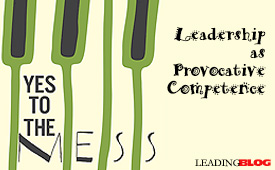 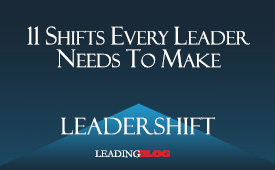
Posted by Michael McKinney at 01:21 AM
10.19.10

quickpoint: The Trap of “Outside-In” Thinking To achieve an execution revolution, business leaders need to quit thinking only about solving the current problem, but, instead, think about how to build an organization that’s good at solving problems in general—building the capability that’s certain to help overcome an uncertain future. To achieve an execution revolution, business leaders need to quit thinking only about solving the current problem, but, instead, think about how to build an organization that’s good at solving problems in general—building the capability that’s certain to help overcome an uncertain future.
Today, television, books, magazines, newspapers, and the Internet keep us flooded with information about what’s going on in the world. We become preoccupied with what everyone else is doing, instead of focusing on what’s going on inside our organizations. Focusing outward makes us good at being reactive, rather than developing the ability to execute well. This is true both individually and organizationally. The Execution Revolution is in fact an internal revolution. A revolution focused on changing the way your organization functions on the inside. In other words, controlling the things we can, to be better prepared for the things we can’t. (Adapted from: Six Disciplines Execution Revolution: Solving the One Business Problem That Makes Solving All Other Problems Easier by Gary Harpst)
Posted by Michael McKinney at 12:08 AM
10.13.10

Every Leader’s Six Mental Mistakes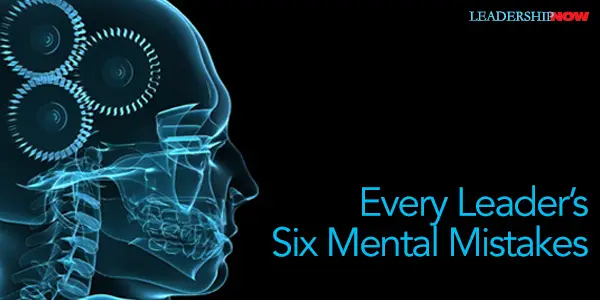 MANAGING OURSELVES is our biggest task as a leader. How well we manage ourselves determines the kind of leader we will be and the impact we will have.
MANAGING OURSELVES is our biggest task as a leader. How well we manage ourselves determines the kind of leader we will be and the impact we will have.
Adapting Jonathan Haidt’s metaphor of the rider and the elephant, Richard Daft presents the executive (the voice of reason) and the elephant (impulsive and emotional) metaphor to help us to learn how to help our inner executive manage our inner elephant as needed to behave according to our best intentions—to better manage oneself. One of the biggest problems we face as a result of our inner elephant’s tendency to distort reality. It’s one of the reasons we are so surprised when someone disagrees with us. Our internal elephant judges (our self and others), creates illusions (self-justification) and acts as our attorney (defends us and making us immune to reality). In The Executive and the Elephant, Daft points out that our inner judge “sees things from a selfish point of view and has little empathy and consideration toward others. It is hard to be optimistic and motivate people when your mind is critical of them.” The judge will also become our own worst critic—“the automatic voice of blame and criticism inside your head that points out how inadequate you are.” Daft poignantly asks: “Can you be an effective leader when your mind is constantly finding fault with you?” Daft illuminates some perceptual habits of the inner elephant that can get in the way of seeing the world accurately. Without a conscious effort to do otherwise, it is easy to fall prey to any or all of these six mental mistakes: Reacting Too Quickly. As quickly as things are thrown at us, it’s a lot easier being reactive than being proactive. It’s easy to instantly judge, conclude and react based on small scraps of data rather than slowing down and remaining calm says Daft. Serious intention is required to slow things down. How we see things always appears so clear to us and it seems we can’t act on it soon enough. It’s what the elephant does. We have to engage our inner executive to avoid acting on wrong-headed conclusions. Inflexible Thinking. The inner elephant doesn’t like to change its mind. After all, we believe what we think for obvious (to us) reasons. We don’t intentionally think the wrong thing. And we interpret the world around us according to our beliefs. “It is very hard to let go of your own gut feelings and mental preferences” says Daft. “It’s all you know. The mind-set, habits, and skills that made you successful tell you to stick to your guns. However, things change, and if the mind does not accept the current reality, it can create problems for everyone.” Wanting Control. Your inner elephant is more comfortable when you’re in control. Of course, we only take control because if we didn’t things wouldn’t get done the way we think they should be done. But our satisfaction is at their expense. The desire for control can lead us to illusions—attempts to gain control (and think we have it) over the uncontrollable. A leader’s inner executive needs to learn to give control to others. Our job is to “engage a bigger picture of mission and purpose (inner executive) and let people be in control of their own work.” Emotional Avoidance and Attraction. Even when we know we need to do something, our inner elephant can find reasons to avoid it. We procrastinate. We delay an intended course of action despite expecting to be worse off for the delay. Our inner elephant feels anxiety and creates an invisible barrier in our mind that prevents us from moving forward. Attraction can cause us problems by enslaving us to our desires. Desire for acceptance can cause to make decisions we wouldn’t otherwise make under the influence of our inner executive. About the desire for perfection, Daft writes: A few of my MBA students are perfectionists who can’t restrain their desire to redo a group project to make it look the way they want, even after I explain that this behavior is fatal for leaders who have to accomplish work through others. Managers may also feel the need to act on their unthinking desire to be right rather than let other people shine, to perpetually find fault with other people’s ideas, to win every disagreement, to blame others when something goes wrong despite being culpable, or to speak harshly when upset. Exaggerating the Future. Related to the emotional avoidance and attraction issues is our tendency to exaggerate outcomes. When our inner elephant wants to do something we tend to be overly optimistic about the future and underestimate the potential difficulties. When we don’t, we tend to overstate the potential problems. The problems are obvious. Objectivity is needed if we are to anticipate the future realistically. “The inner elephant tends toward positive or negative exaggerations about the future depending on its emotional orientation toward an object or event." Chasing the Wrong Gratification. The inner elephant is child-like and selfish. “Finding happiness is a challenge because the inner elephant often seeks things that do not provide lasting satisfaction.” We can be easily seduced into chasing after the wrongs things—things that don’t bring us lasting satisfaction. Daft offers sensible techniques to get some mastery over your inner elephant. He writes, “Let’s face it: Your inner elephant has been running your life. For better or worse, everyone is on automatic pilot more than they realize.” Your best defense is to get to know your inner elephant. Slow down and reflect. While there are negatives, there are strengths that can be harnessed. 
Posted by Michael McKinney at 11:33 PM
09.22.10

quickpoint: The Perils of the Comfort Zone Author and pastor C. Neil Strait (1934-2003) once wrote, “The convenient way is not always the best way. It may lead through an avenue of comfort that robs us of integrity. Or it may take us through the tunnel of compromise, where our courage is weakened. And, after all, convenience is such a fleeting thing, but integrity and courage are vital ingredients for living.” Author and pastor C. Neil Strait (1934-2003) once wrote, “The convenient way is not always the best way. It may lead through an avenue of comfort that robs us of integrity. Or it may take us through the tunnel of compromise, where our courage is weakened. And, after all, convenience is such a fleeting thing, but integrity and courage are vital ingredients for living.”
Strait is right. Our comfort zone can compromise us. And if we are not careful, our comfort zone becomes our answer for everything because it becomes the mindset we operate from. Eventually it kills our curiosity, our creativity and our opportunities. What are you doing for the sake of convenience—because it's easier—that is holding you in unhealthy patterns of behavior and limiting your thinking?
Posted by Michael McKinney at 09:12 AM
09.17.10

The Reality-Based Leader’s Manifesto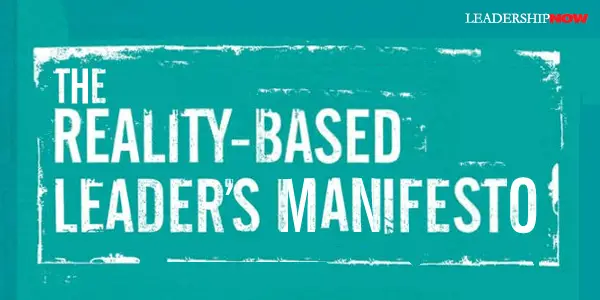 “If you believe that leadership is tougher today than it was in the past, you’re not alone,” writes Cy Wakeman, author of Reality-Based Leadership. “We are living and working in dramatic and demanding times, but that is not our biggest problem. The source of our pain is the absence of great leadership that is based in reality. …The future belongs to the leader who is able to change the way people think and perceive their circumstances, the leader who engages hearts and minds.” To that end, she offers the Reality-Based Leader’s Manifesto:
“If you believe that leadership is tougher today than it was in the past, you’re not alone,” writes Cy Wakeman, author of Reality-Based Leadership. “We are living and working in dramatic and demanding times, but that is not our biggest problem. The source of our pain is the absence of great leadership that is based in reality. …The future belongs to the leader who is able to change the way people think and perceive their circumstances, the leader who engages hearts and minds.” To that end, she offers the Reality-Based Leader’s Manifesto:

Posted by Michael McKinney at 07:07 PM
09.06.10

Getting Ideas to Flow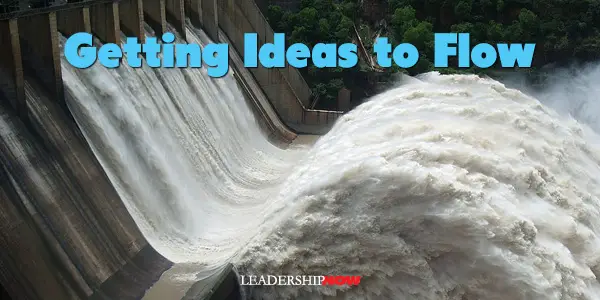
Charles Landry is the founder of Comedia, and works to help cities to be more "creative for the world" so that the energies of individuals and companies can be brought into alignment with their global responsibilities. He recently told Sally Helgesen that his experience has taught him that “the single biggest problem in the world is not finding great ideas but getting great ideas to move, to flow.” Getting stuck is an issue we face both individually and organizationally. At its core, it’s a thinking problem and is often self-inflicted. Creating the right kind of movement and in the right direction begins with re-thinking our view of reality. If we keep applying the same patterns of thinking even after they have been shown to be counterproductive we skew our perception of even everyday life situations and block the flow of growth, ideas, and influence. Here are some common areas we need to rethink to get ideas to flow: Re-think complexity. We create complexity by over-analyzing our situation; creating issues where there are none; forgetting our purpose. Complexity obscures the issues. Keep the issues as uncluttered as possible. Often an outsider can see the situation and the real issues more clearly than you can. Try asking, “Am I making this a bigger problem than it is because of fear, insecurity or lack of knowledge?” “Is this really a problem to be solved or a tension to be managed?” Stick to what needs to be addressed. Complexity can lead to procrastination. Re-think systems. Trying to create a new vision without addressing old systems is at best counterproductive. Tenaciously grasping the old ways of doing things just because that is what you have always done, can stop the flow of ideas and innovative solutions and lead to hopelessness. If you are experiencing a chronic lack of movement, a resistance to change or lack of compliance to your “really good idea,” you probably have a system in place that discourages the very behavior you seek. A system should reward the behavior you want. What systems are getting in your way? Re-think ego. Our ego frequently keeps us from exploring new ideas. We get so invested in what we have done that we can’t get out of our own way. We keep retrying to work the old and deceive ourselves into thinking we’re making progress when all we are doing is rearranging the deck chairs on a sinking ship. Sometimes we need to set aside our ego and simply abandon what isn’t working and start over with a better design. Re-think boundaries. Think bigger. Think interdisciplinary. Growth often involves blurring boundaries to open your mind to new possibilities. What principles outside of your world of experience could expand the possibilities for your idea? Re-think reactions. Repetitive reactions are the result of ingrained patterns of thinking that we have hard-wired into our brains long ago. Take the time to reflect on why you think the way you do; why you do what you do. Default patterns of thinking lead to more of the same. Ask yourself, “Is this working for me?” Think about the unspoken. Re-think failure. If you’re afraid of being wrong, embarrassed by failure or paralyzed by insecurity, you will never find the solutions that lead to meaningful growth. Failure provides the nutrients for growth when we respond to them positively. Keep failure in perspective, it’s a regular part of life. You can’t avoid them so learn to work with them. Failures help you to raise the bar and reorient your thinking to possibilities and new ways of thinking. Re-think success. Know what success looks like. How will you know when you have arrived? Muddy expectations lead to exhaustion and defeat before you even get started. Praise short-term accomplishments to appeal to your heart and not just your head. It will keep your ideas moving along. 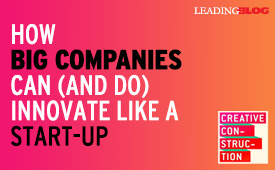 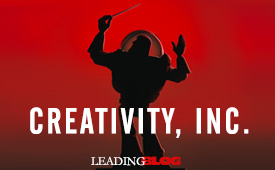
Posted by Michael McKinney at 03:16 PM
08.25.10

Dispute Catastrophic Thoughts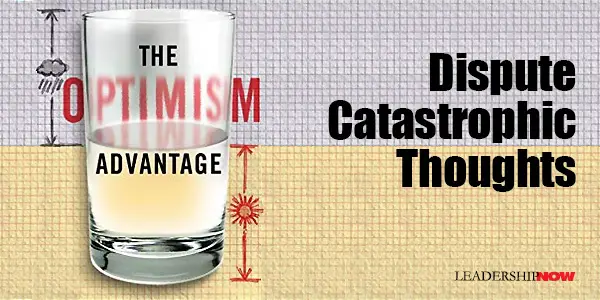
WARREN BENNIS wrote in Leader to Leader that “every exemplary leader that I have met has what seems to be an unwarranted degree of optimism—and that helps generate the energy and commitment necessary to achieve results.” Optimism says Bennis, “the sense that things generally work out well, creates tremendous confidence in oneself and in those around one.” Optimism helps leaders to be more resilient as they tend to believe in their capacity for self-control and the ability to overcome obstacles that come their way. In short, I would say, optimism is finding perspective. In The Optimism Advantage, Terry Paulson offers fifty truths for cultivating optimism beginning with “Life is Difficult.” (Perhaps not what you would expect from a book on optimism.) He writes, “If you want to be a true optimist, start by being a realist. Accept that life is difficult, and then get busy learning as much as you can about the challenges you face. Why? Because you’ve overcome problems in the past, you have every reason to believe that you’ve got what it takes to overcome whatever problems life deals you.”One important place to begin is with our negative thoughts and feelings. Optimists dispute catastrophic thoughts, those “feelings that everything is wrong and that nothing is going to change.” Paulson says that “means you have to be ready to argue with some of your negative beliefs.” Optimism is “about facing and taking advantage of reality—even unsettling reality. Expecting unrealistic results may actually increase your dissatisfaction….To an optimist, it’s all about resilience and maximizing your results.” Start with understanding what it is you’re saying to yourself that is causing a bigger problem in your thinking. Clarify it and then take a critical look at your beliefs and dispute them. Are they valid? Is there another way to look at this? Seek alternate explanations. Optimists ask, “Is there any less destructive way to look at this or explain what happened?” Look for causes that you can overcome and focus on what can be changed and then take action. 
Posted by Michael McKinney at 12:36 AM
07.27.10

7 Signs You Might Be In Denial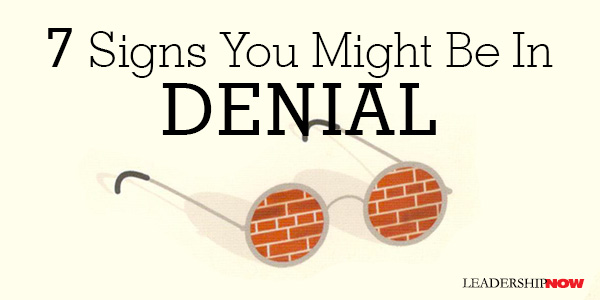
Nothing is easier than self-deception. For what each man wishes, that he also believes to be true.BUSINESS historian Richard S. Tedlow, shares in Denial examples of CEOs who have made mistakes that could and should have been avoided and those that did it right and why. The lessons Tedlow uncovers in these examples provide us with insight into our own flirtation with denial and how we might battle it. You might be in denial if you think you have all of the information you need. “Power deranges. Powerful people are routinely surrounded by yes-men, but that is not the real problem because they are relatively easy to spot. The real problem is the courtier who is sufficiently clever not to be detected.” Powerful people, Tedlow continues, “don’t really know as much as they may think about their own organization because people stop telling them the truth.” You might be in denial if you don’t make a point to listen. If people think they won’t be heard they will not speak up. You need to create an open environment where it is safe to say what’s on your mind. Tedlow offers a quick test of your environment: “are the private conversations that follow meetings usually more frank and honest then the public discussions in the meetings themselves?” If so, it’s because everybody is talking about what didn’t (couldn’t) get said. You might be in denial if you think short-term. You are sticking your head in the sand. Trying to put a Band-Aid on a much larger problem only delays your response to the inevitable. Deal with it now and completely. “Denial is all about you—and how you view the world. Your view does not change the world, the realities of which you will inevitably have to face sooner or later.” You might be in denial if you talk trash about competitors and individuals. Anna Freud called it “defense by means of ridicule and scorn.” Tedlow writes, “If you find yourself trash-talking your competition take a moment to think about what you’re doing. What am I using this derision to hide—perhaps from myself?” You might be in denial if you relabel actions rather than changing them. When you don’t like reality, you just change its name. The result as George Orwell said is to “perform the important service of partially concealing your meaning even from yourself.” “Troubled assets aren’t ‘troubled assets.’ They are worthless pieces of junk.” You might be in denial if you don’t tell the truth. “Denial occurs when we push aside hard truths in favor of more palatable or convenient narratives.” This works two ways: the lies we tell and the lies others tell us. Don’t participate in either. You might be in denial if you don’t think denial is a problem you face. That of itself is denial. Tedlow cautions, “It can never be completely defeated because we can’t fully know or face the truth about ourselves. It is impossible to be both subject and object.” You need to develop a self-awareness about it. “Denial-avoidance is a life’s work, not an agenda item….If one could simply resolve to wake up tomorrow and unflinchingly confront reality, denial would hardly be the problem that it is….You can’t avoid blind spots when you drive. However, good drivers know those blind spots exist and take them into account when they get behind the wheel. So it should be with denial.” Some people deny less than others. How can you be one of them? 
Posted by Michael McKinney at 11:16 PM
07.07.10

How Many Surface Areas Do You Have?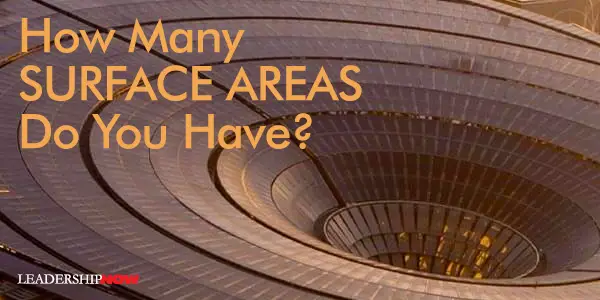 HOW MANY points of contact do you have with the world around you? If we limit ourselves to one area or experience, then we limit our exposure and growth. If we depend too much on one facet of our lives, we isolate ourselves from the world around us and we end up missing what is really going on.
HOW MANY points of contact do you have with the world around you? If we limit ourselves to one area or experience, then we limit our exposure and growth. If we depend too much on one facet of our lives, we isolate ourselves from the world around us and we end up missing what is really going on.
In The Power of Pull the authors share their conversation with entrepreneur Jack Hidary. He explains that people overlook obvious situations because they “paint themselves into a corner such that their entire interaction with the outside world is mediated through this one facet. Then they’re unable to critically analyze where they are. That’s how they end up going down with the ship.” This is important because as authors John Hagel III, John Seely Brown, and Lang Davison point out, “If we are going to succeed in this rapidly changing world, we face two challenges: making sense of the changes around us, and making progress in an increasingly unfamiliar world.” To do this we need to approach what we do in a way that allows us to be in the flow of knowledge and open to serendipitous events that inform us of things we didn’t know and didn’t even know we were looking for. That approach they call pull: the ability to draw out people and resources to address opportunities and challenges. It’s different than push. Push predetermines our needs and then creates systems and standardized processes designed to provide what we need when we need it. It says, “I know better than you. Do this, not that.” It says, “I know. Here’s what you do.” On the other hand, pull says, “I don’t know. I’ll seek.” The pull approach works to help us to find and access people and resources when we need them, the ability to attract people and resources that are relevant and valuable and then to pull from ourselves the insight and performance required to achieve our potential. The attract aspect of pull is critical. In a world that is changing so quickly, we often don’t even know what we are looking for or the questions to ask to get there. It calls for a different approach. It increasingly depends upon serendipity. You need to increase your surface areas. You need to look for ways to pull people and their knowledge toward you. “If you want to find out what it is you don’t know that you don’t know, you need to hang out with other people who might already know it.” We need serendipitous encounters with people because of the importance of the ideas that these people carry with them and the connections they have. People carry tacit knowledge. … You’ve got to stand next to someone who already knows and learn by doing. Tacit knowledge exists only in people’s heads. As edges arise ever more quickly, all of us must not only find the people who carry the new knowledge but get to know them well enough (and provide them with sufficient reciprocal value) that they’re comfortable trying to share it with us. The authors claim that serendipity in certain respects can be shaped. Of course luck is involved, but we can materially affect it by our actions. We need amplifiers and filters. Amplifiers “that can help us reach and connect to large groups of people around the globe that we do not know.” Filters “that can help us to increase the quality as well as the number of unexpected encounters and ensuing relationships that are truly the most relevant and valuable.” We can manage serendipity by:
The authors ask: What are the five places in the world that would offer the richest opportunities for serendipitous encounters with people who share your passions and interests? What actions could you take to increase the likelihood and quality of serendipitous encounters in the online social networks you participate in? Of the people you met serendipitously in any venue over the past year, how many of these people have you actually engaged in some joint initiative related to your passions and interests? 
Posted by Michael McKinney at 08:58 AM
06.29.10

Multipliers: How the Best Leaders Make Everyone Smarter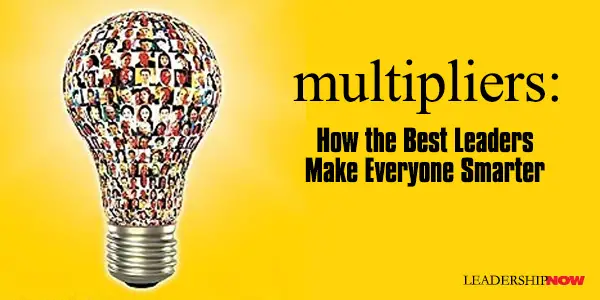
MUCH OF WHAT constitutes good leadership can be summarized in two words: respect and selflessness. How we relate to those two words will determine how we lead. Consider two assumptions that lie at the opposite ends of the spectrum: • Really intelligent people are a rare breed and I am one of the few really smart people. People will never be able to figure things out without me. I need to have all the answers. • Smart people are everywhere and will figure things out and get even smarter in the process. My job is to ask the right questions. What you believe has a big impact on the performance, engagement, loyalty and the transparency you find with those you lead and interact with. In Multipliers: How the Best Leaders Make Everyone Smarter, authors Liz Wiseman and Greg McKeown refer to those with the mindset represented by the first assumption as Diminshers and those with the mindset represented by the second assumption as Multipliers. It explains why some leaders create intelligence around them, while others diminish it. The value of Multipliers is that is shows what these assumptions about people look like in practice and how they are reflected in your behavior. How would you approach your job differently if you believed that people are smart and can figure it out? With a Multiplier mindset, people will surprise you. They will give more. You will learn more. What kind of solutions could we generate if you could access the underutilized brainpower in the world? How much more could you accomplish? It’s not that Diminishers don’t get things done. They do. It’s just that the people around them feel drained, overworked and underutilized. Some leaders seem to drain the “intelligence and capability out of the people around them. Their focus on their own intelligence and their resolve to be the smartest person in the room [has] a diminishing effect on everyone else. For them to look smart, other people had to end up looking dumb.” In short, Diminishers are absorbed in their own intelligence, stifle others, and deplete the organization of crucial intelligence and capability. Multipliers get more done by leveraging (using more) of the intelligence and capabilities of the people around them. They respect others. “Multipliers are leaders who look beyond their own genius and focus their energy on extracting and extending the genius of others.” These are not “feel good” leaders. “They are tough and exacting managers who see a lot of capacity in others and want to utilize that potential to the fullest.” The authors have identified five key behaviors or disciplines that distinguish Multipliers from Diminishers. You are not either/or but are somewhere along a continuum. These are all learned behaviors and have everything to do with how you view people. We don’t have to be great in all disciplines to be a Multiplier, but we have to be at least neutral in those disciplines we struggle with.
They have developed an assessment tool you can use to see where you are. Importantly, the first place to begin is with your assumptions about people. If you don’t have that straight the rest is just manipulation. As with most behaviors, we do them because we feel we have to. They are self-perpetuating. We jump in where we shouldn’t and come to the rescue. Under our “help” (domination) people hold back thereby reaffirming our belief that they just couldn’t do it without us. And they can’t or rather won’t. Instead they quit while still working for us or move on. We see this in ourselves, in others and in organizations of all types. Leaders are especially prone to run over people, because after all, they have the vision, the know-how and the desire to get it done. We have to slow down and remember that we are not there just to get the job done, but to develop others to get the job done. They can (and need to be able to) do it without us. It’s our job to show them how. In many ways, as leaders, we can become accidental Diminishers. The skills that got us into a position of leadership, are not the same skills we need to lead. Leadership requires a shift in our thinking. Wiseman and McKeown write, “Most of the Diminishers had grown up praised for their personal intelligence and had moved up the management ranks on account of personal—and often intellectual—merit. When they become ‘the boss,’ they assumed it was their job to be the smartest and to manage a set of ‘subordinates.’" Here are some thoughts—out of context—from the book that will get you thinking: “Marguerite is so capable she could do virtually any aspect of girl’s camp herself.” But what is interesting about Marguerite isn’t that she could—it is that she doesn’t. Instead, she leads like a Multiplier, invoking brilliance and dedication in the other fifty-nine leaders who make this camp a reality. One leader had a sign on her door: “Ignore me as needed to get your job done.” She told new staff members, “Yes, there will be a few times when I get agitated because I would have done it differently, but I’ll get over it. I’d rather you trust your judgment, keep moving, and get the job done.” The path of least resistance for most smart, driven leaders is to become a Tyrant. Even Michael said, “it’s not like it isn’t tempting to be tyrannical when you can.” Policies—established to create order—often unintentionally keep people from thinking. At best, these policies limit intellectual range of motion as they straitjacket the thinking of the followers. At worst these systems shut down thinking entirely. “It is just easier to hold back and let Kate do the thinking.” [They resign: “Whatever!”] It is a small victory to create space for others to contribute. But it is a huge victory to maintain that space and resist the temptation to jump back in and consume it yourself. An unsafe environment yields only the safest ideas. [Multipliers] ask questions so immense that people can’t answer them based on their current knowledge or where they currently stand. To answer these questions, the organization must learn. His greatest value was not his intelligence, but how he invested his intelligence in others. 
Posted by Michael McKinney at 04:28 PM
06.09.10

Why Design Thinking Is the Next Competitive Advantage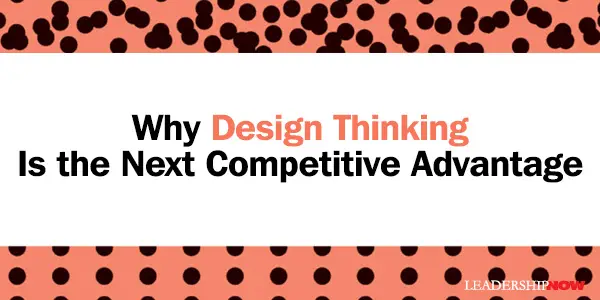
WE live in a reliability-oriented world. And understandably so. We want predictable outcomes. We want things to keep working as they have always been—perfectly. Success. Repeat. Success. Repeat. But that thinking ultimately limits our growth and quite possibly harbors the seeds of our own destruction. It can be (very) valuable to a point, but it isn’t adaptable because by its very nature it has to leave something out of the equation. While reliable outcomes “reduce the risk of small variations in your business, they increase the risk of cataclysmic events that occur when the future no longer resembles the past” and the reliable is no longer relevant or useful. To remain relevant—to foster innovation—you need to incorporate into your thinking outcomes that are valid. That is outcomes that produce a desired result even if the solution employed can’t produce a consistent, predictable outcome. A perfectly valid solution is one that produces a result that is shown, through the passage of time, to have been correct. It is best to have a system that incorporates both—validity and reliability—into their approach. Balancing and managing the two approaches—analytical and intuitive—is what design thinking is all about. In The Design of Business, Roger Martin presents the knowledge funnel to show how knowledge moves. Each stage represents a simplification and ordering of knowledge. At the beginning is a mystery; a question. It is the observation of phenomena. Things we see but don’t yet understand.
The next stage is a heuristic, “a rule of thumb that helps to narrow the field of inquiry and work the mystery down to a manageable size.” Heuristics don’t guarantee success but do increase the probability of success. The last stage is the development of an algorithm. “An algorithm is an explicit, step-by-step procedure for solving a problem. Algorithms take the loose, unregimented heuristics—which take considerable thought and nuance to employ—and simplify, structuralize, and codify them to the degree that anyone with access to the algorithm can deploy it with more or less equal efficiency.” Martin uses the example of the development of McDonalds to illustrate how they proceeded down the knowledge funnel. In 1940 the McDonald brothers opened their first drive-in restaurant in San Bernardino, California. It did well, but by 1950 they began to lose business. Food was getting cold before it was delivered and families were put off by the hoards of teenagers they attracted. They had to develop a winning heuristic. They reduced and standardized the menu, and implemented their Speedee Service System. Ray Kroc saw an opportunity in it and bought them out. While the Speedee Service System was good, Kroc thought it left too much to chance. So he refined it and simplified it down to an exact science. The new system left nothing to chance and it was repeatable. “Kroc relentlessly stripped away uncertainty, ambiguity, and judgment from the processes that emerged from the McDonald brothers’ original insight. And by fine-tuning the formula, he powered McDonald’s from a modestly prosperous chain of burger restaurants to a scale previously undreamed-of.” The problem is getting stuck in any one stage. We tend to operate within a knowledge stage as opposed to moving across the knowledge stages. We need to explore and question, we need to exploit our solutions, even reducing them to a repeatable, efficient, formula where possible, but we need to be doing these things simultaneously. The vast majority of businesses follow a common path. The company is birthed through a creative act that converts a mystery to a heuristic through intuitive thinking. It then hones and refines that heuristic through increasingly pervasive analytical thinking and enters a long phase in which the administration of business dominates. And in due course, a competitor stares at the mystery that provided the spark for this company, comes up with a more powerful heuristic, and supplants the original business. McDonalds did well for decades, but eventually the heuristic (Americans want a quick, convenient, tasty meal) changed (Americans want a healthier menu). The solution for McDonalds is to go back and rethink the mystery and develop new rules of thumb to guide them. A trip back through the knowledge funnel. Avoiding this cycle is the job of the leader—a leader at any level. Martin writes, “CEOs must learn to think of themselves as the organization’s balancing force—the promoter of both exploitation and exploration; of both administration and invention.” This is design thinking. We need to develop our design thinking skills, analyze what’s working and why, and at the same time revisit the original mystery while considering entirely new mysteries. “The design thinker develops the capacity for observation, for seeing features that others may miss. The design thinker, in the words of novelist Saul Bellow, is ‘a first-class noticer.’” Always cycling through the knowledge funnel.
Posted by Michael McKinney at 12:28 PM
03.09.10

Get to the Why by Starting at the EpicenterWhen beginning or introducing anything—an idea, a project, or a new venture—you need to start with asking yourself why. In Rework, authors Jason Fried and David Heinemeier Hansson write candidly about where to begin:When you start anything new, there are forces pulling you in a variety of directions. There’s stuff you could do, the stuff you want to do, and the stuff you have to do. The stuff you have to do is where you should begin. Start at the epicenter.They suggest you begin by asking, “If I took this away, would what I’m selling still exist?” It’s easy to get bogged down in the details and get off on tangents. And while details are important, they can distract you, pulling you in the wrong direction or even derail your idea. They caution: “Getting infatuated with details too early leads to disagreement, meetings, and delays. You get lost in things that don’t really matter. You waste time on decisions that are going to change anyway. So ignore the details—for a while. Nail the basics first and worry about the specifics later.”
Posted by Michael McKinney at 11:31 PM
01.22.10

Can You Pass the Fitzgerald Test?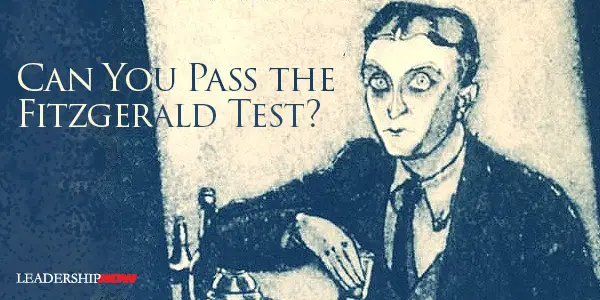
IN HIS CLASSIC self-analysis, The Crack-Up, F. Scott Fitzgerald wrote, “The test of a first-rate intelligence is the ability to hold two opposed ideas in the mind at the same time, and still retain the ability to function.” For example, he added, one should “be able to see that things are hopeless and yet be determined to make them otherwise.” More and more we are called upon to function in a world full of paradoxes; not only function but possess an ability to take action in the face of conflicting ideas and norms. Bruce Piasecki writes in The Surprising Solution, that paradox “almost seems too mild a word to describe the challenges facing the social leaders of today.” He adds, the best leaders “thrive on differences and ambiguity, and find solutions amid this large tolerance for social complexity.” In his innovation playbook for uncertain times, The Silver Lining, Scott Anthony writes, “Existing systems, structures, and development programs that were sufficient for leaders to thrive in an era of ordered capitalism are proving to be inadequate in today’s increasingly turbulent times. Most leaders just aren't ready to grapple with the paradoxes that will increasingly characterize their day-to-day lives.” He lists, for example, these seemingly paradoxical requirements facing leaders:
Anthony reports that it has been estimated that no more than 5 percent of the manager population can truly grapple with paradox. Why? He says that “Michael Putz from Cisco has studied this problem for the past decade. His perspective is that the problem isn’t a lack of basic intelligence, desire, or capacity. Rather, managers haven’t developed the ability to grapple with paradox because they haven’t needed to.” But the capacity to deal with paradox, to work with opposable ideas, is learnable. Again, self-awareness is key. Understand how you view the world. Then, creating a specific developmental program to help you take a broader view, to integrate multiple perspectives, to view solutions as both/and instead of either/or, will help you pass the Fitzgerald Test. 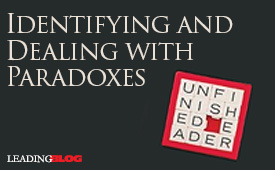 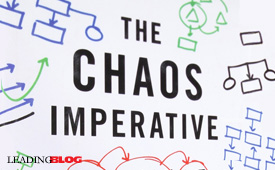
Posted by Michael McKinney at 12:12 AM
12.23.09

The Nature of Small Wins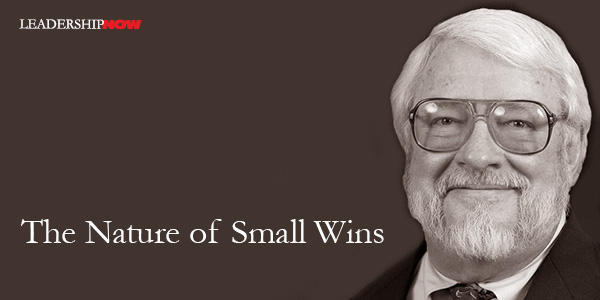
IN the face of overwhelming problems, we can feel helpless to do anything. Organizational theorist Karl Weick argues that calling a situation a serious problem requiring a sweeping change may be when the real problem starts. (e.g., "I can't solve that problem, so I'll just focus on something else.") And so nothing gets done. In the article Small Wins: Redefining the Scale of Social Problems, Weick explains that small wins help to create an environment where change is not overwhelming and therefore more likely to happen. He writes, "The massive scale on which social problems are conceived often precludes innovative action because the limits of bounded rationality are exceeded...People often define social problems in ways that overwhelm their ability to do anything about them." In order to solve social problems, he suggests that we define them as a series of smaller problems that can then be affected by small wins. He defines small wins as a "series of concrete, complete outcomes of moderate importance [that] build a pattern that attracts allies and deters opponents." This strategy of focusing on “a series of controllable opportunities of modest size that produce visible results”, works directly on the construction of a problem and indirectly on its resolution. A small win is a concrete, complete, implemented outcome of moderate importance. By itself, one small win may seem unimportant. A series of wins at small but significant tasks, however, reveals a pattern that may attract allies, deter opponents, and lower resistance to subsequent proposals. While small wins provide less effort to produce and provide stable building blocks to build on, they are not orderly because each small win changes the context for the next small win. Weick explains: “Small wins have a fragmentary character driven by opportunism and dynamically changing situations. Small wins stir up settings, which means that each subsequent attempt at another win occurs in a different context. Careful plotting of a series of wins to achieve a major change is impossible because conditions do not remain constant. Much of the artfulness in working with small wins lies in identifying, gathering, and labeling several small changes that are present but unnoticed, changes that in actuality, could be gathered under a variety of labels.
Posted by Michael McKinney at 07:57 AM
11.15.09

Confirmation Bias In the Wall Street Journal, Jason Zweig writes about the specific application of a general issue: confirmation bias. It is a never-ending battle that affects all of us and is worth reading for the reminder. He offers specific ideas to counteract its pull that can be applied to whatever you are doing. Here are a few edited excerpts from Ignoring the Yes-Man in Your Head to introduce the issue: In short, your own mind acts like a compulsive yes-man who echoes whatever you want to believe. Psychologists call this mental gremlin the "confirmation bias." A recent analysis of psychological studies with nearly 8,000 participants concluded that people are twice as likely to seek information that confirms what they already believe as they are to consider evidence that would challenge those beliefs.
Posted by Michael McKinney at 11:57 AM
08.07.09

Learning to Apply Right View and Right Conduct to Your Decision Making
THE Dalai Lama and consultant Laurens Van Den Muyzenberg have collaborated in The Leader’s Way to fuse Buddhist and Western philosophies to address responsible leadership. In order for a leader—“one who makes the right decisions”—to make the kinds of decisions that “generate a better quality of life for themselves, their organizations, and everyone else affected by those decisions,” they must learn to “understand more clearly what happens in their minds and the minds of others.” This involves two concepts they introduce as Right View and Right Conduct. The Right View has to do with action based on the right intention and the right motivation. It means taking into account that nothing that exists is permanent, nothing exists without a cause, and every cause has many effects. The Right Conduct is the endgame; to take action that serves the needs of individuals and organizations. The right conduct should always align with your stated values and principles. When the mind is disturbed by anger, jealousy, hate, impatience, fear, lack of self-confidence, or negative emotions about things that happened in the past, it is wasting valuable time that instead should be used for constructive thinking. The purpose of training the mind is to maximize its power by focusing it on the decisions that matter. Meditation or reflective thinking plays a big part in training the mind. A Harvard study cited in the book compared brain scans of meditating and nonmeditating people and found that meditation had seemingly enlarged the part of the brain that regulates emotion, attention, and working memory. They discuss ways of developing your thinking to improve your performance, the performance of your organization, and for acting responsibly in our interdependent world. One important pattern emerged: “one should celebrate joyful events while not becoming too attached to their meaning, either in the present or as a predictor of the future.” The danger is in seeing success as permanent. Right View and Right Conduct is a process that always needs to be renewed.

Posted by Michael McKinney at 12:54 AM
06.17.09

Iconoclast: Learning to Think DifferentlyCREATIVITY and imagination is in the space between revolutions and everyday life. They fuel change and, most of the time, progress. Bringing new thinking to old patterns is the job of the leader. In a sense, leaders are to varying degrees, called to be iconoclasts. Neuroscientist Gregory Berns says that not only is an iconoclast a person who does something that others say can’t be done but their mind functions differently than the average mind. Those functions are perception, fear response and social intelligence. Because the mind is designed to function as efficiently as possible, it serves as its own barrier to being an iconoclast. (The brain runs on about 40 watts of power. There is partial truth to the myth that you only use 10-15% of your brain. We use all of our brain, but only a fraction of the brain is active at any given time to conserve energy.) In Iconoclast, Berns explains that “when confronted with information streaming from the eyes, the brain will interpret this information in the quickest and most efficient way possible.” This “efficiency trap” blocks us from seeing alternatives to what we perceive as real; it imposes limitations to what we believe is the only way of seeing something. Iconoclasts don’t allow themselves to fall into the efficiency trap as often as the average person does. “Automatic thinking destroys the creative process.” Berns adds—and the implication is very important—“iconoclasts, either because they were born that way or because they learned how to do it, have found ways to work around the perceptual shortcuts that plague most people.” Thus, we can learn to do this too. Fundamentally, we need to create novel experiences. Iconoclasm begins with perception….Sometimes a simple change of environment is enough to jog the perceptual system out of familiar categories….Unfamiliarity forces the brain to discard its usual categories of perception and create new ones….When confronted with places never seen before, the brain must create new categories. It is in this process that the brain jumbles around old ideas with new images to create new syntheses. The iconoclast’s fear response—specifically the fear of uncertainty and the fear of public ridicule—are different than that of the average person. Fear is damaging to creativity in the workplace. “In many people, the brain would rather avoid activating the fear system and just change perception to conform with the social norm.” You can not eradicate the fear response but you can learn to tame it. “Neuroscience is showing how the rational part of the brain can regain control over such toxic emotions like fear.” The individual who feels overwhelmed by uncertainty or social stresses in the workplace may benefit from taking on projects that have defined endings. Although these may increase in the short term, their completion may actually decrease overall stress. All of this is well and good, but to be a successful iconoclast, you must be able to sell your ideas to other people. That boils down to social intelligence. “As well-respected, upstanding citizens, connectors form the glue of local society. Iconoclasts, by their very nature, upset this delicate web of connectedness. But iconoclasts need connectors. Without them, the iconoclast stands no chance of achieving success. Sometimes iconoclasts have to create the connectors themselves.” Additionally, it is a challenge to leaders to be able to find ways to connect iconoclasts to others so that their talents and insights can be capitalized on organizationally. It is extremely rare for one person to have all three qualities of a successful iconoclast. But you can compensate by building a team around you in areas where you aren’t strong. Iconoclast: A Neuroscientist Reveals How to Think Differently is supported by research and persuasive stories. The immediacy of the topic will be helpful not only to individual development but to organizations seeking to bring new thinking to old patterns of thought. 
Posted by Michael McKinney at 12:42 PM
05.15.09

Confusing Principles and Approaches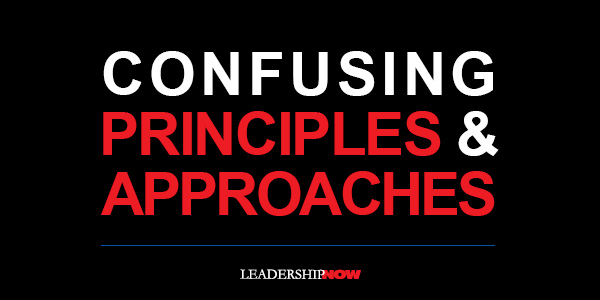
IN How the Mighty Fall, Jim Collins makes a case for why the fall of previously great companies does not negate prior research: The principles in Good to Great were derived primarily from studying specific periods in history when the good-to-great companies showed a substantial transformation into an era of superior performance that lasted fifteen years. The research did not attempt to predict which companies would remain great after their fifteen-year run. Indeed, as this work shows, even the mightiest of companies can self-destruct.Of course, the same is true of the classic by Tom Peters and Bob Waterman, In Search of Excellence. The failure or declining performance of some people and organizations does not negate the basic message. It is part of being human to get ourselves off-course—even when we know better. The failure of the exemplary companies to maintain their hold on greatness or excellence does, however, hold an important lesson for us. It’s all too easy to move away from our core values. They are always under fire and it takes courage to hold the course. Everything we do has to be continually reviewed and realigned to our core values. As you know, knowing the right thing to do and doing it are two different issues. More to the point, doing the right thing once and doing it consistently over time in the face of circumstances that would derail us, is a matter of character. We depart from our core values over time for all kinds of reasons. Doing the right thing doesn’t always give us an immediate payoff in the way we typically gauge success. Doing the right thing is often its own reward. In time, life happens to us and changes our thinking and encourages compromise. Comparing ourselves to others creates doubt. Cynicism is always at the door demanding a hearing and makes sense in a world that rarely works according to plan; a world that is seemingly more irrational than rational. Life changes our friends and they influence us too. All of these circumstances conspire to make us grow or self-destruct. It’s a choice we make every day. This leads us to a cautionary note. In the search for timeless and universal principles that can be applied in any organization, you will frequently find confusion between principles and approaches. Principles are timeless and universal, but approaches are not. Humility is a timeless and universal principle. The Hedgehog Concept is an approach and therefore is not timeless or universal. The approach has been around since recorded time, but is contextual. It will work in some situations and not in others. Approaches change. Principles do not. Principles speak to matters of thinking and behavior that go beyond the moment and to a higher purpose. Approaches are tools. Principles give us meaning. It’s best not to confuse the two. 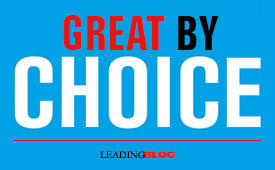 
Posted by Michael McKinney at 09:02 AM
01.15.09

Living Within the Lie
BRITISH economist John Kay wrote in the Financial Times about the power of words to send us off into the wrong direction. More specifically, weasel words. There are some good thoughts here. Here is an excerpt: In western liberal democracies, no one exhibits slogans calling on the workers to unite. But you see similar displays in reception areas of businesses and even in government offices. They urge us to pursue excellence, to delight our customers, to be wholehearted in our embrace of change. Employees place these exhortations on desks and walls with the same resignation as the Czech greengrocer. The modern analogue of the address to the party congress is the business speech, in which tired clichés relentlessly follow each other, to similarly sycophantic applause.
Posted by Michael McKinney at 09:33 AM
10.13.08

Thinking Gray and Free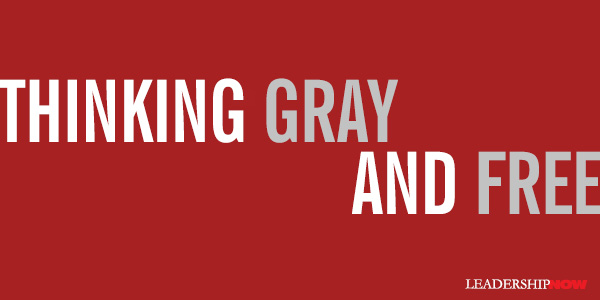
IN The Contrarian's Guide to Leadership, author Steven Sample, shares the idea that leaders think differently. “Leaders are able to maintain their intellectual independence by thinking gray and enhance their intellectual creativity by thinking free.” Leaders have to deal with ambiguities and unknowns. The idea is to learn to think gray while holding firmly to your core ideals. It’s not being binary and instant in your judgments and seeing the nuances to be found in many situations. Free thinking is more than just brainstorming. It’s brainstorming beyond your current reality. What would we do if we had no budgetary constraints, no time restrictions, no personnel problems, no legal restrictions, and no fear of failure? It’s to “contemplate absolutely outrageous and impossible” ideas and solutions. The leader whose thinking is constrained within well-worn ruts, who is completely governed by his established passions and prejudices, who is incapable of thinking either gray or free, and who can’t even appropriate the creative imagination and fresh ideas of those around him, is as anachronistic and ineffective as the dinosaur. He may, by dint of circumstances, remain in power, but his followers would almost certainly be better off without him. 
Posted by Michael McKinney at 08:04 AM
07.23.08

Seeing What No One Else Thought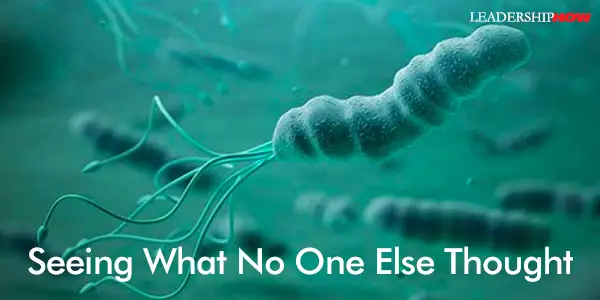
PRESIDENT of Johns Hopkins University, William Brody, delivered a commencement address to Johns Hopkins University earlier this year, where he stresses the importance of examining our premises. He makes his point with this example: People have a tendency to hold tight to wrong ideas, even when there is ample evidence to the contrary. Julius Caesar observed this two thousand years ago, when he wrote that men “willingly believe what they wish.” An example from my own schooling: when I was a medical student, we were taught that ulcers in the stomach were due to too much acid secretion. Ulcers were the result of acids—this was the established dogma. It was a concept that survived, even in the face of contrary evidence. Keep an open mind. He adds, “It’s OK to question ideas and beliefs other people insist are true.”
Posted by Michael McKinney at 08:40 AM
04.23.08

How To Have Just Enough Anxiety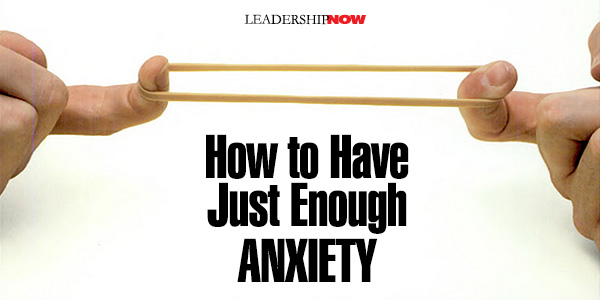
 Balance comes from a right attitude and a proper perspective. Dealing with anxiety is no different. The success of great leaders is all about creating the right level of anxiety for growth and performance. It is their uncommon ability to create just enough tension—within themselves and their organizations—that unleashes the human energy that drives powerful leadership, accelerated growth, and winning companies.What’s wrong with having too much or too little anxiety? RR: Too much anxiety comes from negative thinking. When we feel too much anxiety, we attack change. We become combative or controlling as we try to ease the pain we feel. Too little anxiety is grounded in contentment. When we feel too little anxiety, we avoid change. We value the status quo and believe everything will be okay as long as everything stays the same. If your company is going through tough times like a bad economy or a merger, you definitely don’t want too little anxiety. What exactly is “just enough anxiety”? RR: The right level of anxiety gives individuals and organizations an emotional charge that helps us thrive in an uncertain world. As we allow ourselves to experience anxiety as our natural response to change, and learn to modulate it, we’re able to live in the world as it is instead of struggling to make it what we want it to be. And as we get better at living with just enough anxiety, it becomes the energy that drives us forward, stretches us, and challenges us to be better tomorrow than we are today. How can leaders manage anxiety instead of letting it manage them? RR: It starts with self awareness. Leaders who understand what makes them anxious are better able to increase or decrease their anxiety, as needed to create just enough. But, more than that, it has to do with how they relate to change and uncertainty. By admitting what they can and can’t control, they’re able to take charge of their lives while remaining open to the unexpected. They’re at home in uncharted territory. Instead of seeing anxiety as the enemy, they recognize it as their natural companion on the path of change.    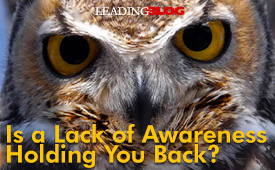
Posted by Michael McKinney at 10:30 AM
01.25.08

Deciding How We Decide
HOW WE COME to decisions has to be as important as the decisions we come to. Changing how we decide may be the fundamental shift we can make in how we—as individuals and organizations—change. It is appropriate to spend some time thinking about it. While a single person may make the final decision, it should always be made in an atmosphere of open listening and sharing. In Why Great Leaders Don’t Take Yes for an Answer, professor Michael Roberto, devotes a chapter to this issue. He begins by showing how John F. Kennedy changed the decision-making process from the tactics employed in the failed Bay of Pigs decision to the better process employed in coming to the successful conclusion of the Cuban Missile Crisis. It demonstrates “how leaders can learn from failures and then change the process of decision that they employ in the future.” It’s an interesting case in demonstrating the importance of deciding how we decide and having the mindset to do so. He discusses four critical choices that affect a leader’s ability to “cultivate constructive conflict and build enduring consensus: First, the leader determines the composition of the decision-making body. The selection should be based on access to expertise, implementation needs, the role of personal confidant, and the effect of demographic differences. Second, they shape the context in which deliberations will take place. What norms and ground rules will govern the discussions? Third, the leader determines how communication will take place among the participants. How will people exchange ideas and information, as well as generate and evaluate alternatives? Structured? Free exchange? Fourth, the leader must determine the extent and manner in which they will control the process and content of the decision. What roll will the leader play? Roberto adds these important cautionary comments about content-centric and process-centric learning: When decision failures occur, many executives focus on the issues involved, and they seek to identify the mistaken judgments and flawed assumptions that they made. However, many leaders do not push further to investigate why they made these errors. Too many of them engage only in content-centric learning. By that, I mean that they search for lessons about how they will make a different decision when faced with a similar business situation in the future.Good material. Check it out. See Also: 
Posted by Michael McKinney at 01:41 PM
12.19.07

How To Avoid Making the Wrong Moves: Think Twice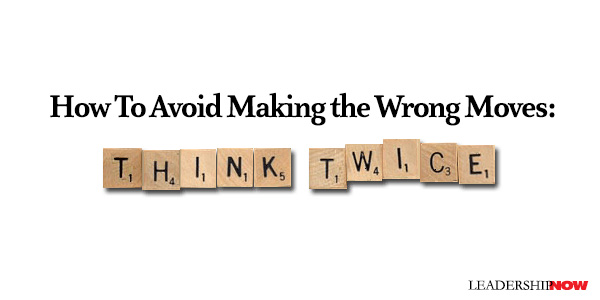
IN their 2008 Investor’s Guide, Fortune magazine offered ten tips to help you “prevent the heat of the moment from melting your better judgment.” The tips form an acronym – Think Twice – and are worth keeping in mind no matter what you’re thinking about.

Posted by Michael McKinney at 08:57 AM
12.07.07

Roger Martin on Assertive Inquiry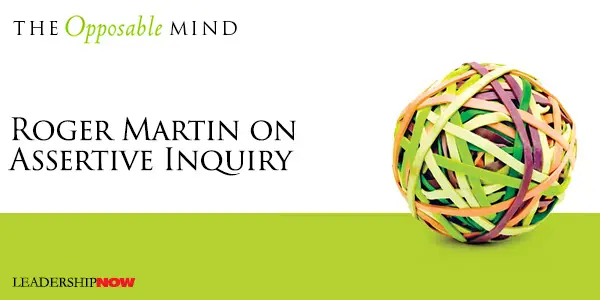 READERS have had some questions about "assertive inquiry" as presented in Roger Martin’s book The Opposable Mind. Here are some explanatory excerpts from the book:
READERS have had some questions about "assertive inquiry" as presented in Roger Martin’s book The Opposable Mind. Here are some explanatory excerpts from the book:
“When we interact with other people on the basis of a particular mental model, we usually try to defend that model against any challenges. Our energy goes into explaining our model to others and defending it from criticism. “The antidote to advocacy is inquiry, which produces meaningful dialogue. When you use assertive inquiry to investigate someone else’s metal model, you find saliencies that wouldn’t have occurred to you and causal relationships you didn’t perceive. You may not want to adopt the mental model as your own, but even the least compelling model can provide clues to saliencies or causal relationships that will generate a creative solution.” Ask:
Not:
Obviously tone is important here. If your attitude is one of really seeking to understand and build bridges, it will come across. Otherwise, it is just another way you’ve picked up to try to argue your point and that will come across too. Martin continues, “Assertive inquiry isn’t a form of challenge, but it is pointed. It explicitly seeks to explore the underpinnings of you own model and that of another person. Its aim is to learn about the salient data and causal maps baked into another person’s model, then use the insight gained to fashion a creative resolution of the conflict between that person’s model and your own.” 
Posted by Michael McKinney at 08:38 AM
11.30.07

How to Develop Integrative Thinking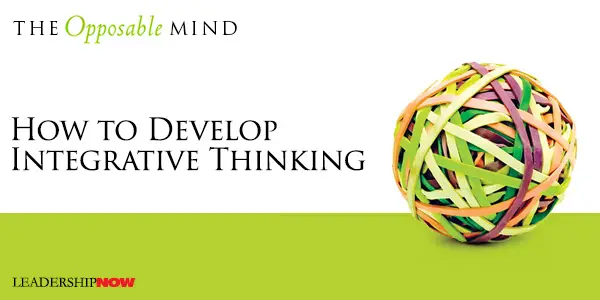
A 2007 study (PDF) conducted by the Center for Creative Leadership found that nearly 92 percent of the executives surveyed believe the challenges their organizations face are more complex than they were just five years ago. Organizations will continually be asked to do even more with less and respond even faster to changes in their industry and economy. Complexity is not going to go away, but developing the skills necessary for integrative thinking as described by Roger Martin in The Opposable Mind (the ability to hold two conflicting ideas in constructive tension) can be an effective way to keep from being sidelined by it. “Integrative thinking is largely a tacit skill in the heads of people who have cultivated, knowingly or otherwise, their opposable minds.” How do we develop integrative thinking? First, we begin by thinking about how we think. Martin writes, “When you refuse to take your thinking for granted, you give yourself the best opportunity to enhance and utilize your opposable mind to its fullest.” By taking a look at your personal knowledge system – how you know what you know – you can get some insight into how you make decisions. Martin has defined three areas, as shown in the diagram below, that guide and inform each other as your experiences grow. Stance: How you see and interact with the world; your philosophy. Martin lists six important ways of looking at the world and self. Tools: Integrative thinkers use generative reasoning (asking what might be instead of what is), causal modeling (considering not only linear and unidirectional relationships but nonlinear and multidirectional relationships as well) and, what I found helpful, assertive inquiry (not argumentative, but pointed questions seeking to find common ground). [Note: There is a great example beginning on page 159 in this regard.] Experiences: Your stance directly affects the kinds of experiences you will accumulate. Structured repetition of a consistent type of experiences develops mastery. Combined with originality, mastery will help you to grow. 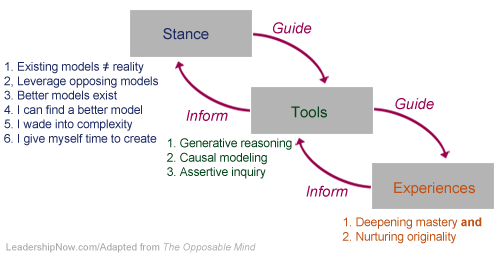 With an understanding of how these areas interact with each other, you can, over time, take an active role in crafting your personal knowledge system. Martin has packed into a short book, a good primer on developing a mind that can grapple with complex issues and find creative solutions that would otherwise be missed. It’s well worth your time. 
Posted by Michael McKinney at 12:08 AM
11.28.07

Integrative Thinking: The Opposable Mind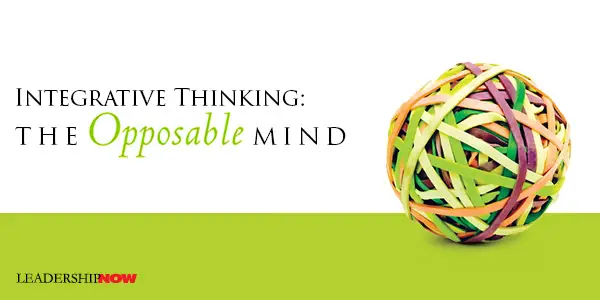 NOT ONE to put the cart before the horse, Roger Martin understands the importance of doing but he prefers “to swim upstream to the antecedent of doing: thinking.” He writes in The Opposable Mind, “My critical question is not what various leaders did, but how their cognitive processes produced their actions.”
NOT ONE to put the cart before the horse, Roger Martin understands the importance of doing but he prefers “to swim upstream to the antecedent of doing: thinking.” He writes in The Opposable Mind, “My critical question is not what various leaders did, but how their cognitive processes produced their actions.”
In examining how exemplary leaders think, he found an approach that was common to many, that he has termed integrative thinking. Integrative thinking is: The ability to face constructively the tension of opposing ideas and, instead of choosing one at the expense of the other, generate a creative resolution of the tension in the form of a new idea that contains elements of the opposing ideas but is superior to each. In other words, integrative thinking examines problems as a whole, taking note of the complexities that exist and embrace the tension between opposing ideas to create new alternatives that take advantage of many possible solutions.
It’s easy to get into the destructive rut of thinking that money is the solution to most problems. School boards are notorious for claiming that their hands are tied because they lack the money they want. They cripple themselves. What they really need are creative solutions. Education is a complex issue and has for too long been subject to tunnel-vision problem-solving. They need integrative thinking. Einstein opined that we should make everything as simple as possible, but no simpler. Too often we try to make complex issues too simple and leave ourselves with too few options based on our limited point-of-view. If we instead embrace complexity and learn to deal with it, we might find more and better solutions. Martin writes, “More salient features make for a messier problem. But integrative thinkers don’t mind the mess. In fact, they welcome it because the mess assures them that they haven’t edited out features necessary to the contemplation of the problem as a whole. They welcome complexity because they know the best answers arise from complexity.” In The Opposable Mind, Martin clearly illustrates this thinking process in action by dissecting varied examples from both business and interpersonal situations. Martin claims that we are all born with an opposable mind—the ability to hold two conflicting ideas or models in constructive tension. “We can use that tension to think our way through to a new and superior idea….Opposing models, in fact, are the richest source of new insight into a problem. We learn nothing from someone who sees the problem exactly as we do.” 
Posted by Michael McKinney at 09:45 AM
10.29.07

How To Get Great Ideas: Lessons for Brainstorming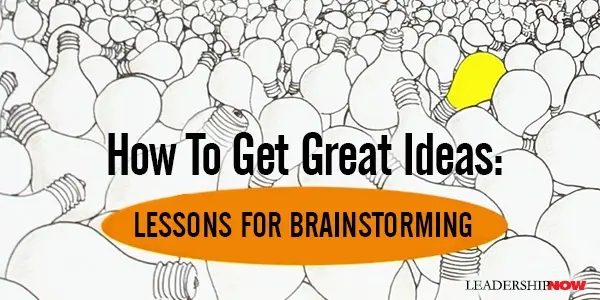
IN 1941, advertising man Alex Osborn (BBDO) came up with the idea of “Thinking Up” which was later changed to brainstorming by his “thinking-up” colleagues. In an excellent book about innovative and productive thinking simply titled, Think Better, author Tim Hurson reviews Osborn’s list of four essential rules for effective brainstorming:
Hurson notes that studies have shown that the last third of a brainstorming session usually results in the best ideas. He calls it the miracle of the third third. “You’ll have a greater chance of coming up with that one brilliant idea if you get all the way to the third third than you will if you stop at the first “right” idea.” He writes: The first third of the session tends to produce mundane, every-one-has-thought-of-them-before ideas. These are the early thoughts that lie very close to the surface of our consciousness. They tend not to be new ideas at all but recollections of old ideas we’ve heard elsewhere. They are essentially reproductive thoughts. He says, “Brainstorming is like cholesterol—there’s good and bad, and most people have only experienced the bad.” We have all experienced brainstorming like this: There’s no separation of the different ideas of thinking going on. Creative, idea-generating thinking is being stopped cold by critical, judgmental think. Ideas are being killed before they’re fully articulated. He adds, that “Bad brainstorming is binary; ideas are either good or bad. Good brainstorming is full of maybes." The biggest issue we face in creative thinking is our own patterns of thought that keep us on the straight and narrow. We hold ourselves back because of personal notions of what is right and wrong and what will and won’t work. There’s no magic pill to conquer this. It takes a conscious effort. He suggests though that “Generating long lists of ideas flushes those early ideas out of your head so you can make room for new ones.” Tim Hurson is a founding partner of thinkx intellectual capital. It is a global consultancy for productive thinking and innovation. 
Posted by Michael McKinney at 10:53 AM
08.03.07

Neuroscience Enlightens Leadership: An Interview with David Rock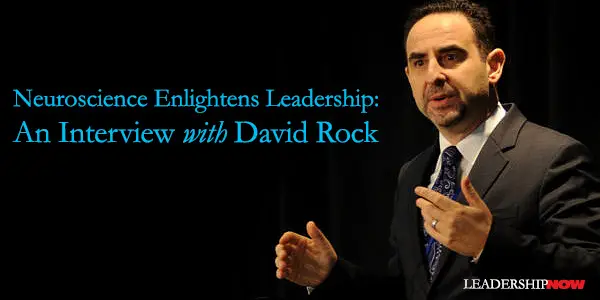
AS research into the mind develops, we will see it being applied to more and more areas of human behavior. Most recently, international business consultant David Rock applied it to the art of leadership and coined the term neuroleadership. Neuroleadership uses neuroscience to inform the art of leadership. Some have confused it with some sort of science fiction brain research that attempts to recreate the perfect leader’s mind. Combining an art with a science has its limitations. There is the idea that when applying a science to the study of any area, including leadership, one can make it as mechanical as possible. This is rarely the case. There are no shortcuts to leadership, but there is the hope that neuroscience can enlighten our understanding and add substantially to the form of best practices in leading people. We talked to David Rock to try to gain a little insight into this new field of study. LeadingBlog: To begin, what is neuroleadership? David Rock: Neuroleadership is the study of leadership through the lens of neuroscience. Neuroleadership explores central elements of leadership such as self-awareness, awareness of others, insight, decision making, and influencing, and applies what we are learning about the brain in these instances, thus building a neurological theory base for the “soft skills.” The field is not attempting to measure leaders' brain waves to find the “secret” of great leaders.
David Rock: Correct. It's more like scientists running around saying, 'what is going on in the brain when someone solves a complex problem through insight, and how can we, therefore, increase leaders' abilities to have or facilitate insights'. As we better understand the mechanisms involved in everyday leadership activities, better leaders may emerge, but it won't be through brain transplants or the direct use of technology. The technology, like EEG and fMRI, is there to test theories. LeadingBlog: What brought you to connect the two fields of study – neuroscience and leadership? David Rock: David Rock: I was personally trying to find the best science to explain the art of influencing people. “Getting people to do what you want” is still the hardest question for many people in business. I spent several years on this question, reading, writing, and teaching in this area. At one point, it became very clear that neuroscience provided the most coherent and complete explanation for what goes on when we try to drive change. I ended up writing a book on this (Quiet Leadership), then a paper (The Neuroscience of Leadership), both of which became popular. The NeuroLeadership Summit in Italy in May this year was the first test to see if there was really a field emerging here or just a few of us with this crazy idea. Based on the global response to the Summit it's clear that many people are hungry to bring more science into leadership development, specifically a “hard” science like neuroscience. LeadingBlog: What can we expect from neuroleadership? David Rock: Bear in mind it's early days, so expect it to take a few years for major findings to emerge. However, you can expect to see business schools globally building neuroscience into leadership programs; books written on various aspects of the field; science that explains how to be better at influencing, leading, training, learning. To start with, we need to do a lot of work at the level of one-to-one leadership, and as this theory base grows it will become more about the systemic application of the research. We will see research on every aspect of leadership, including change, engagement, incentive, feedback, presence, trust, teams, etc. LeadingBlog: Self-awareness is critical to leadership. The lack of it explains why we go off on tangents and end up with consequences we never intended. What is self-awareness from a neuroleadership perspective? David Rock: That's one of the main focuses of the field, understanding self-awareness in a new way. There is some excellent neuroscience being done on “active” versus “passive” brain processes. Active processes are ones which we are aware of; passive occur beneath conscious awareness. We need both, as passive processes are far more efficient, active processes work in serial and are very tiring. The neuroscience is showing that the concept of observing your own thoughts is central to our ability to choose between active and passive. Coined “the impartial spectator” by Adam Smith, without this ability, we are always to some degree on automatic. There is a specific part of the brain that lights up when we choose to step outside the flow of experience and observe behaviors and make a choice. So self awareness is not a soft concept, it has very real correlates in the brain, and it has an impact on how data is experienced and interacted with. There's a LOT more to say about this, of course. LeadingBlog: If I have been hardwired a certain way, can I change it? David Rock: Yes, we do all the time. The key is the brain only really goes forward; you can't go backward. You can't get rid of wiring you don't like. You can only create new wiring. That's because the process involved in change in any way requires attention - requires focusing your attention - and attention changes the brain. Attention creates or embeds circuits focused on. So we can change, but we need to learn to put our attention on new circuits not the old ones. That's often hard as old circuits are easier to bring attention to—there are lots of them—than newer more subtle circuits. It's like trying to find a car, versus a needle, in a haystack. LeadingBlog: Some don't come to self-awareness naturally. Is there a physical reason for it or is that strictly a function of environment and experience? David Rock: Some people haven't given it much attention, so their circuits aren't well developed. Others might be born with weaker circuits between emotions and words, which is a medical condition. There is very much a part of the brain that becomes active when we focus our mind on inhibiting mental signals; it's under the right temple in the brain. LeadingBlog: Can it be developed or improved? David Rock: We can improve self-awareness the same way we can improve our ability to speak a language, play tennis or learn PowerPoint. We need to pay attention, and activate the relevant circuits regularly. The good news is small regular efforts can do a lot: it’s the same way we quickly learn to do something even more complex, like learning to drive. LeadingBlog: From time to time, there is that moment when we "get it." There’s a breakthrough or a flash of insight. It is a moment when we experience a leap in learning. What can neuroleadership tell us about what is happening? David Rock: There are some great studies now on insight. We know that insight occurs when the brain goes quiet for a moment. We know that insight is a very important moment in the brain; it packs an energetic punch, and represents possible long-term changes in circuitry. Often we get an insight moment at surprising times, when we're doing other things. That's because the part of the brain we use actively, can drown out the signals from the rest of the brain. We know that anxiety decreases the likelihood of insight, and happiness and positive affect generally increases the chance of insight. LeadingBlog: How would this affect how we work with or teach others? David Rock: In so many ways! For example, when we start to value insight as the moment at the heart of change, we start to create ways of facilitating it. The great thing about the energy of insight, which is partly adrenaline, is that it drives people to take action. Insight engages people, it makes people get up out of their chairs literally and want to drive change. This is one important lesson from the science: insight is not helpful to long-term change, it's central to long-term change. But each person needs to have their own insight, not just listen to their leader's insight. LeadingBlog: Some of mankind’s biggest achievements have come by the rearranging of the old in a new way or seeing old concepts in new ways. It would seem that is what you are doing here. David Rock: Indeed. One of the best feelings in the world is when we see an existing situation in a completely new light. Making new connections between unexpected elements turns out to be a wonderful way of generating positive feelings in the brain too. It's what we do when we do a crossword puzzle, read a book or watch a movie. Neuroleadership is about helping leaders understand how their own and their people's minds and brains ACTUALLY work, replacing our current guesswork. Humans have a long history of incorrect assumptions about the world. We think for example, that rewards motivate people. Actually, it is anticipation of a reward that motivates, the reward itself does little. And the anticipation is closely linked to attention. We think that punishment drives change. Actually punishment or the threat of it focuses attention, and it’s attention that drives change. However, punishment can send attention to some less than helpful places too. So if we know that attention changes the brain, let's get better at understanding attention, instead of focusing so much on reward or punishment. When you look at attention, you see that it's very closely tied to our social world, then you begin to see just how much of an impact human beings have on each others' attention, whether we like it or not. So this is perhaps a whole new area to explore, which might have greater benefits than only studying the carrot and stick. And all this just comes from seeing that attention is the active ingredient in change. My point is, having a new frame of reference, as well as feeling good, may be more useful than we realize at first. LeadingBlog: The result of bringing these disciplines together is for leaders to gain insight on how to best help others to think better - for themselves. This would seem to be quite significant. David Rock: Leaders have established their own, often non-articulated, scientific theories for how people work. The science will help build leaders more accurate understandings of how we work, so we can become more effective at leading. Leaders are, after all by nature rational beings, and so they should be. This field provides a rational science to explain many things that are not being given enough attention in the workplace. By speaking to leaders and organizations about human issues, in the language that they are used to, we can hopefully improve how workplaces function. 
Posted by Michael McKinney at 09:10 AM
07.20.07

Neuroleadership and You
 There is the hope that when applying a science to leadership, one can make it as mechanical as possible. Neither benefits when this is the goal. If we want the science to bring us laboratory results that we can apply in the real world, we will be disappointed. I would agree with Warren Bennis, quoted in the article as saying, "It's full of possibilities. What worries me is people being taken in by the language of it and ending up with stuff we've known all along." It’s worrisome, too, that we live in a time when some people will not accept common sense unless there are numbers behind it or a scientific study proving it beyond all doubt. There are those also who cannot find value until they have spent enormous sums of money on it. For them, the combination of science and leadership is priceless. The problem with rushing to apply a science to any field is that passion often overrides experience; we tend to throw out conventional wisdom and common sense in favor of the new. In the excitement, we begin to look for absolutes where there are none and never will be. Comparing brain waves of leaders—moral/immoral, successful/unsuccessful—to create a kind of yardstick or means of selection is off the mark and beyond the scope or intent of neuroleadership. If we are looking for it to replace intuition, judgment and thought, we are mistaken. If we want to say, “This is a good brainwave for leaders, and this is a bad brainwave,” we don’t understand the human spirit. I wouldn’t expect neuroleadership to provide all kinds of new ideas. It will look at old ideas in a new way. This is often the key to finally bringing us the depth of understanding necessary to adapt ideas to a specific situation. What neuroleadership can do is reframe ideas in terms of how the mind works. Specifically, how we learn, retrieve memories, experience and interpret our world. This will provide guidance to best practices. It will reinforce some practices based on solid neuroscientific research. Conversely, it will provide sound reasons why some approaches feel forced or don’t work at all. If they go against the way the brain is wired, we are just spinning our wheels. Good to know. Leadership is not a science, and scientific methods applied to it will never make it one. But, if neuroleadership will help us understand why we make the connections the way we do, if it will show us why we need to allow people to think and learn in ways that are best suited for them, as opposed to forcing people to all think in the same manner, if it will help us to improve and leverage our own and other people’s thinking, then it will have done a big service. I look forward to what we will find in this exciting new combination.
Posted by Michael McKinney at 06:57 AM
04.21.07

Fast Company Interview with Sir James Dyson
THE discussions on Appreciative Intelligence and Charles Pellerin’s views on the social leadership aspects of project management, parallel a good short interview in the May issue of Fast Company with Sir James Dyson. Here are a couple of his comments: FC: You once described the inventor's life as "one of failure." How so?
Posted by Michael McKinney at 11:13 PM
04.20.07

Charles Pellerin on Project Management
APPRECIATIVE INTELLIGENCE—the ability to perceive the positive inherent generative potential within the present—is an important component to develop as part of organizational culture. AI contributes to a high incidence of innovation and creativity and the potential development of previously unnoticed strengths in people. This happens by the actions of leaders at all levels, to encourage people to look at everyday issues—the commonplace—in a new way; by telling a new story. 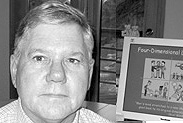 Can you explain what you mean by "social issues," and how they relate to leadership? This would help to explain the recent experiment reported in the Washington Post by Gene Weingarten to discover if violinist Josh Bell—and his Stradivarius—could stop busy commuters in their tracks. Surprisingly, he did not. If our story is to ignore street musicians and includes the belief that no famous musician would ever do it, then we will ignore street musicians and we will not scan the streets looking for our favorite artists. (If you haven’t read it yet, do so. It’s a great story.) Pellerin has been developing since his retirement from NASA in 1995, a leadership/culture assessment and learning system called "Four-Dimensional (4-D) Leadership." He states, “We began with workshops, and then added coaching, and now have Web-based diagnostics customized for NASA projects. Simply put, we make three measurements in each of the social dimensions -- directing, visioning, relating and valuing—that we believe are fundamental to effective leadership and efficient cultures. “I truly believe that we can identify and address the root cause of most project difficulties. That's my story. And many of the projects I'm working with are choosing to run that story as well -- because they see results. You know, no story is "good" or "bad." Some just get you the results you want and some don't.”
Posted by Michael McKinney at 07:21 AM
04.19.07

Appreciative Intelligence
IN April 1990, shuttle Discovery launched the Hubble Space Telescope into its planned orbit. However, within weeks it became obvious that there was a serious problem with the primary mirror. Authors Tojo Thatchenkery and Carol Metzker describe the events that followed in their book Appreciative Intelligence: Seeing the Mighty Oak in the Acorn. Congress demanded an explanation for the failure. The project and its creators became the butt of late-night television jokes. Stress was high among NASA engineers, as were health problems. “It was traumatic,” said Charlie Pellerin, the former director of NASA’s astrophysics division, who oversaw the launch of the Hubble. Nobody could see how to fix the problem, which many seemed afraid even to address. Appreciative Intelligence is defined as “the ability to perceive the positive inherent generative potential within the present.” More simply, it is “the ability to see the mighty oak in the acorn. It is the ability to reframe a given situation (or person), to appreciate its positive aspects, and to see how the future unfolds from the generative aspects of the current situation.” These three characteristics form the foundation of appreciative intelligence. Reframing is about shifting reality by choosing what feedback we will ignore and what feedback we will pay attention to. Appreciating the positive is the ability to see the positive aspects of any given situation. To see how the future unfolds from the present refers to the ability to see what can be done instead of what can’t. Appreciative intelligence is the mindset that allows you to step back and access the situation and move forward instead of being thwarted by circumstances. Appreciative intelligence can, of course, be developed by consciously expanding your responses to situations as they occur. Asking yourself different questions by questioning your assumptions (what you know to be right), looking for positive and different meaning in what you experience, and becoming what Saul Bellow calls a first-class noticer, will help you improve your appreciative intelligence.Additionally, keep in mind the AI qualities of persistence, conviction that your actions matter, tolerance for uncertainty, and irrepressible resilience. As these qualities develop, so too will your creativity and success in finding a resolution to the issues you face. Appreciative Intelligence: Seeing the Mighty Oak in the Acorn provides in more detail what I have outlined here.
Additional Interest:

Posted by Michael McKinney at 07:42 AM
04.12.07

The NeuroLeadership Summit and Why It Matters to Executives
The First Global NeuroLeadership Summit is about a month away. The organizers have decided to film the Summit. This will allow the filming of several important neuroscientists—such as Matt Lieberman, Stellan Ohlsson and Kevin Ochsner—who are important to the field but are unable to attend the Summit. This film will be available online after the Summit. The Summit will focus on the latest discoveries in neuroscience and how those discoveries can be used to help organizations:
A new article, Why Neuroscience Matters to Executives by David Rock and Jeffrey Schwartz is available on the strategy+business web site. Here are a few key thoughts from that article: The study of neuroscience has provided us with a deeper understanding of why people find change so unsettling....The more we understand the phenomenon of change, the more effectively we can manage it. Neuroscience shows us why some common practices work well, such as allowing people to take ownership of a new initiative. It also explains why some don’t succeed. For example, using threats or incentives to implement organizational change is rarely sustainable.
Posted by Michael McKinney at 12:12 AM
02.16.07

In Difference Lies the Potential to Contribute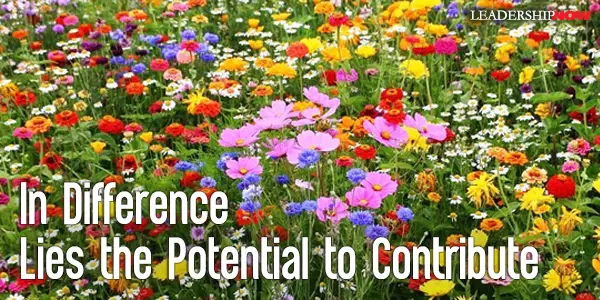 WE tend to think that if we get the smartest people all together in one room, we will get the best solutions. In a very readable book, The Difference, Scott Page shows that in fact diversity in thinking and perspective produces more and better solutions and contributes to overall productivity. He maintains that “when confronted with a difficult task, be it solving a problem, predicting the future, or making a choice, we benefit by including diverse people.” Value can be added just by virtue of its being different. How many disciplines have benefited from interdisciplinary approaches? Diversity doesn’t necessarily mean black/white or men/women, but diversity in thinking and perspective. He notes that “cognitive diversity increases innovation. Preference diversity leads to squabbles.” So we’re looking for relevant diversity and informed intelligence. 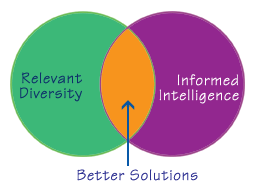 The trap we fall into is that we prefer to continue to work with and consult people who think like us—people with the same general background and types of experiences. The familiarity is more comfortable and seems right to us. In the end, we get the same way of looking at things and we bring the same kinds of tools to the table to tackle our problems. We miss important clues. If one of us gets stuck, then we all get stuck. “People who think alike get stuck.” We also create barriers to innovation and radically new ideas. A preference for working with people who bring the same formal perspectives to bear on a problem leads to segregation by function in firms and by discipline in the academy. In each case, the tendency to interact only with people like us creates the same micro-level dynamic. Each culture in a society, each identity group in a city, each department in a university, and each functional area of a firm ends up building walls around itself. As these walls become higher, the members of each group—be they Evangelicals, African Americans, chemists, or accountants—find themselves inside silos of their own creation. He suggests that we should not only get more kinds of people involved in tackling the issues, we should also encourage our people to think differently by giving them time to pursue individual projects that interest them (varied experience) and by creating skunk works type groups within the organization. He observes, “as individuals, we can accomplish only so much. We’re limited in our abilities. Our heads contain only so many neurons and axons. Collectively, we face no such constraint. We possess an incredible capacity to think differently. These differences can provide the seeds of innovation, progress, and understanding.” 
Posted by Michael McKinney at 08:56 AM
01.18.07

The First Global NeuroLeadership Summit The First Global NeuroLeadership Summit is taking place May 14-16 in Asolo, Italy. What is NeuroLeadership? NeuroLeadership is a term coined in 2006 by David Rock and Dr. Jeffrey Schwartz. It is the integration of neuroscience into the business world. The Summit is the brainchild of David Rock, an international leadership consultant and author of Quiet Leadership (a best book of 2006 selection), who together with neuroscientist Dr Jeffrey Schwartz is bringing together the speakers and the program. For three days, world-renowned experts in both neuroscience and leadership will gather with a select group of 40 guests, on top of a mountain in spectacular Northern Italy. Together they will explore some of today’s biggest workplace challenges through the eyes of a neuroscientist, and build the framework for a new domain of knowledge: NeuroLeadership. You can find their ongoing events and conferences here: NeuroLeadership Learning Events
Posted by Michael McKinney at 08:35 AM
10.25.06

Neurogenesis: Environment Matters to the Brain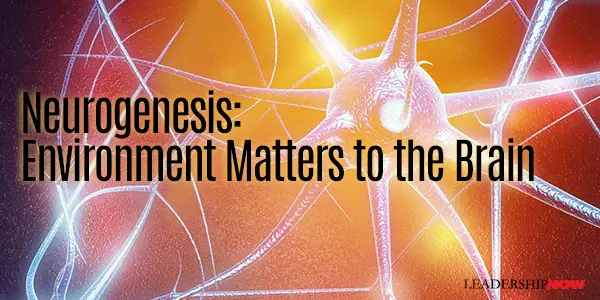
ELIZABETH GOULD's research in neurogenesis—the process of creating new brain cells—is adding to our understanding of how our environment directly affects the quality of our thinking. A professor of psychology at Princeton University, she is changing our understanding of the production of new neurons and the plasticity of the brain.  The brain is a remarkably pliable organ that is greatly influenced by our surroundings. In chronically boring environments or stressful conditions, the structure of the brain is altered. Brain cells starve and retreat and new cells are not created. Yet remarkably, the brain can also heal itself. When the environmental conditions are enriched the brain begins to create new brain cells and the density of neuronal dendrites (the branches that connect one neuron to another). It would seem design—in all its various forms—matters. In an article in Seed magazine, writer Jonah Lehrer reports on Gould’s research: The subject of stress has been the single continuous thread running through Gould’s research career. From the brain’s perspective, stress is primarily signaled by an increase in the bloodstream of a class of steroid called glucocorticoids, which put the body on a heightened state of alert. But glucocorticoids can have one nasty side-effect: They are toxic for the brain. When stress becomes chronic, neurons stop investing in themselves. Neurogenesis ceases. Dendrites disappear. The hippocampus, a part of the brain essential for learning and memory, begins withering away. The research should give us pause to consider the environment we function in and the environment we create for others to perform in.
Posted by Michael McKinney at 09:00 AM
06.05.06

Three Theories Are Better Than One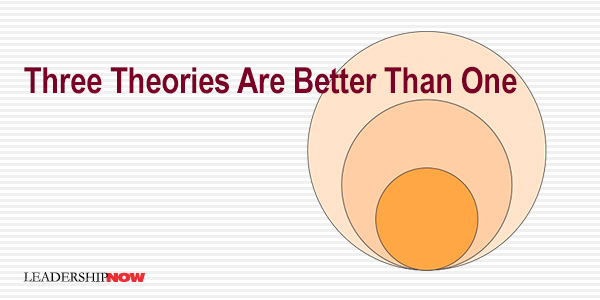
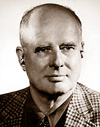 You can, of course, take this too far and get caught up in all sorts of mind games and become mired in overanalyzing. This generally isn’t our problem, however. We tend to jump to generalizations and oversimplifications without a clear understanding of reality, thus repeating the same old thinking. We need to cast a wider net, asking more and different questions. We need to keep a balance. Concerning theories, Perry thought it was worth noting: “The wisdom doesn't come from the theories; the theories come from the wisdom. And the wisdom comes from the defeat of all the more attractive alternatives.” And in a cautionary tone, “With all these theories, it would be a good thing, of course, to keep an open mind. But the problem with an open mind is that it's so drafty.”
Posted by Michael McKinney at 06:00 AM
06.01.06

Problem Solving with a Design Attitude
PROFESSORS Richard Boland and Fred Collopy from the Case Western Reserve University’s Weatherland School of Management had the opportunity to work with Frank O. Gehry on the management schools new building. The design process exposed them a problem solving approach they call a design attitude. 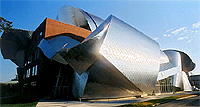 We believe that if managers adopted a design attitude, the world of business would be different and better. Managers would approach problems with a sensibility that swept in the broadest array of influences to shape inspiring and energizing designs for products, services, and processes that are both profitable and humanly satisfying. Working with Gehry has led them to see “how both management practice and education have allowed a limited and narrow vocabulary of decision making to drive an expansive and embracing vocabulary of design out of circulation. In our focus on teaching students advanced analytical techniques for choosing among alternatives, our attention to strengthening their design skills for shaping new alternatives has withered.” The most dominate approach we see today they call the decision attitude. This approach uses mathematical and scientific approaches—economic analysis, risk assessment, multiple criteria decision making, simulation, and the time value of money—to choose among alternatives. “It starts with the assumption that the alternative courses of action are ready at hand—that there is a good set of options already available, or at least readily obtainable. “ The design attitude on the other hand assumes the best alternative may have to be invented. Design thinking doesn’t mean bringing more creativity to bear. “Creativity itself is not going to bring us to the organizational, product, or process innovations we require. Creativity needs the guiding energy of a design attitude in order to focus our efforts on results that will be truly innovative and produce long-lasting organizational betterments.” Design is in that sense larger than creativity. Design provides a context for creativity by channeling it toward humanly satisfying purposes, and that is why we cannot allow calls for increased creativity and techniques for enhancing creativity to take the place of increased attention to s design attitude in management practice and education. The illustration below from The Central Office of Design adds a graphic explaination of design thinking.
They explain on their web site that they "start each project assuming nothing, especially about what the solution to the problem might be, and embark on the process with empathy for the final consumer of the solution. Whether it be an employee, child, or mother of three."
Posted by Michael McKinney at 12:36 AM
05.17.06

Attitude of Wisdom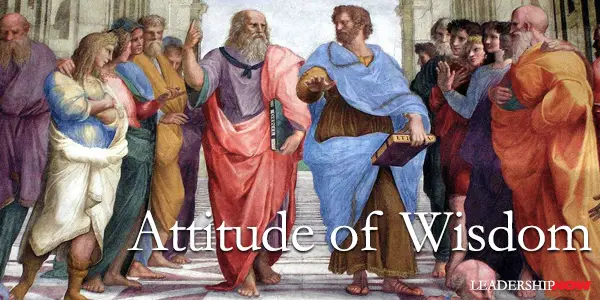
AMERICAN essayist Norman Cousins wrote, “Wisdom consists of the anticipation of consequences.” Wisdom is about the thinking through of thoughts, behaviors and actions and seeing their relationships. It is seeing how things are connected. It is easy to get so caught up in what we are doing that we operate as though we are in a vacuum. Yale University professor Robert Sternberg explained that one reason smart people are sometimes inexplicably stupid is that they think they have overcome the problem of consequences. Understanding how everything is connected is a daunting task, but it shouldn’t cause us to stop dead in our tracks full of indecision. We still have to function. Professors Pfeffer and Sutton suggest in their book Hard Facts, that we must travel through life with an attitude of wisdom. That attitude is described as the ability to act with knowledge while doubting what you know. They point out that this attitude or approach is the single most important quality that a leader, advisor, or team can have for practicing evidence-based management. This attitude enables people to act on what they already know while at the same time doubting what they know. It means they can do things now, as well as keep learning along the way. It implies a certain degree of humility to make it work. You really have to be able to get out of your own way. Professor Karl Weick said, “Argue like you’re right, but listen as if you’re wrong.” From Hard Facts: Practicing evidence-based management means adopting beliefs and designing settings that enable people to keep acting with knowledge while doubting what they know, and to openly acknowledge the imperfections in even their best ideas along the way. A lot of experience often holds people back from adapting this attitude. An old example holds true here: A person may say, “I have 20 years of experience.” But it’s not 20 years of experience. It’s 1 year repeated 20 times. That is to say, we live our lives in such a way that we aren’t really learning. We’re repeating. While wisdom requires that we arrange what we observe and know, and create meaning from it, it also requires that we consider what we need to unlearn as well.
Posted by Michael McKinney at 12:27 AM
05.12.06

Asset-Based Thinking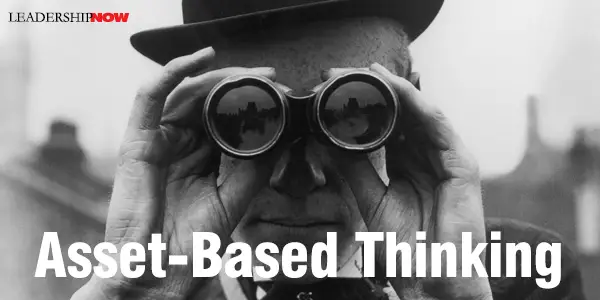
DOUGLAS RUSHKOFF wrote, "Instead of focusing on what we still lack, we must take stock of what we already do have in terms of resources, abilities, and pure will." This is the essence of asset-based thinking. It's not to be confused with the head-in-the-sand everything-is-wonderful way of thinking. That's the other ditch of typical one-dimensional thinking. It’s not about finding everything that’s wonderful around you to create a false sense of euphoria. It’s about asking, “What are the assets here?” What is working?” and how can I use these things — how can I leverage these things — to reach my goals. What is being encouraged here is reality-based multidimensional thinking. It demonstrates that there is another way of thinking about or looking at most every situation. Through brilliant design (as shown below), Change the Way You See Everything illuminates these concepts. Authors Kathryn Cramer (psychologist) and Hank Wasiak (advertising) ask you to image the seismic shift that would occur if people just focused their attention on opportunities rather than problems, strengths more than weaknesses and what can be done instead of what can't. When you decrease your focus on what is wrong (deficit-based thinking) and increase your focus on what is right (Asset-Based Thinking), you build enthusiasm and energy, strengthen relationships, and move people and productivity to the next level. We all need this book. Despite the fact that this is a simple — yet life-changing concept — it doesn't make it any easier to execute these ideas in our lives or organizations. Unfortunately, the fact is our default setting is toward deficit-based thinking. We gravitate towards the negative, towards what’s not working. This mode of thinking and viewing the world holds us back. Deficit-based thinking is driven by fear. Asset-based thinking is driven by desire.
This is an important book. It is both mentally and emotionally engaging. Get this book for yourself and anyone you care about. Asset-based thinking is the foundational step that you need to put into place in order to build a success system that has a sense of personal responsibility, creativity and resilience.

Posted by Michael McKinney at 01:11 AM
05.01.06

Appraising Business Ideas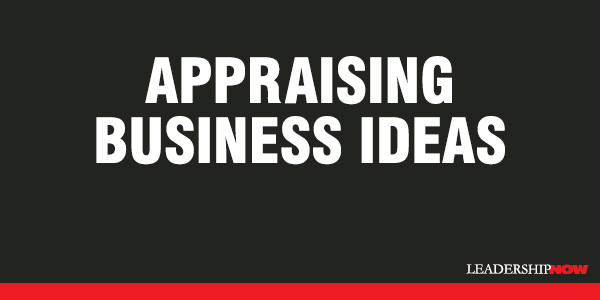
WE don’t know what we don’t know, so we have to proceed with our minds open and be willing to modify what we think we know in the face of credible data. How do we know when we have come across credible data? In the Stanford Social Innovation Review, Hard Facts authors Jeffrey Pfeffer and Robert Sutton, presented some rules to keep in mind when evaluating or developing business ideas:

Posted by Michael McKinney at 12:00 AM
04.26.06

Evidence-Based Management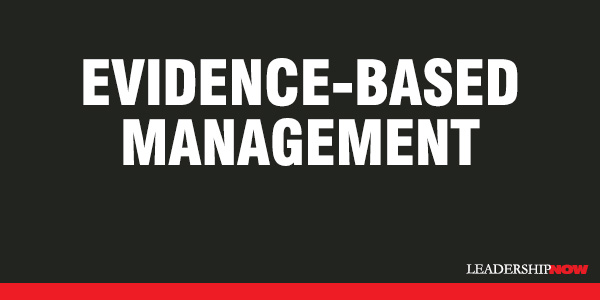
OBSERVING that if doctors practiced medicine the way many companies practice management, there would be far more sick and dead patients, and many more doctors would be in jail, professors Jeffrey Pfeffer and Robert Sutton Evidence-based management is really a way of thinking and looking at the world. The mindset rests on two disciplines: "first, willingness to put aside belief and conventional wisdom—the dangerous half-truths that many embrace—and instead hear and act on the facts; second, an unrelenting commitment to gather the facts and information necessary to make more informed and intelligent decisions, and to keep pace with new evidence and use the new facts to update practices." Some specific half-truths discussed in the book: The best organizations have the best people; financial incentives drive company performance; change or die; great leaders are in control of their companies. Instead of following half-truths, Pfeffer and Sutton endorse principles such as: Treat your organization as an unfinished prototype; see yourself and your organization as outsiders do; power, prestige, and performance make you stubborn, stupid, and resistant to valid evidence; evidence-based management is not just for senior executives; and ask the best diagnostic question: What happens when people fail? 
Posted by Michael McKinney at 12:05 AM
04.07.06

Three Levels of Thinking: Moving Toward Maturity
IN The Power of Purpose, Peter Temes defines three levels of thinking: Level One: The most important question for understanding the world and taking action is How do I feel? Or How do I look to myself? Who am I? Level Two: You progress to How do others feel about me? Or How do I look to others? Who do others think I am? Level Three: At this level, the central question is not about how I feel, or how others feel about me, but about how they feel about themselves. The basis of this level is not about what matters to me, but what matters to others. How can I help others? He suggests, “Develop the habit of asking level-three questions. Look hard at he clues other people give you about their personal goals and the ways they see themselves. Look for opportunities to help others feel stronger and more successful and you’ll see that you will gain as much as or more than others do. When you get past the zero-sum-game model of how the world works—the idea that for me to win someone else must lose—you begin to see the enormous power that comes from sharing your strength with others. That insight, and the moral strength that comes from helping others, are the greatest gifts you can give yourself, and they mark the clearest path to success.”

Posted by Michael McKinney at 09:12 AM
03.30.06

Learning to See and Gaining Context
R AM CHARAN (author of Confronting Reality) wrote an insightful article for strategy+business entitled Sharpening Your Business Acumen. In the article he describes a process to see the big picture in an uncertain world: Leaders have to be comfortable making decisions with unknown factors; survival depends on those choices producing viable outcomes whatever may happen. He writes that working through these six questions will help executives assess the validity of the company’s moneymaking approach. It is an iterative process that tests the leaders’ mental abilities to qualitatively see how the world is changing — almost always including the perspectives of others. It requires transcending the old rules of thumb that are etched deep in the psyches of many executives, and it means giving up the habitual reliance on precedent that worked for many companies during times of more linear change. But the ability to perceive trends quickly, or even to make sense of them, will not automatically guarantee success. Rather, success depends on the rigor and discipline applied to the entire process of envisioning the changes, deducing specific actions, and implementing the plan.
Posted by Michael McKinney at 09:29 AM
|
BUILD YOUR KNOWLEDGE
 

How to Do Your Start-Up Right STRAIGHT TALK FOR START-UPS 
Grow Your Leadership Skills NEW AND UPCOMING LEADERSHIP BOOKS 
Leadership Minute BITE-SIZE CONCEPTS YOU CAN CHEW ON 
Classic Leadership Books BOOKS TO READ BEFORE YOU LEAD |
| |||||||||||||||||||||||||||||||||||||||||||||||||